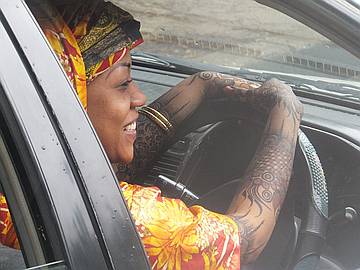
The Olympus of style is still held by the magic of original ornaments, bright colors, animal prints, fantastic accessories and massive adornments.
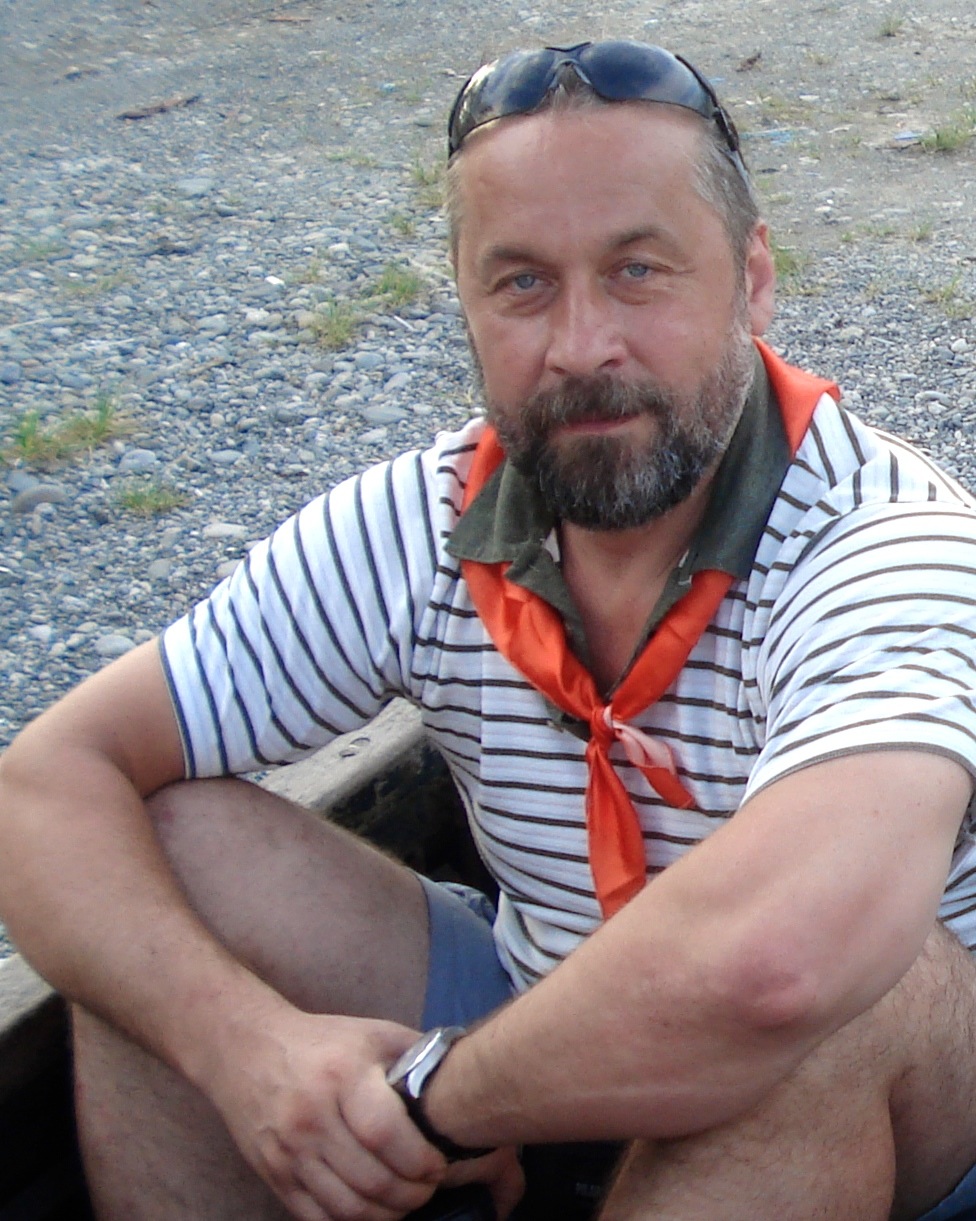
Social maturity is a good fortune! It followed us refraining from the conflicts inevitable in such situations and every morning opening its arms to one another.
Professor A.G. Teslinov, organizer of the expedition Live Parallel 2013 to Papua
To read and watch the previously published material:
One of the cities obligatory for visiting on the way to the Papuans – Jakarta
New York is the city of contrasts! But I haven’t been to New York, I’ve been to... Wamena
Living with cannibals has turned out to be possible… if there’s a will!
Well, my friends, going on with the story about the expedition Live Parallel 2013 to Papua and keeping in mind the fact that the literature rules oblige to picture climax before resolution, I’d like to say that it is the climax of my whole life …
I guess there will be more impressions – this is beyond doubt, nevertheless, the things which had happened to us were not so much a discovery as a true shock personally for me and for my friends! You can hardly imagine something more horrible than a hike into the jungle where you should be beware of poisonous spiders, snakes and cannibals’ arrows.
But before spending three days at cannibals’ from the Korowai tribe the island had treated us to a beautiful view at a height of the serpentine plateau
.jpg)
where the fiercely biting ants built their nests in the trees,
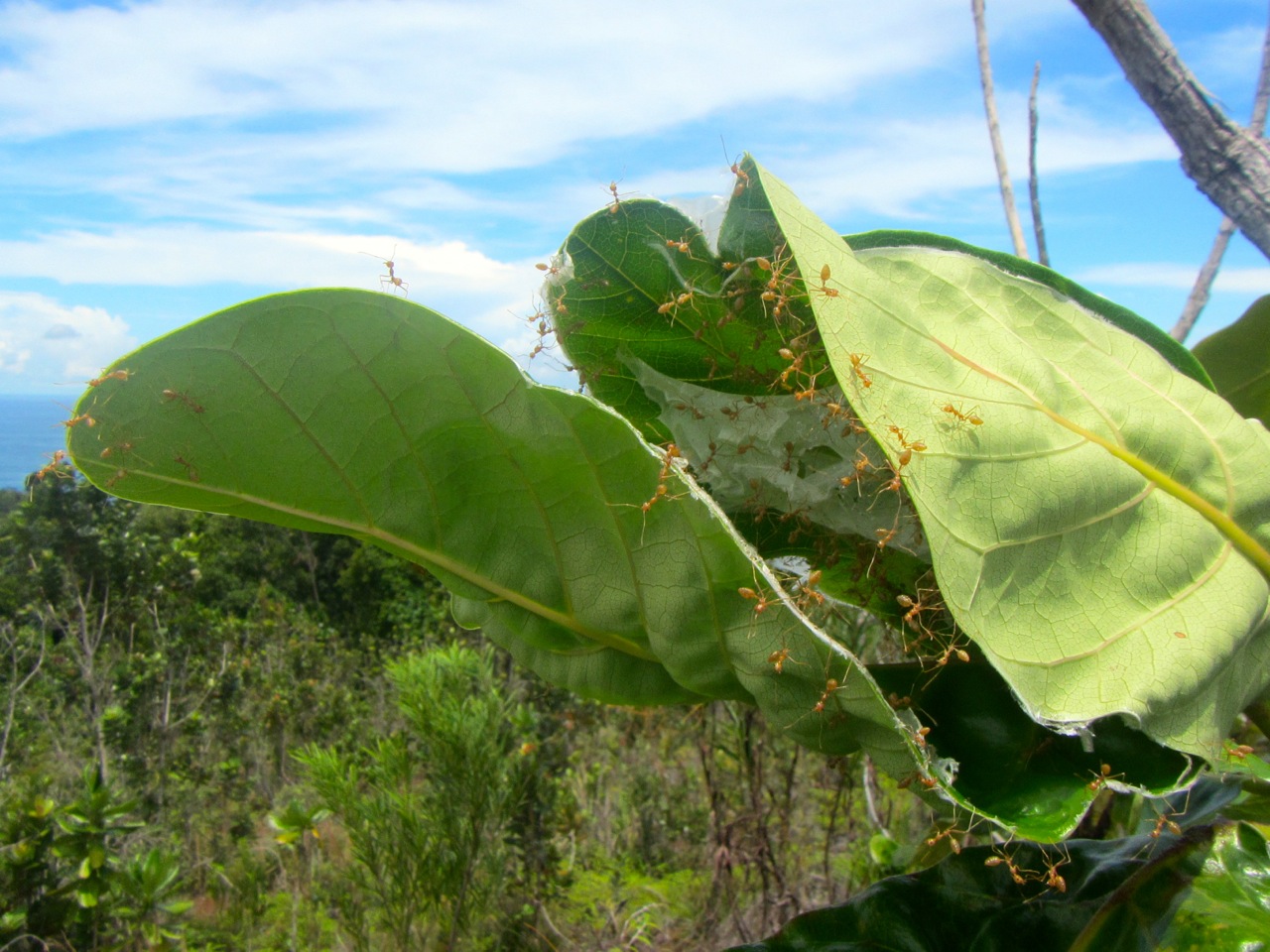
and the giant orchids grew right out of the earth
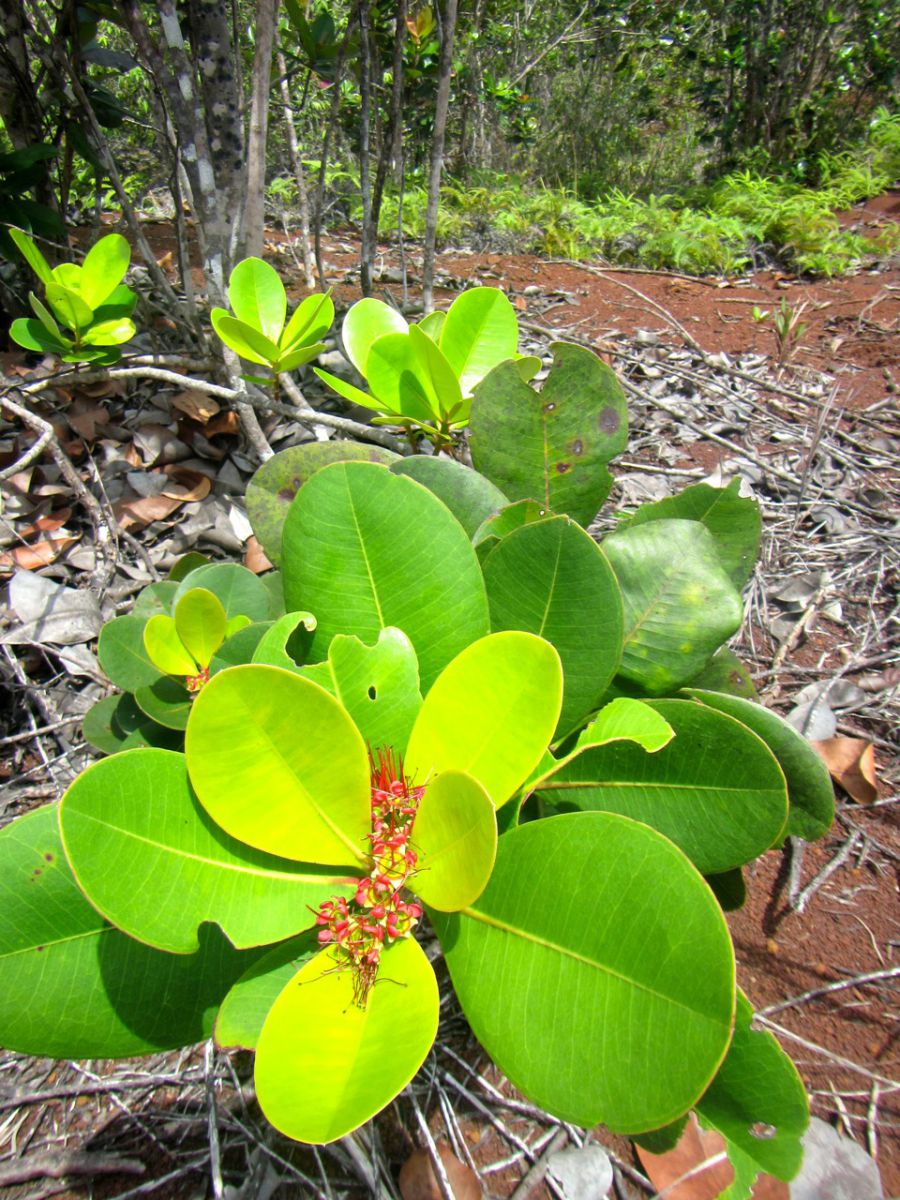
with no less giant hibiscus,
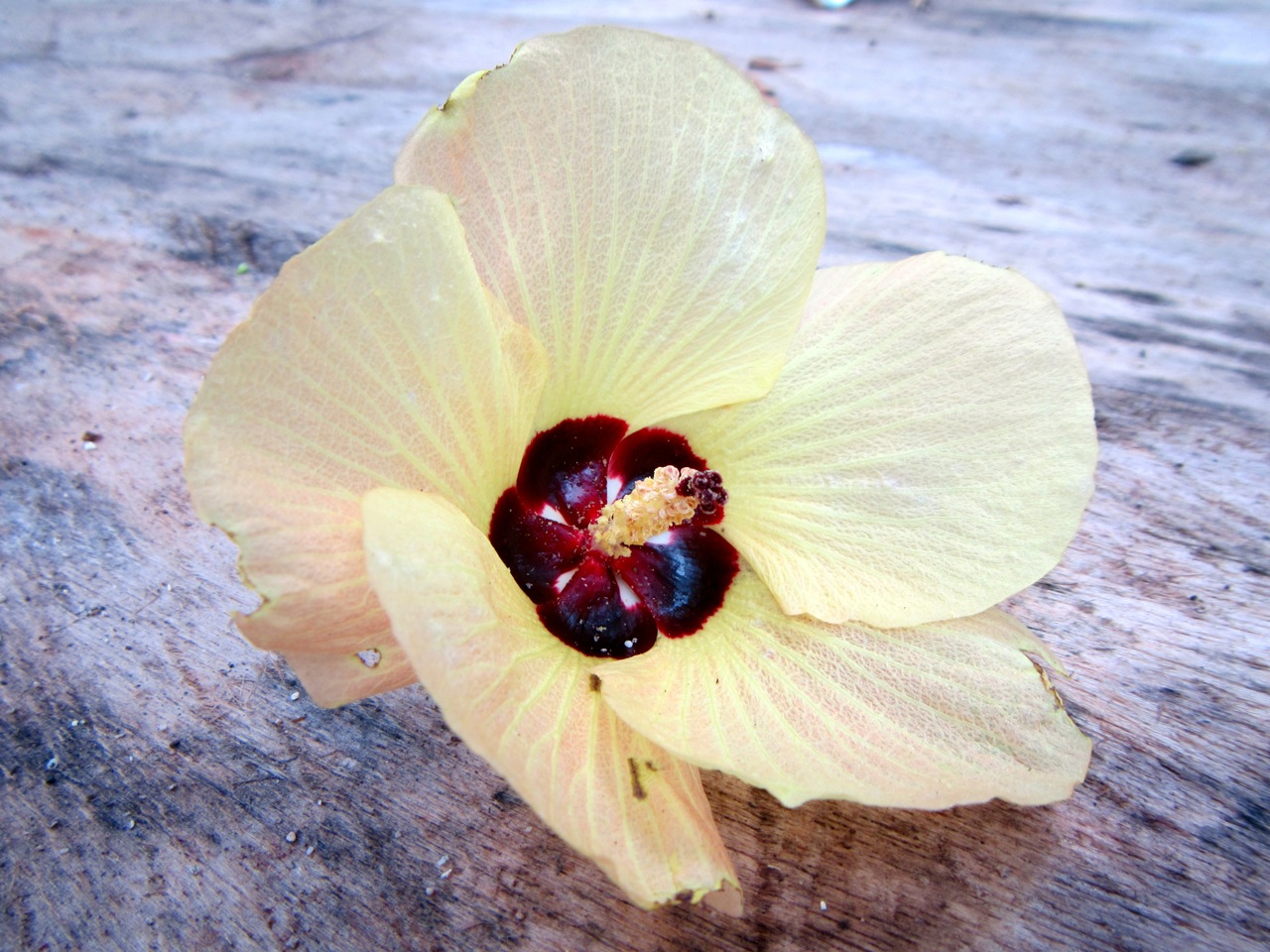
and with nuts of the most poisonous plant on the Earth falling on people’s heads.
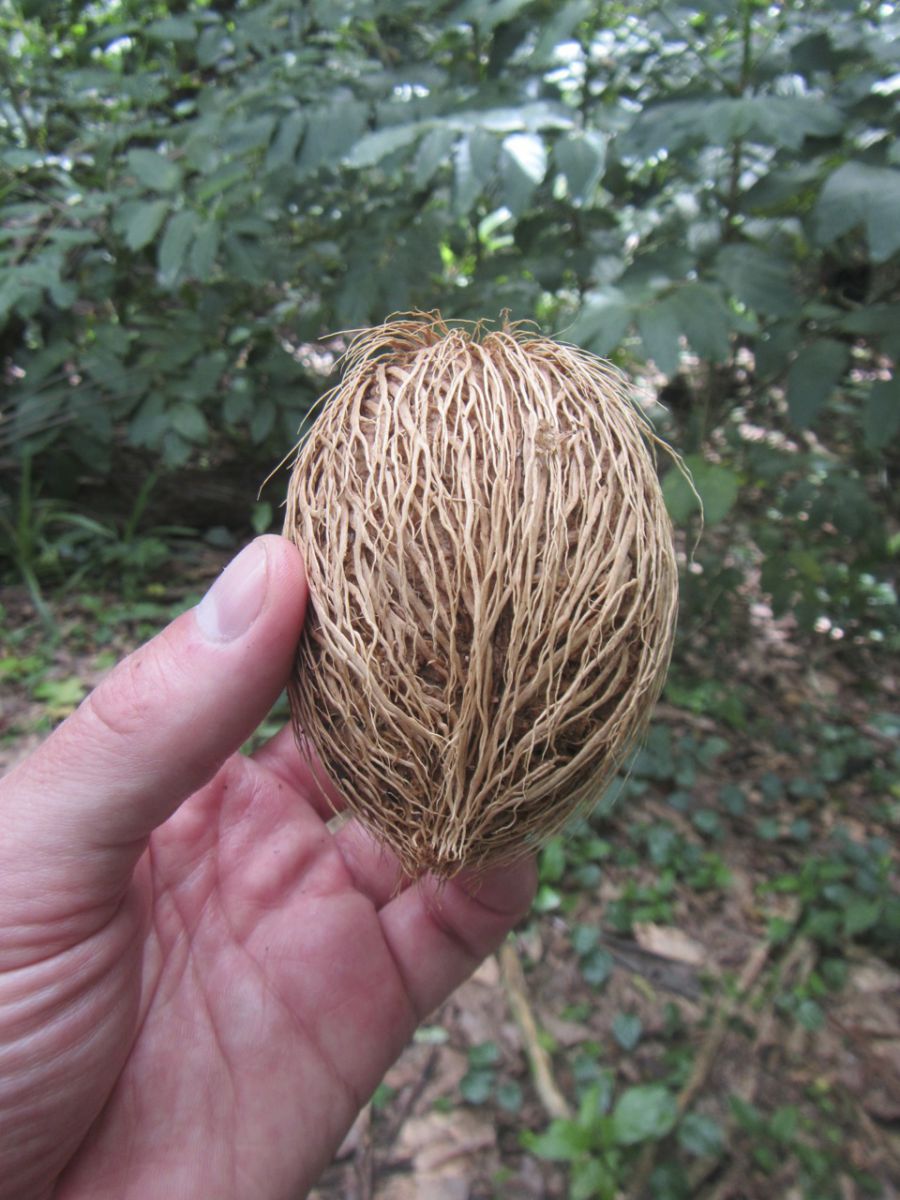
Moving towards the aim of our expedition which is, let me remind you, “Not clear!” :) we descended the high plateau to the coast which looked the same as the fabulous coast of Mikloukho-Macklay (it is a little to the east) and where we saw the Pacific Ocean through the mangrove jungle.
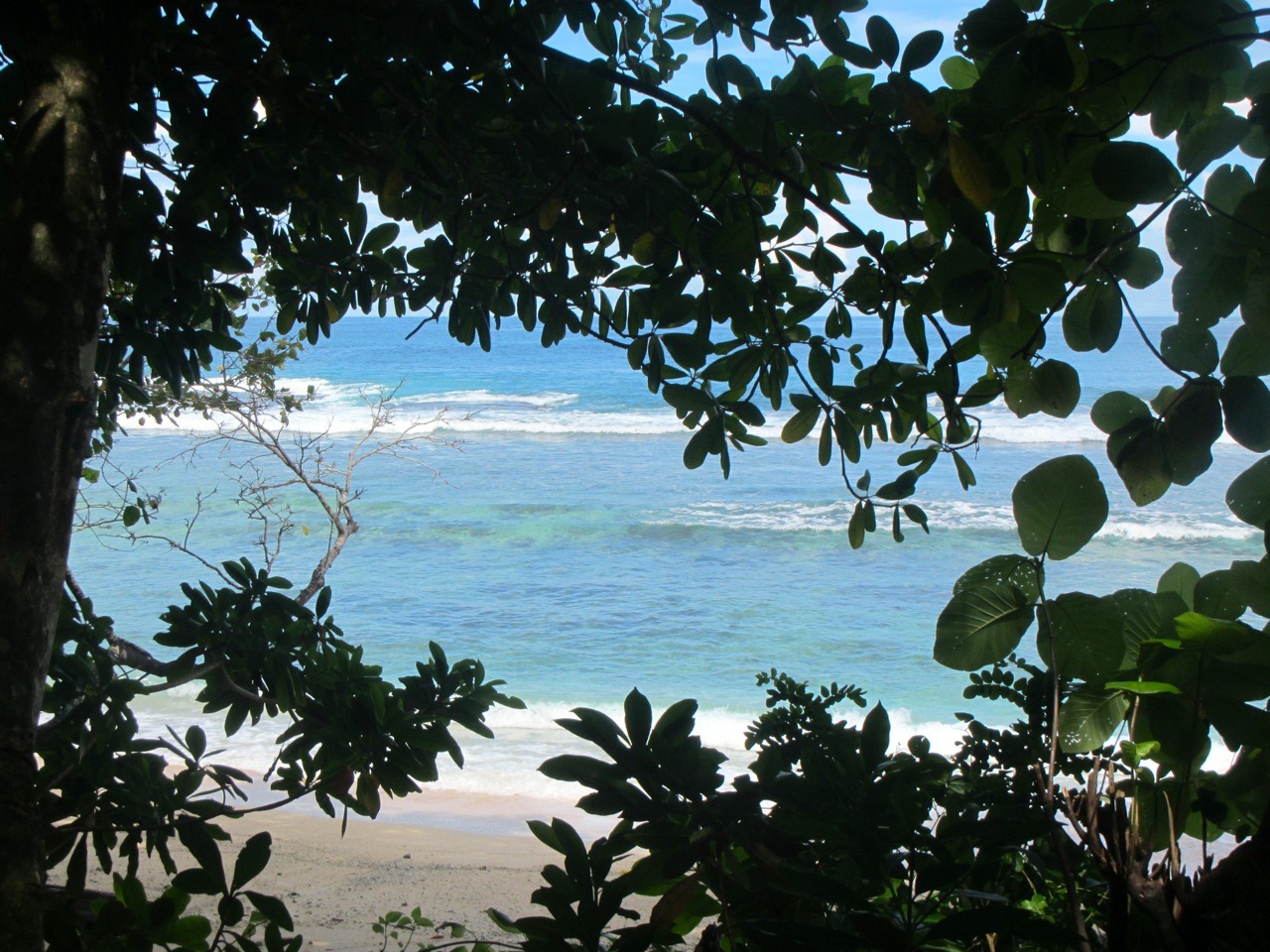
The coastline looked as if from an amateur painting. It was even a bit shameful to take a photo of such a platitude but I couldn’t help. When will I see this place again? The bay surrounded with the rocky rugged shores on three sides was magic.
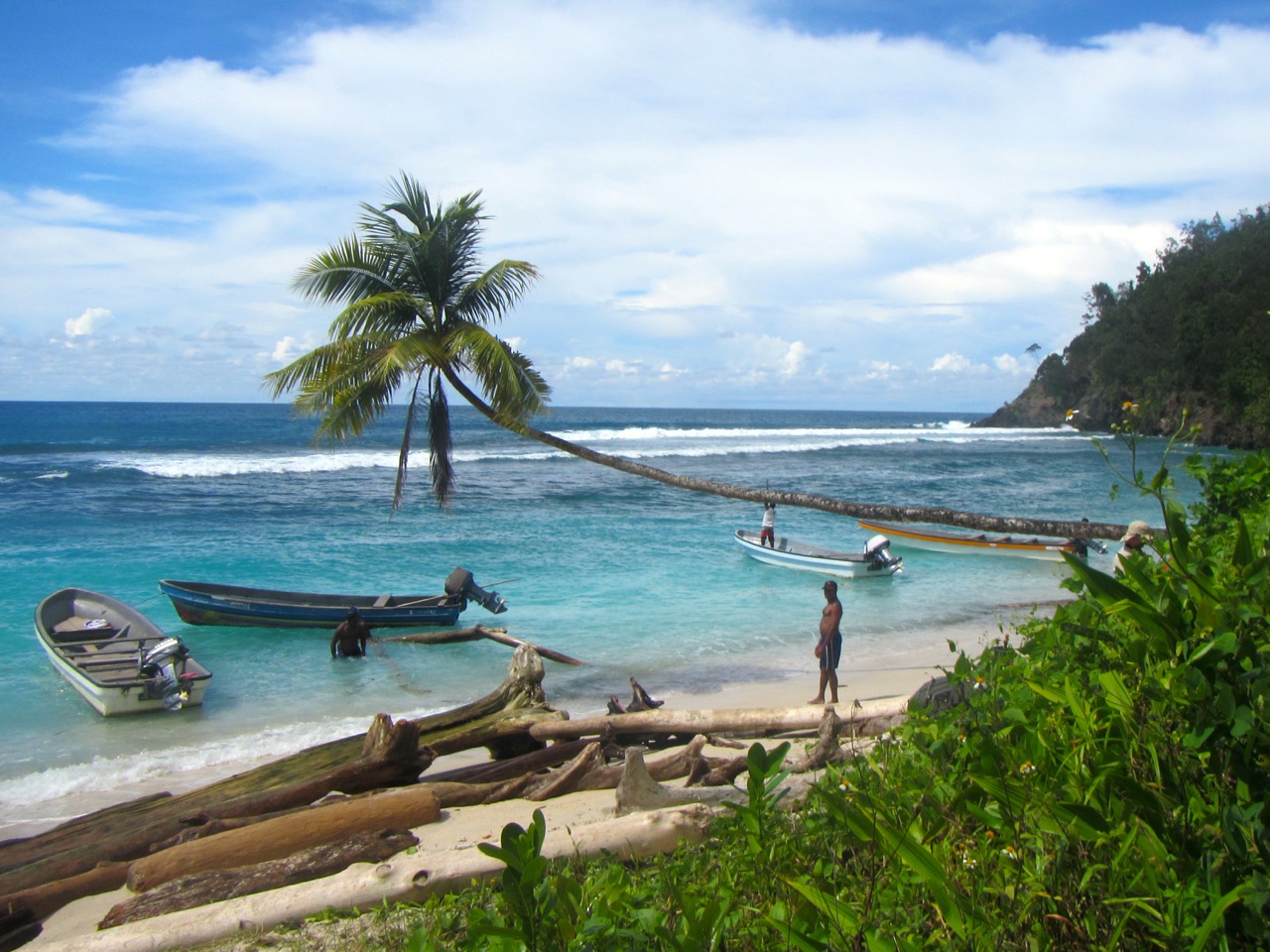
But even relaxing on a beach can be deceptive as the momentary change of wind forces you to save your things, boats and even your life.
Having set up the camp in a hurry among the relict palms
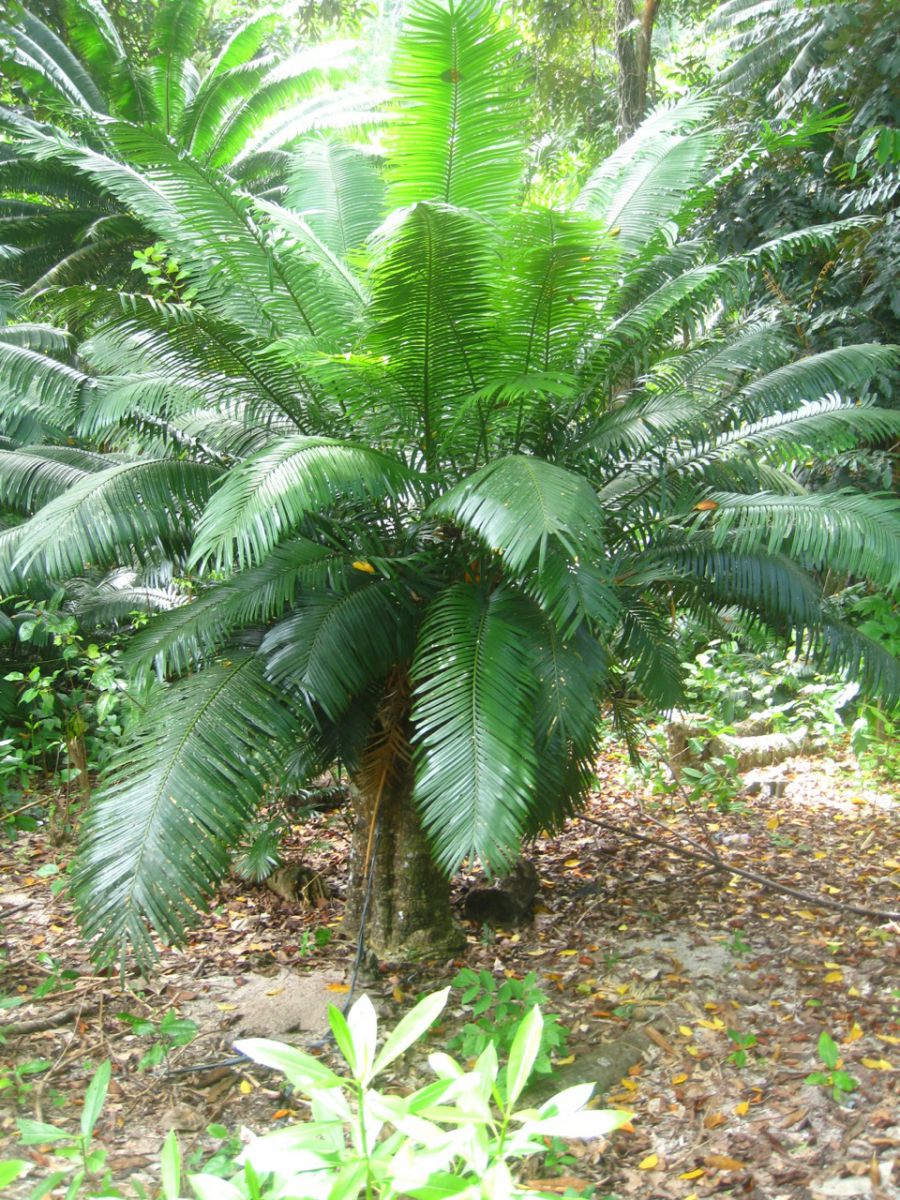
and giants roots,
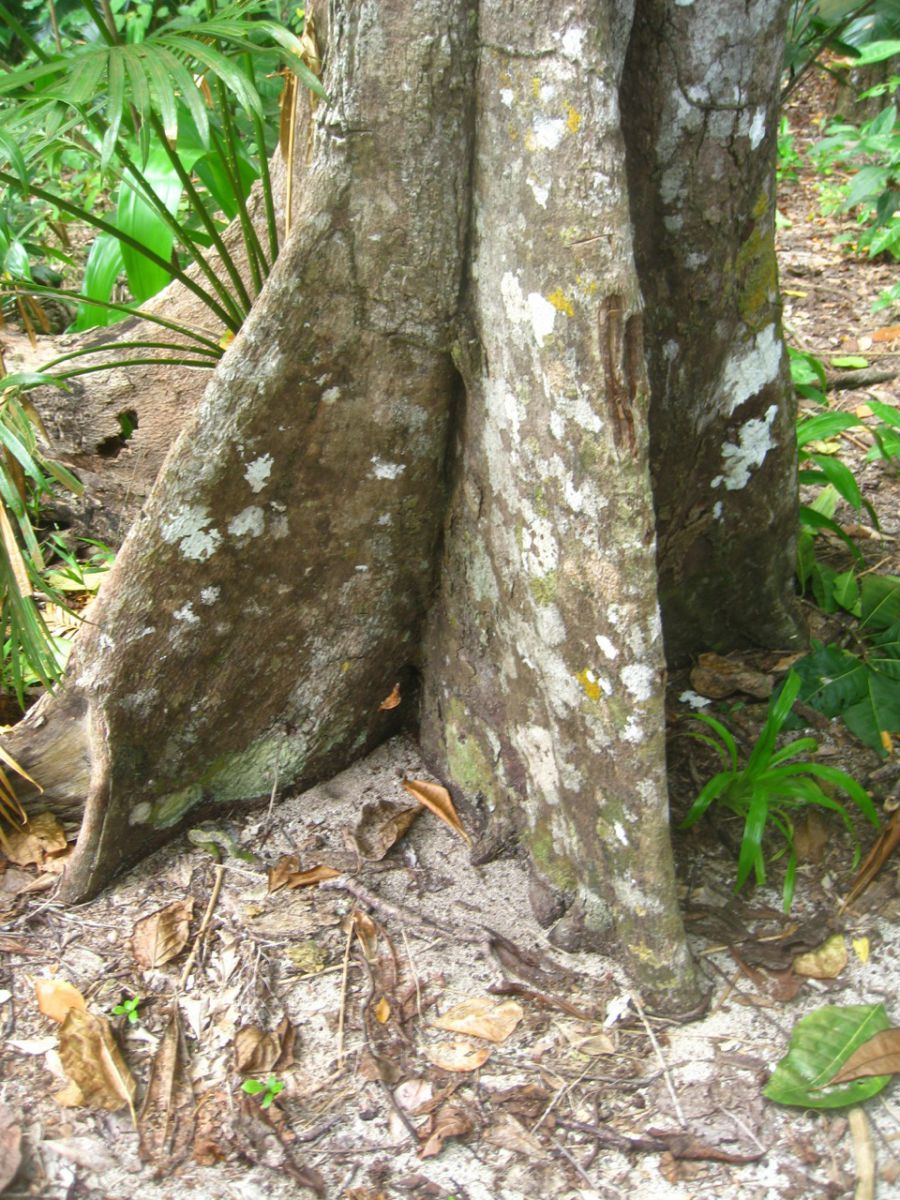
we watched the ocean sunset enjoying the roar of the waves and the chant of cicadae… That was a true relaxation on the beach! :)

Leaving the coastal part of the island we had an opportunity to see the shoreside from the water and it became obvious why it was nearly impossible to reach the island from the oceanside: the coral reefs and the cliffs with the waves splitting upon them could easily splinter any vessel into pieces.
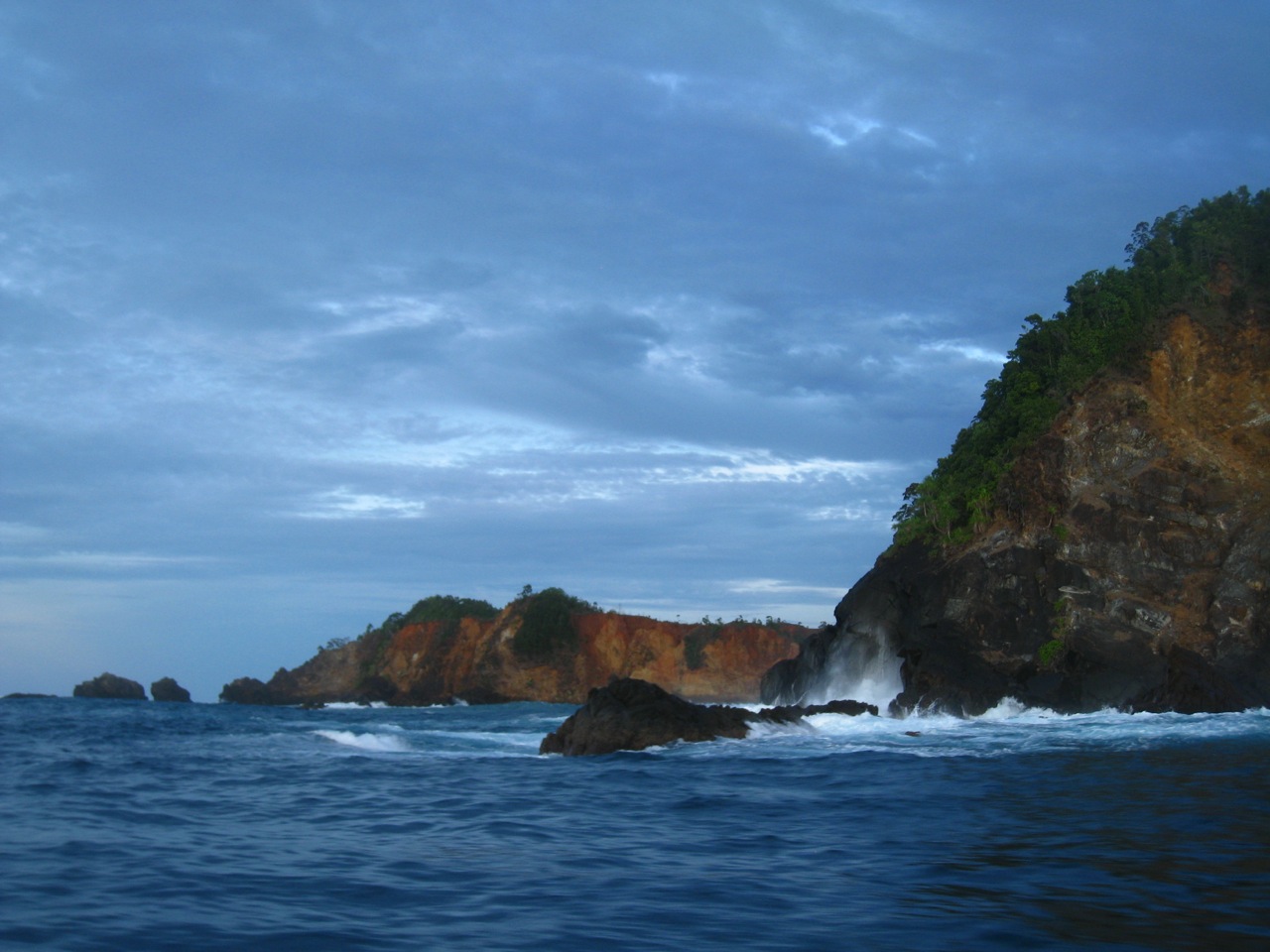
Leaving the coastal part of the island we had an opportunity to see the shoreside from the water and it became obvious why it was nearly impossible to reach the island from the oceanside: the coral reefs and the cliffs with the waves splitting upon them could easily splinter any vessel into pieces.
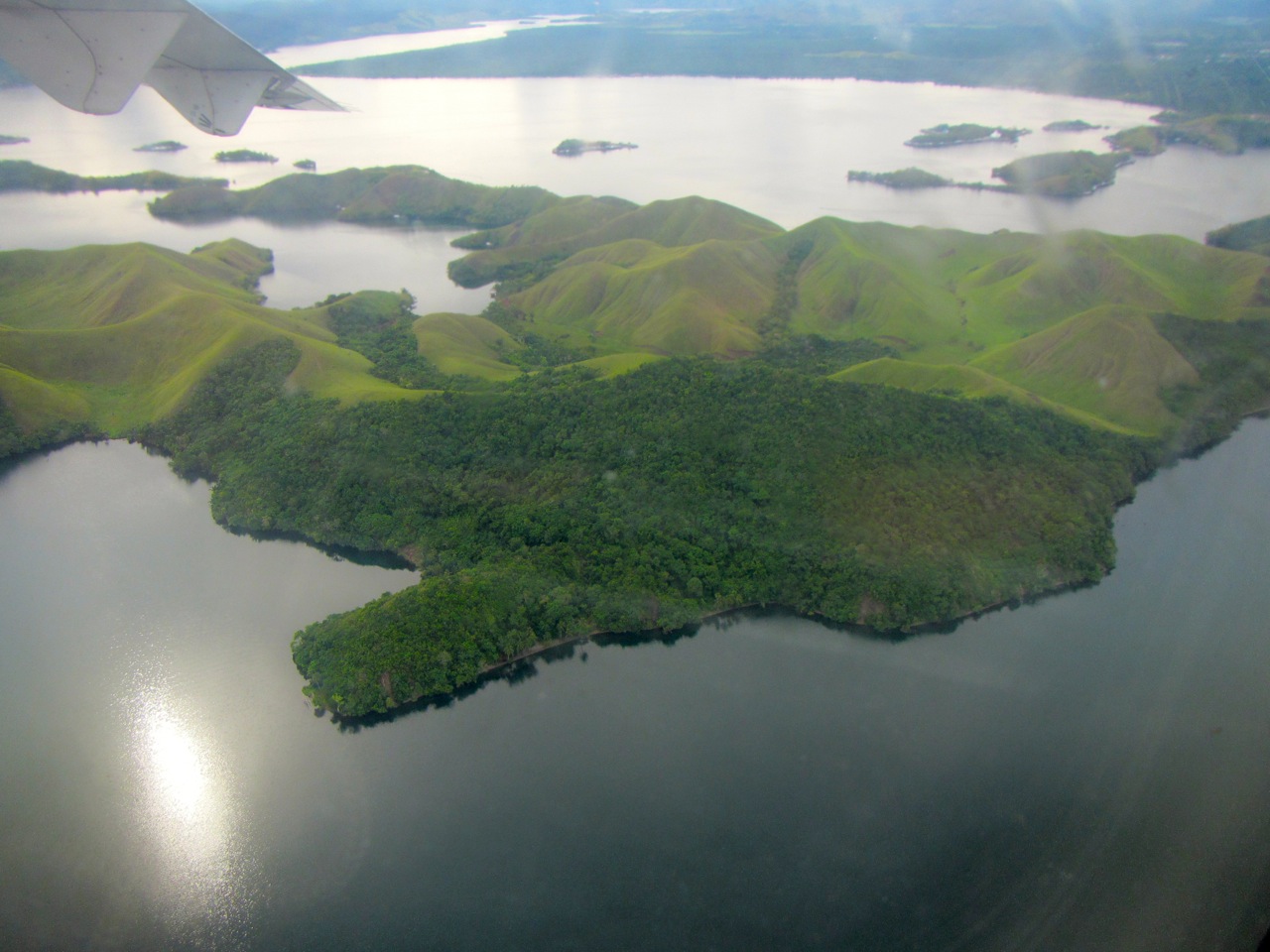
A green endless sea of jungle. Just the channels of the rivers, all yellow with slit and in snaky windings, disappeared in the depths of the jungle or reached the horizon thus reminding us of roads and clearings familiar to a human eye.
Forty minutes later we reached the southern part of the island where we had to pass 170 kilometers down the Brass river, which was mapped only 40 years ago, and then to go deep into the jungle for 40 kilometers, and thus to find ourselves 210 kilometers farther from the last missionary post – the end point of civilization.

After we landed on the road (vaguely resembling a runway) with a lot of children running across it we quickly took our baggage (the baggage was not delivered but was taken by us) and went straight to the Cannibalism police station to get registered… No, it is not a misprint, it is the Cannibalism police. Having signed all the papers with our photos (on a red background for some reason) and having spent the night in the police station we moved towards the river in the back of a little truck.
When we passed the wood bridges I couldn’t get rid of the thought about our photos on the red background… Like a face smeared with tomato ketchup … Ugh…
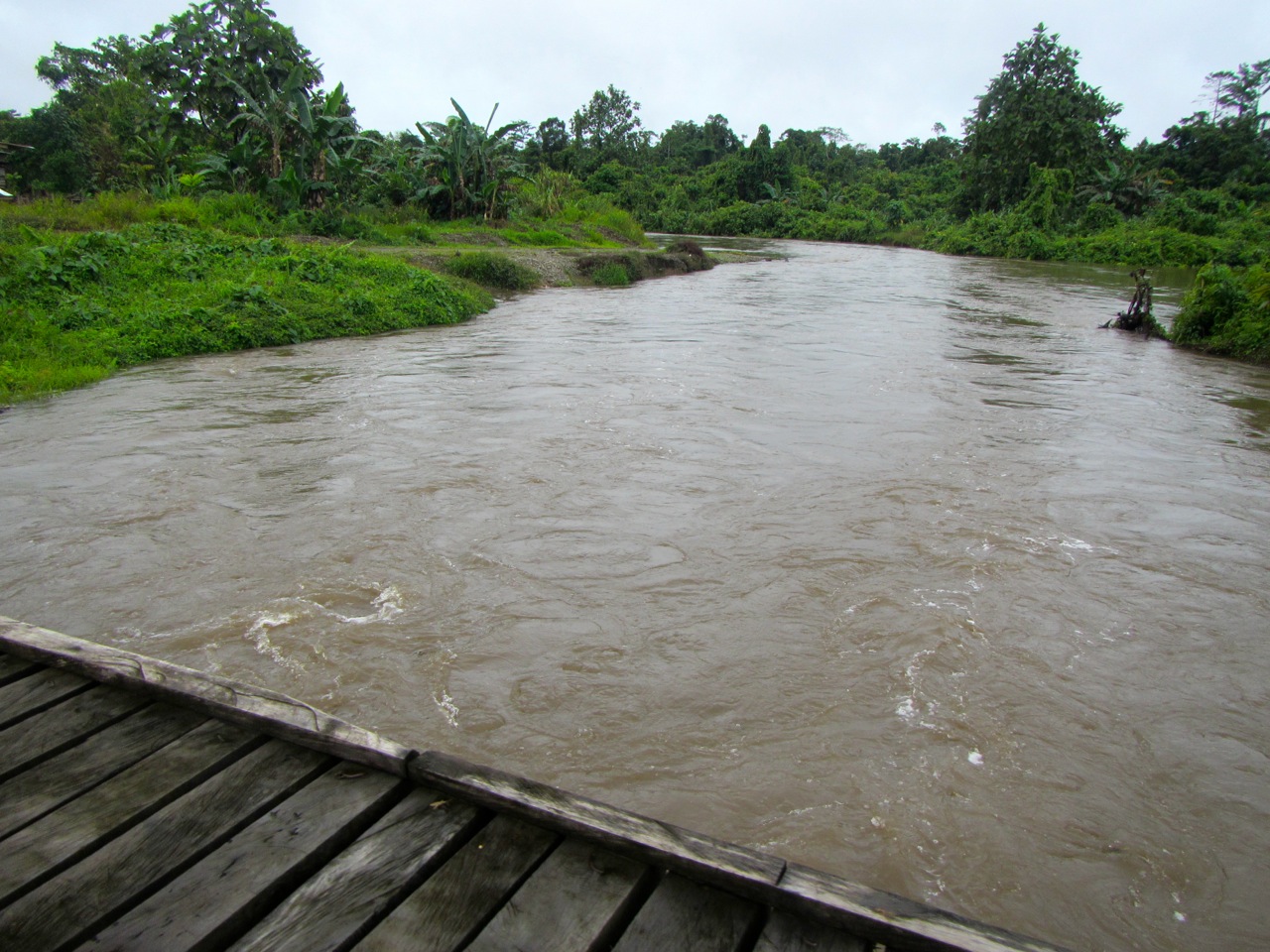
Soon we reached the river bank where we found the boats of absurd length though equipped with motors waiting for us.
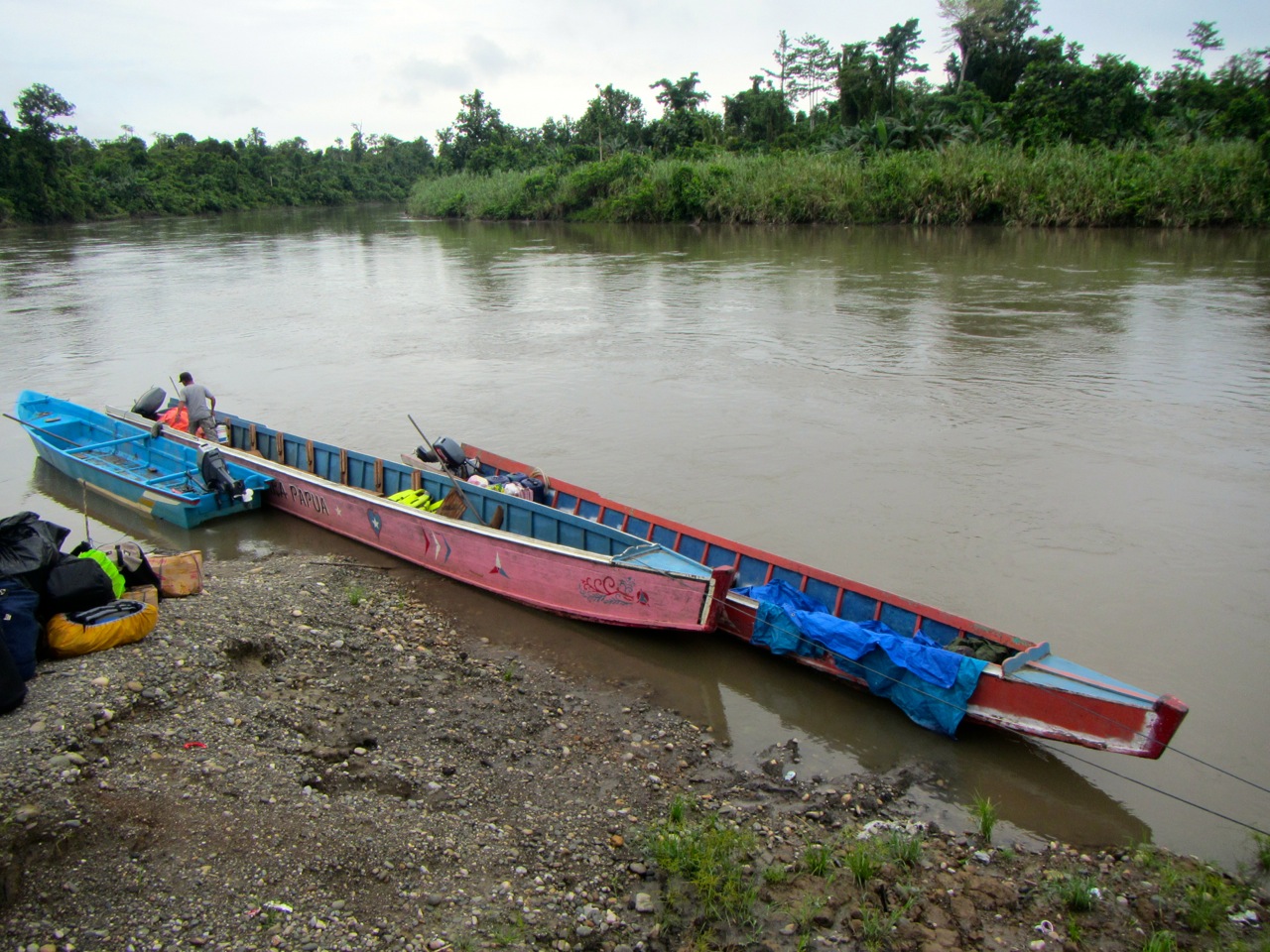
These boats belong to the Papuans of the Chitak tribe who live in the coastal part of the jungle and who came out of the jungle just a few years ago. They build houses covered with the grass on the river bank; and with the help of the boats shifting down the river they fish while transporting the missionaries they earn some money. During the tumultuous 1990s they wore no clothes at all and just some time ago they put on the shorts. So far they have fed on insects which they skillfully gather in the jungle.
More or less habitable villages along the river bank
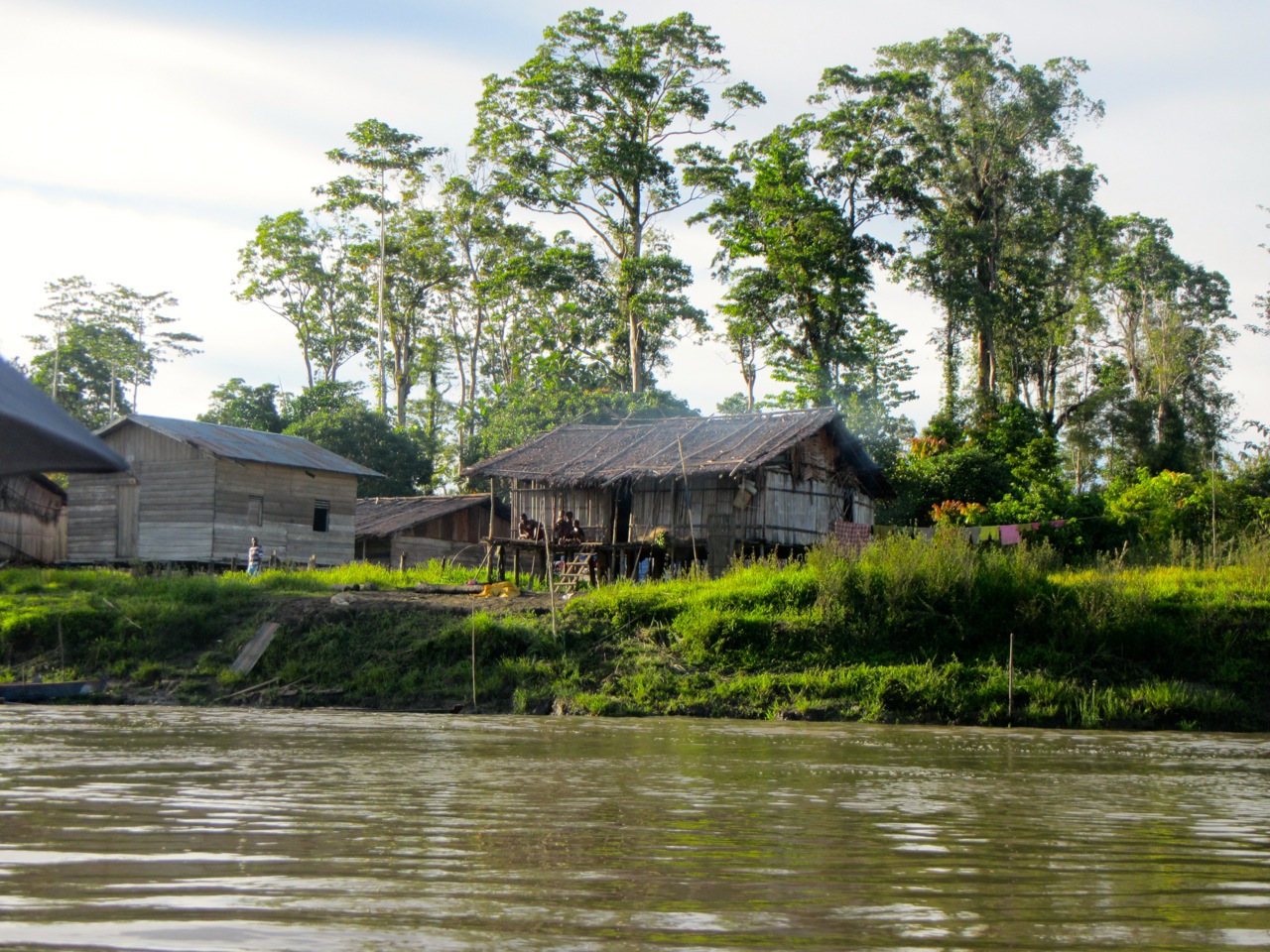
quickly changed for huts which made us feel uneasy about their loneliness.
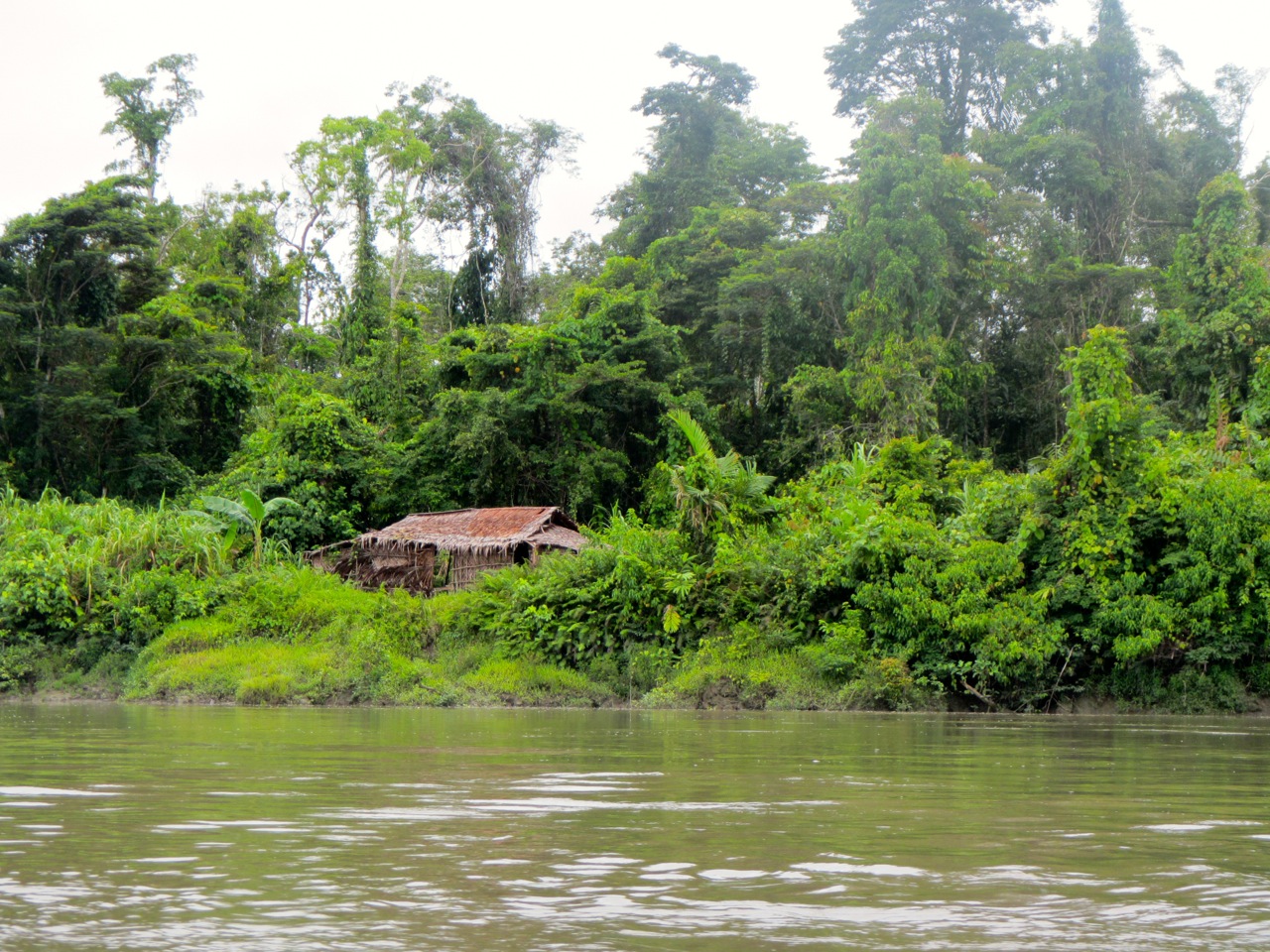
Sleeping Theron (our cook, a Papuan from the Lani tribe living in a mountainous part of the island) didn’t even suspect what was coming next. I will tell you about it later, and in the meantime we have a fork on our way: to the left there is a tributary of Koluf – this is a famous way to the cannibals, according to our guide, and to the right there is a tributary of Serat – it hasn’t been mapped yet. Andofcourse, wewillgo… totheright. Intotheunknown!
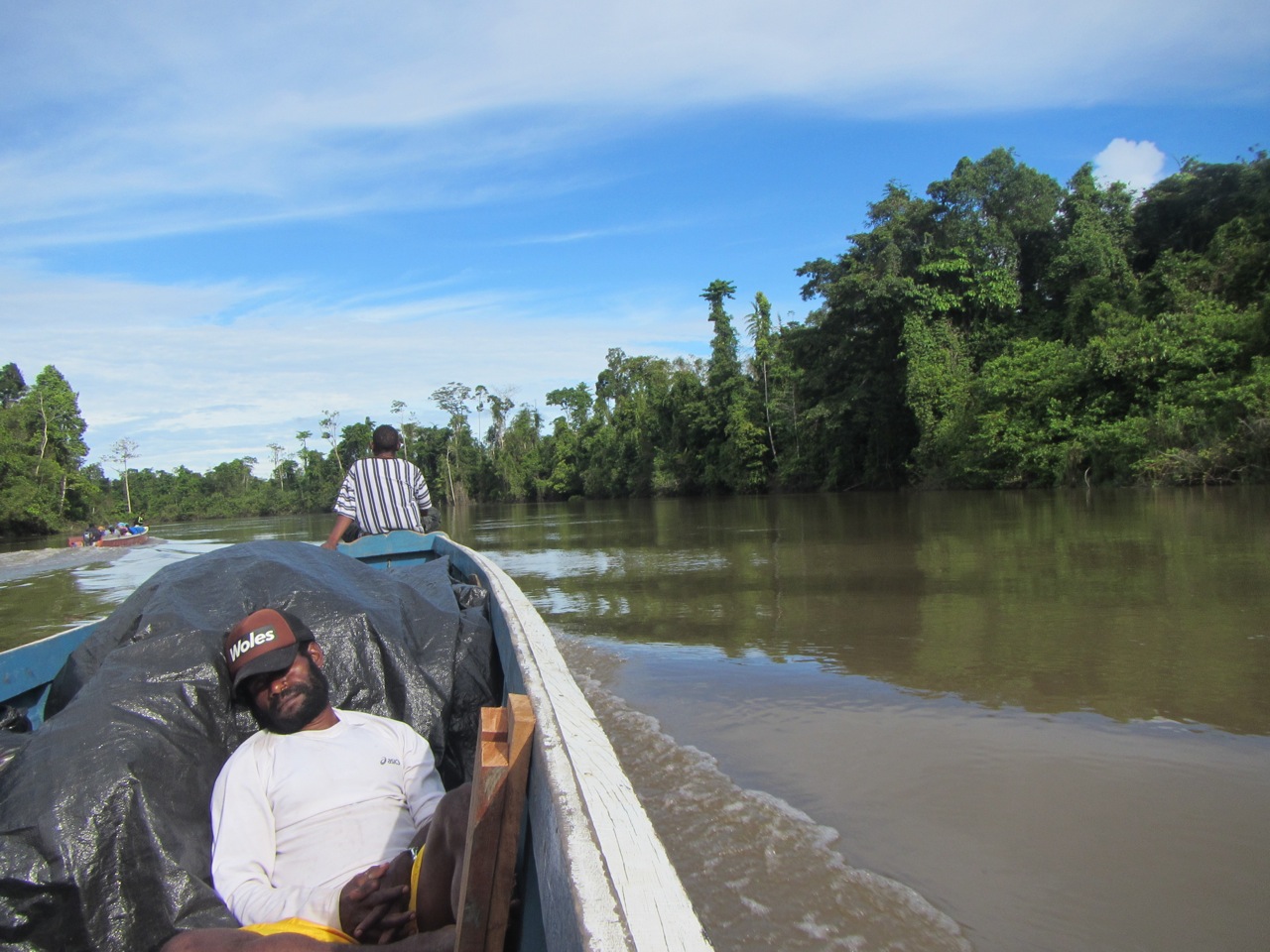
Occasionally stopping over on the gravel beach we moved down the river overrun with crocodiles with the speed of about 20 kilometers per hour under the boiling sun.
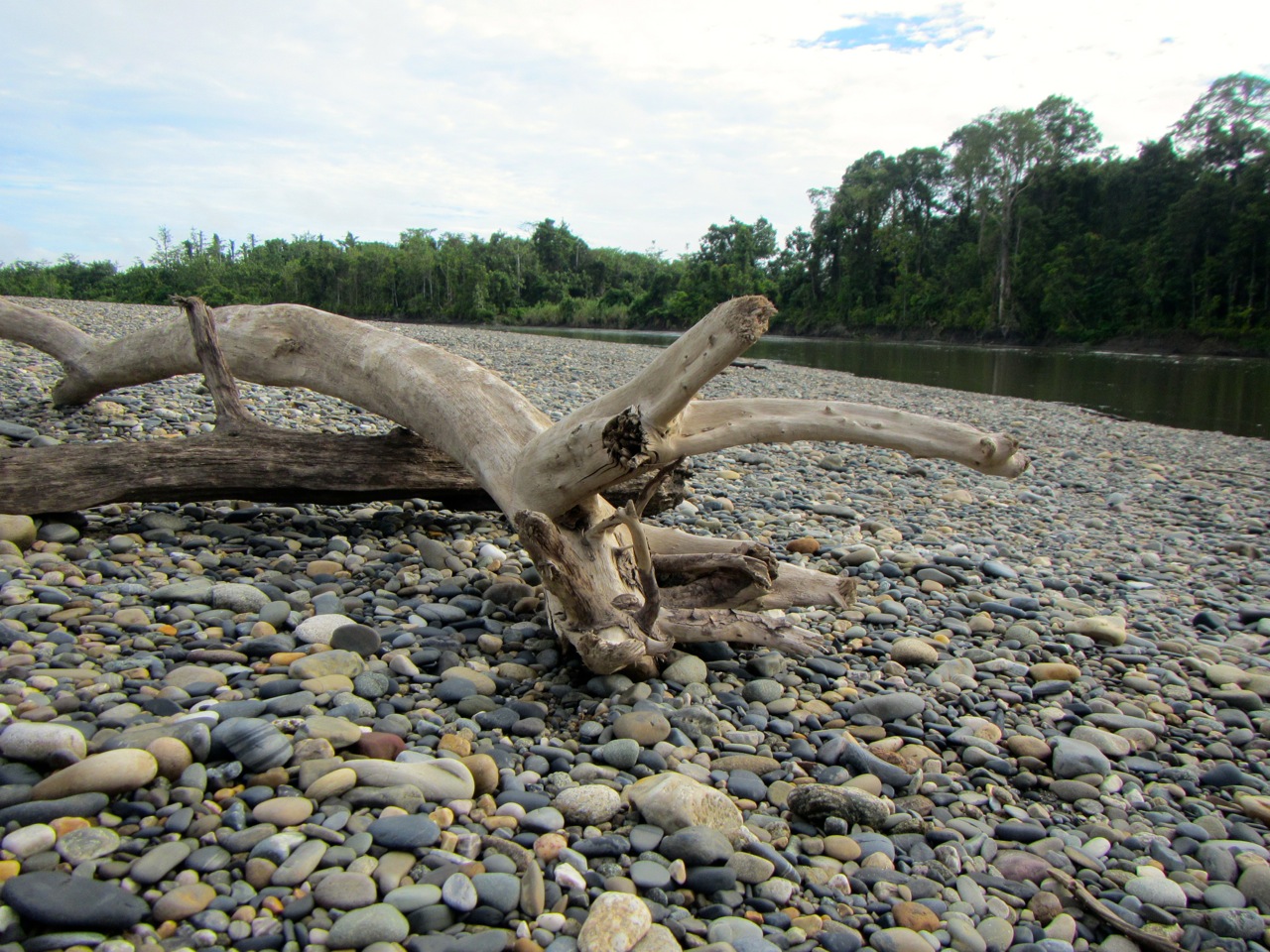
In 10 hours we landed in a total darkness. Myriads of firefly bugs forming sparkling clouds in the jungle leaves were driving our growing unrest away. Despite we had a guarantor of our safety with us – named Anton by the protestants – a Papuan from the Korowai tribe, we were on the territory of the most bloodthirsty and the most combative Asmat tribe – the Papuans who used to live by the river and were better known as “headhunters”. There are certain rules here. They still make tribal wars for the key point, for women.
That time things came right. Having spent a night in the tents we got under way. On our way we came across a “perfect town”. This way the Government of Indonesia tries to “draw” the Papuans out of the jungle. But these houses are usually inhabited by the people who built them. And all the efforts to socialize the tribes result in the missionaries being eaten, and the authorities resolve the tribal conflicts with the help of helicopters and napalm attack.
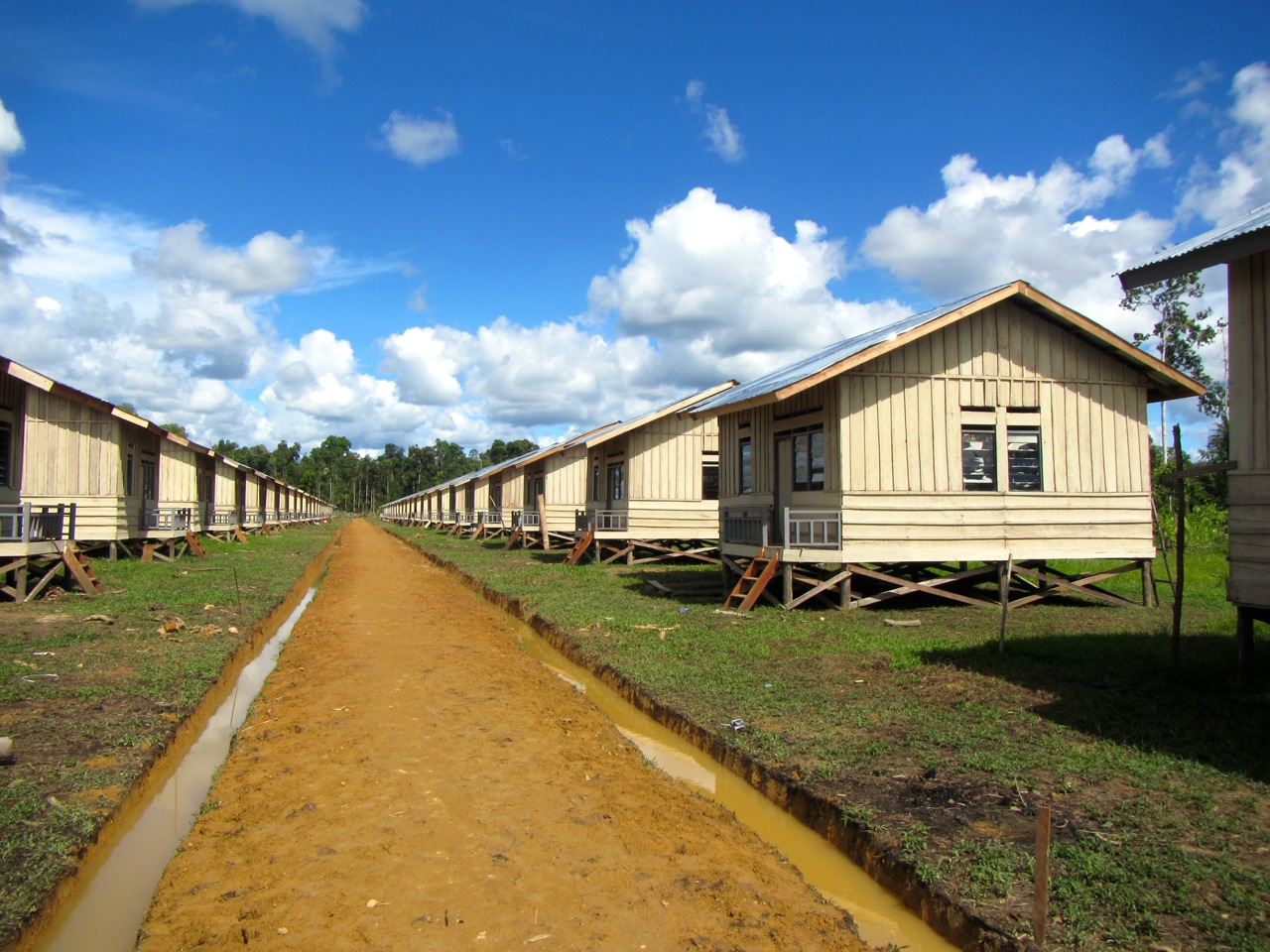
The wet jungle as well as the sago and mangrove swamps was formed due to the river overflow and the zero level above the sea. Keeping in mind that right here, in this jungle, in the 1970s Michael Rockefeller who studied anthropology and the culture of aboriginal tribes (actually the same as we do) was eaten by the Asmat people, we were extremely careful and cautious closely following each other.
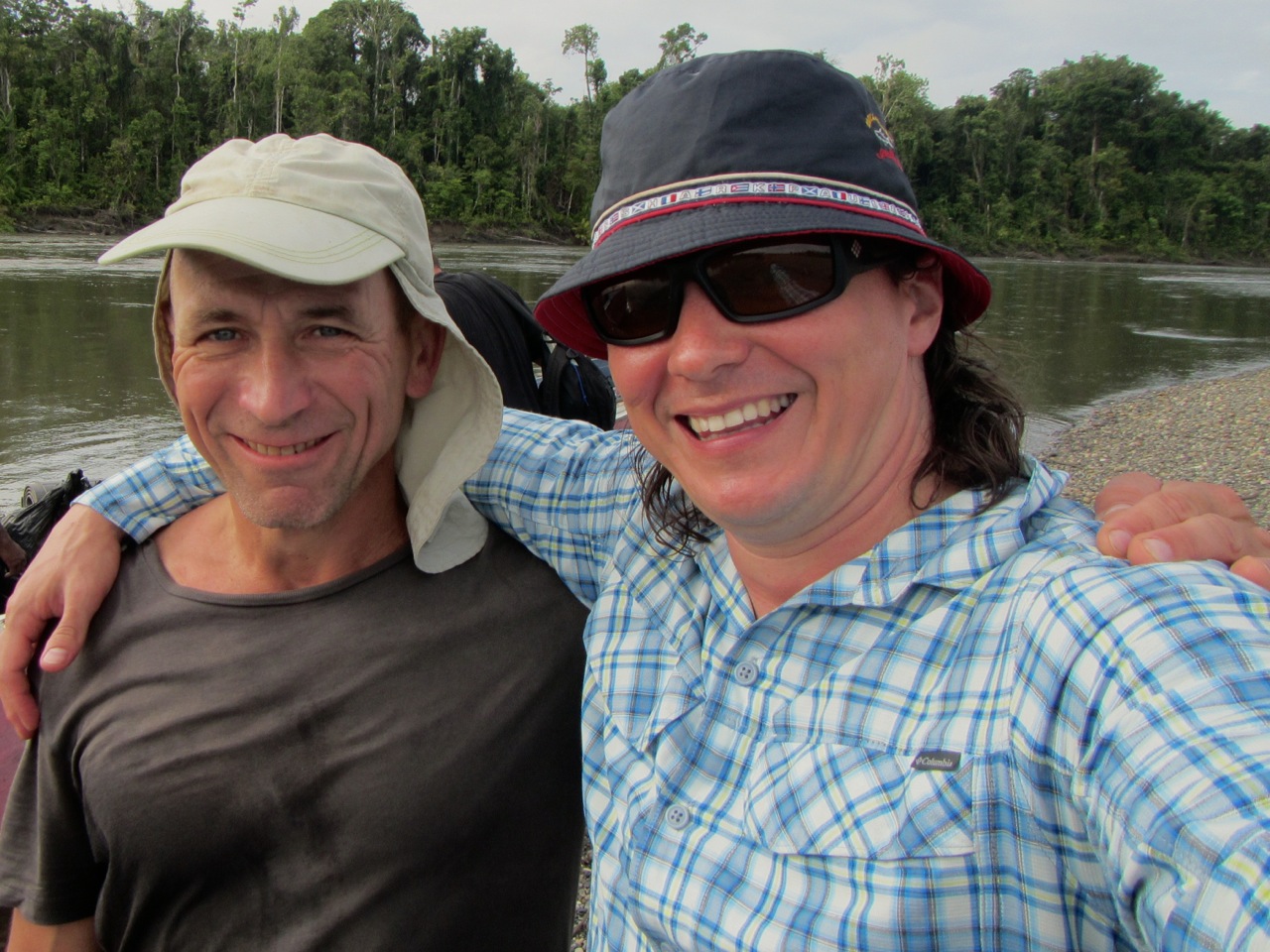
The main thing about the jungle is not to hear but to listen … to listen to the words of the person who has spent the most part of his life in expeditions including the tropics! Every traveller needs his own “Crocodile Dundee” and we had one. It was Ph.D. in Geography Dmitriy Chernyakhovskiy who protected us from danger with humor and ease!
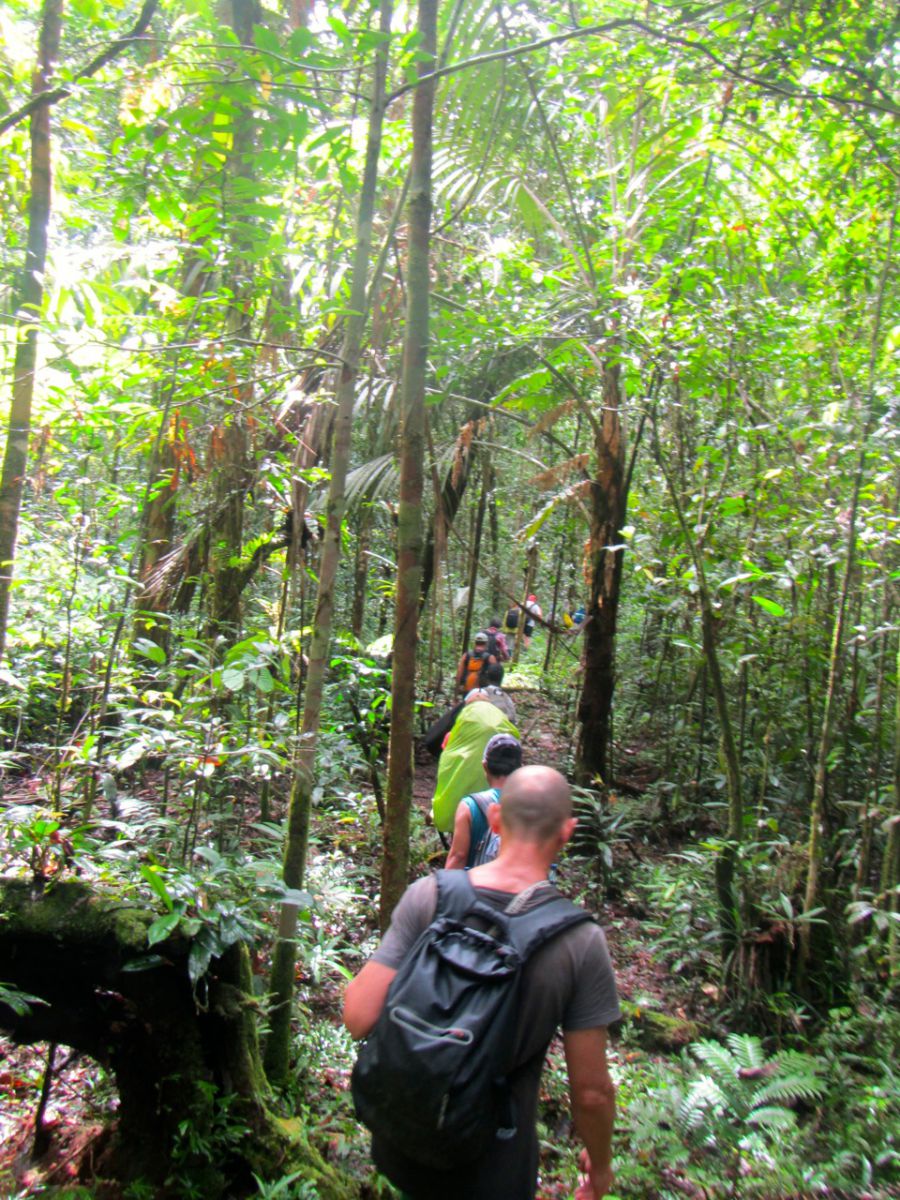
The picture around us was constantly changing. The clearings opened to the sun
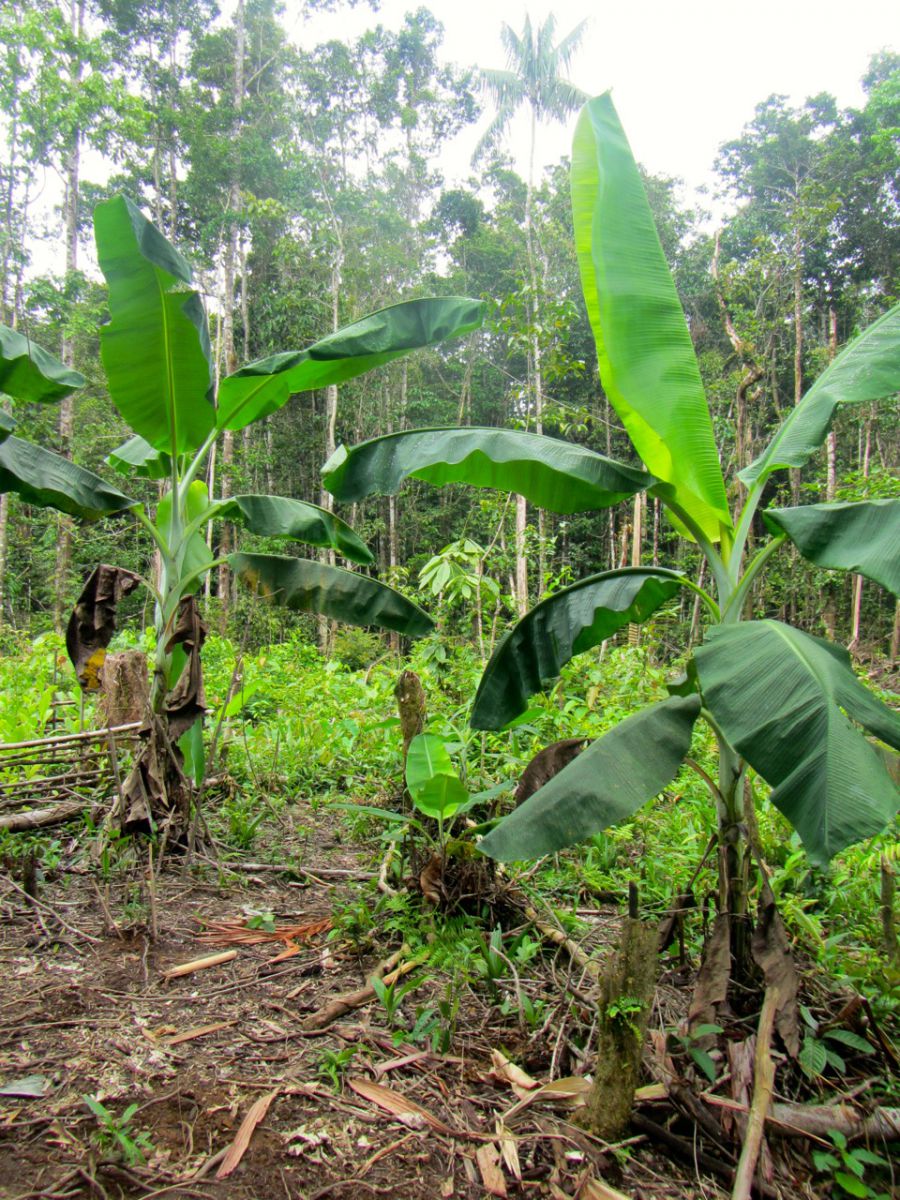
changed for the swamps which we got through with the help of the cut down poles.
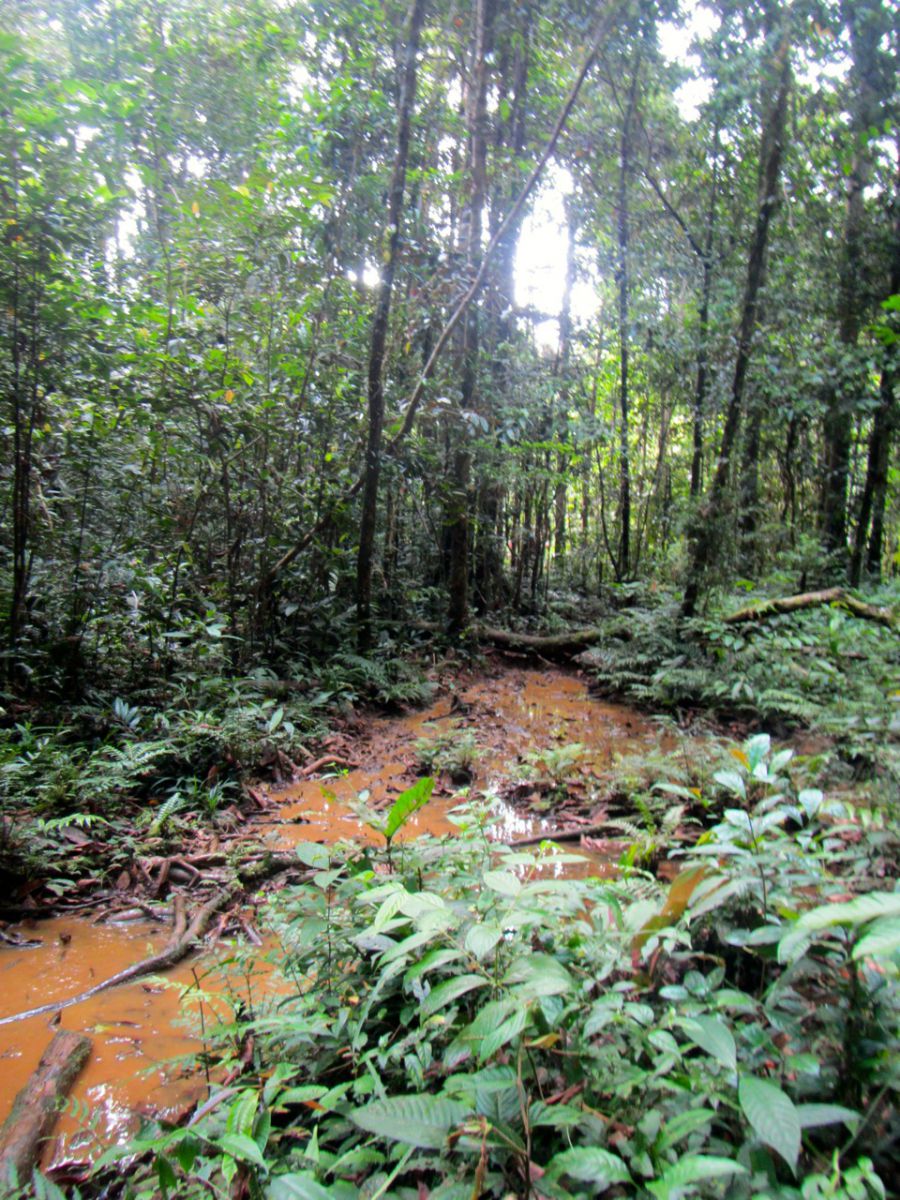
We crossed the numerous small but swift rivers with the help of lianas, like Tarzans, or over the laid log. And wecouldn’t escape from falling down.
I should note that our falls gave us though a passing but sort of joy to feel the cool water.
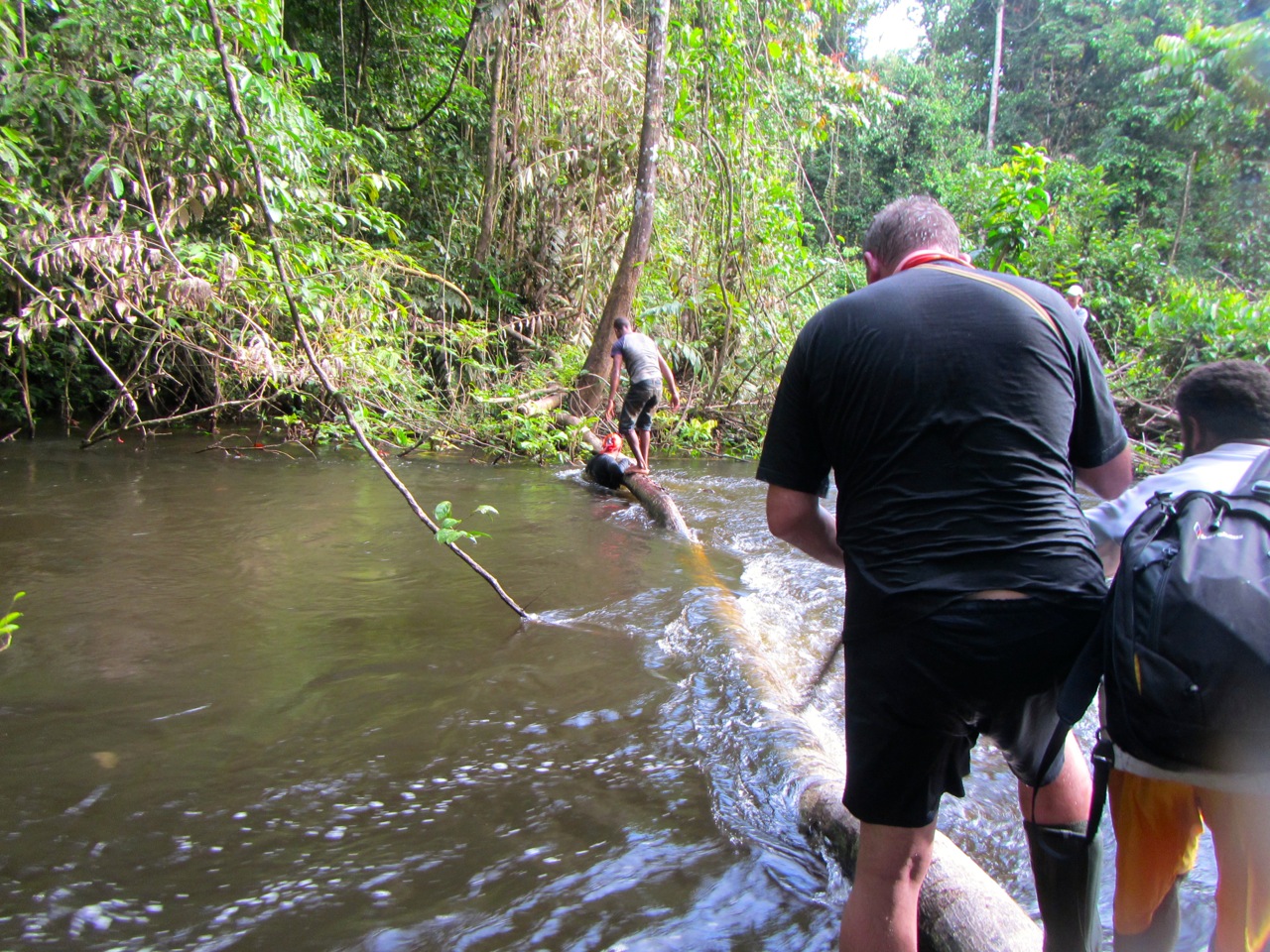
Several steps aside and you are in the grip of the jungle – visible paths inviting with their openness bring you nowhere. You can hear the voices afar but you cannot break through the network of lianas to them without a machete. Besides, when reflecting from the green walls the sounds produce an effect of a real labyrinth.
We go further cutting down the dense jungle and crossing the swamps over the slippery logs.
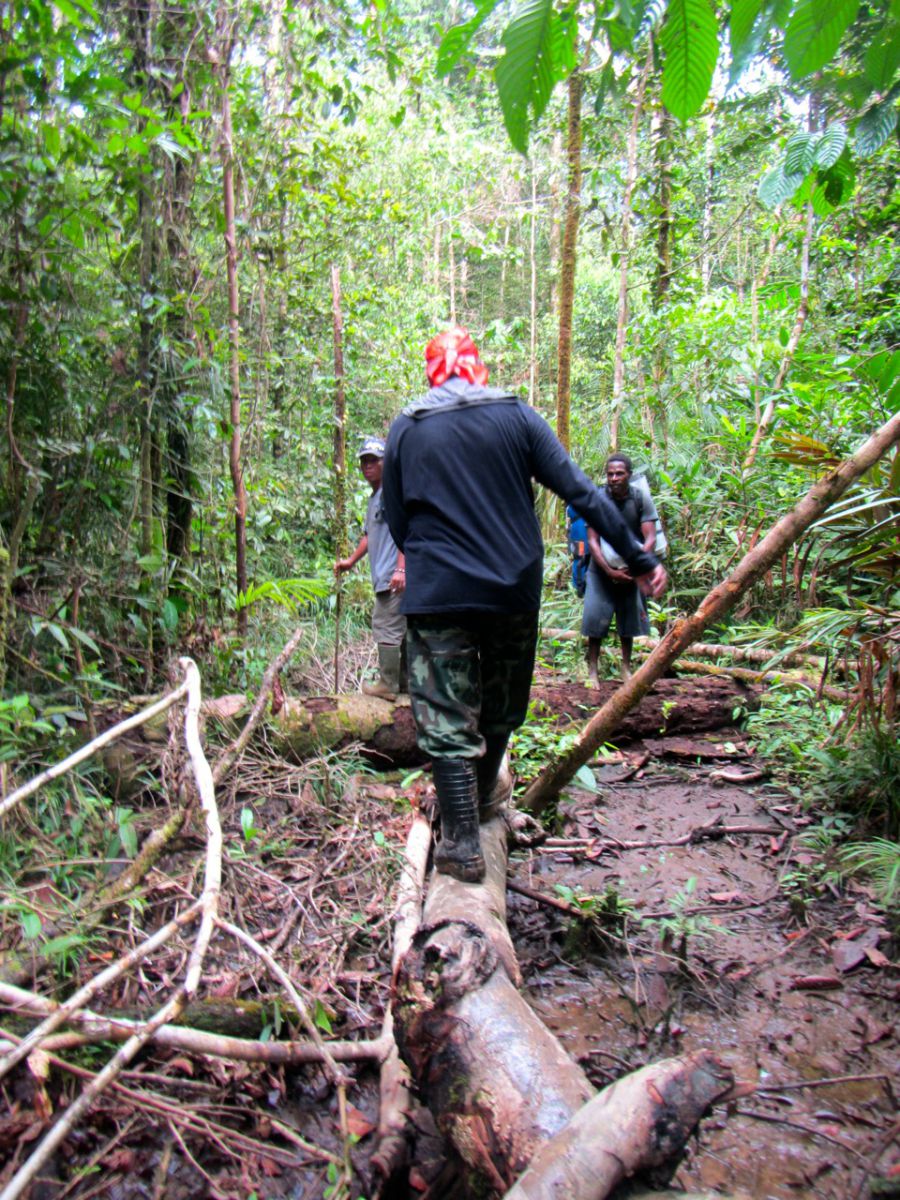
You never know which is more horrible: ravines, swamps, river overflows…
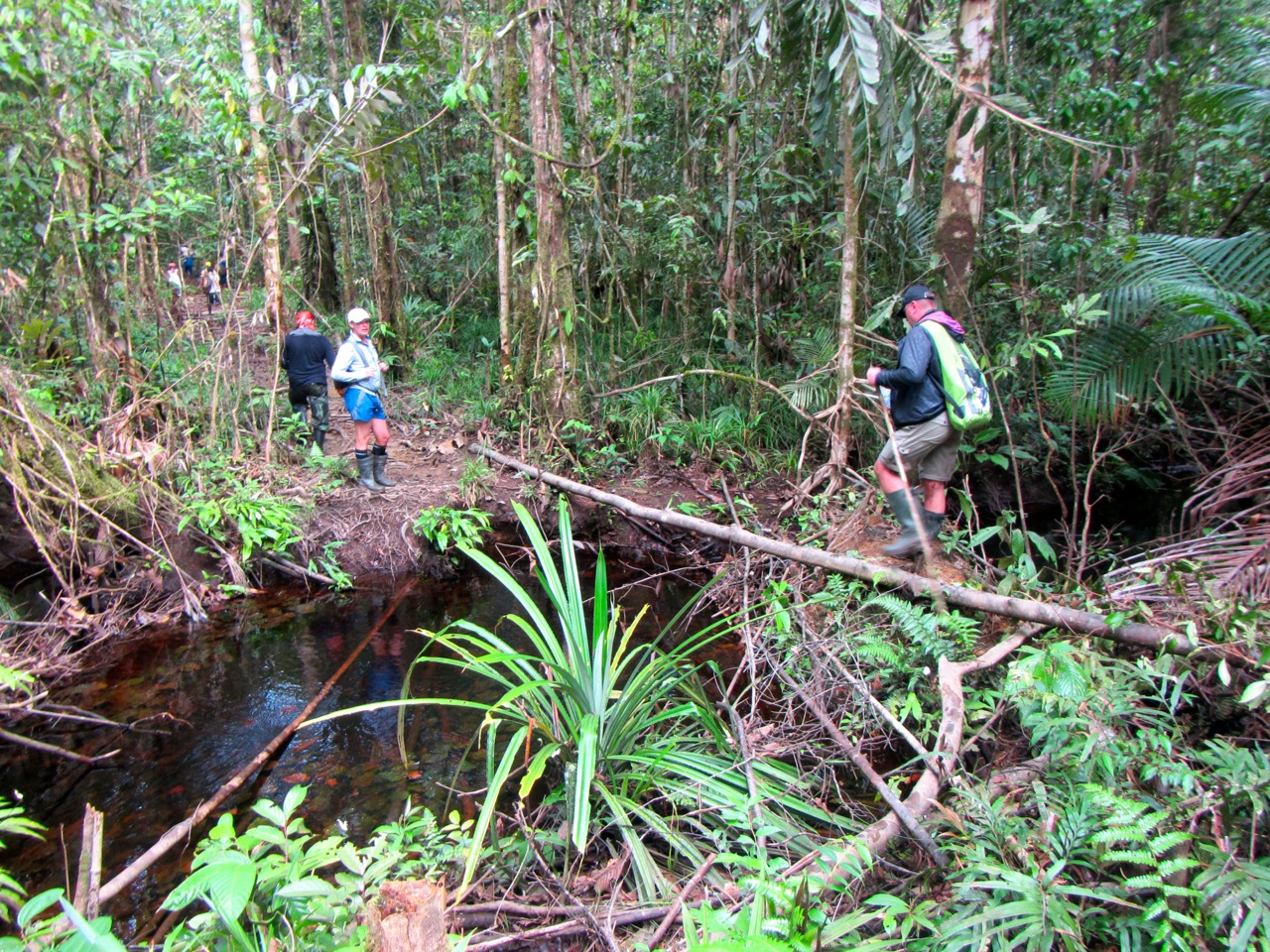
The sweat runs in torrents, it is 38 degrees of heat, 100% humidity: a dry T-shirt out of the moistureproof bag may be squeezed in 5 minutes…
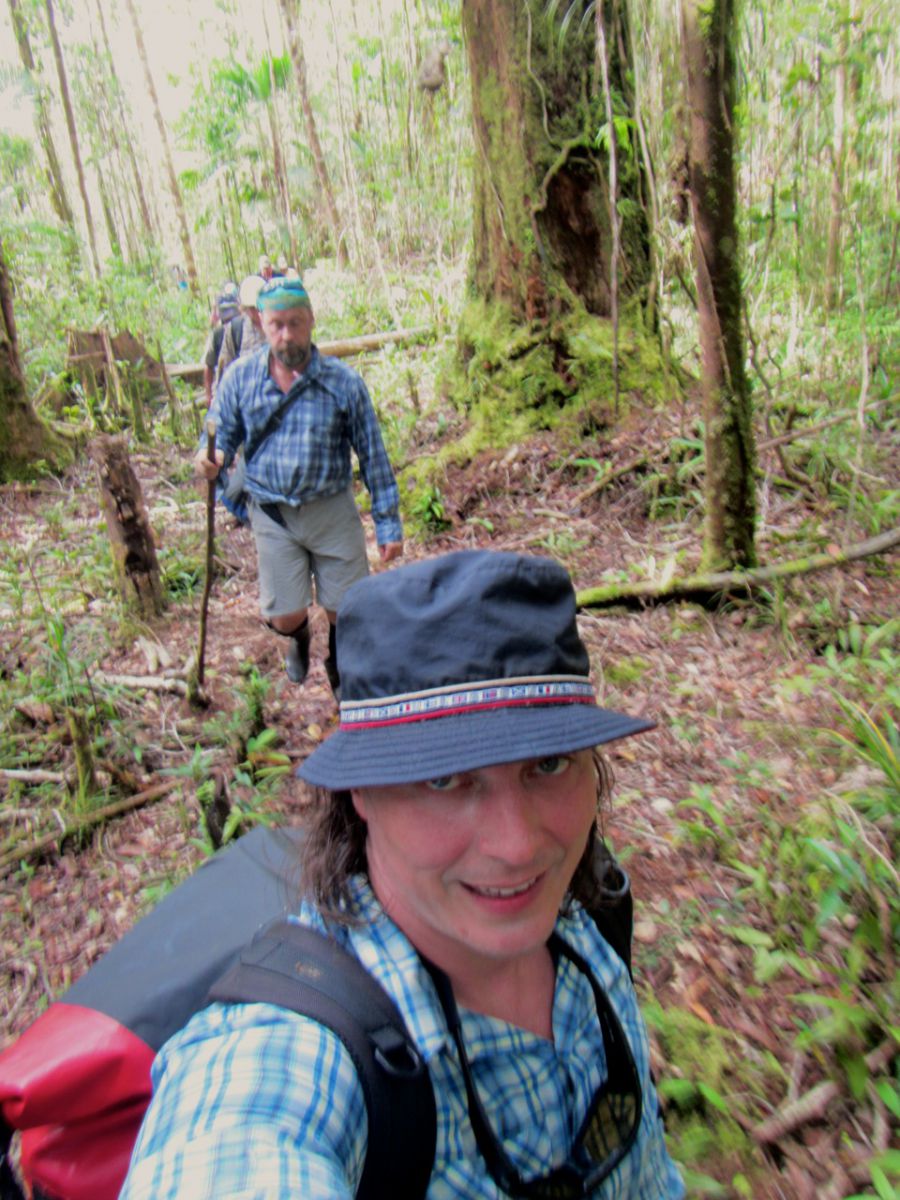
Everywhere around you can see the evidence that you have already traveled by the time machine into the Stone Age. The relict fern tree,
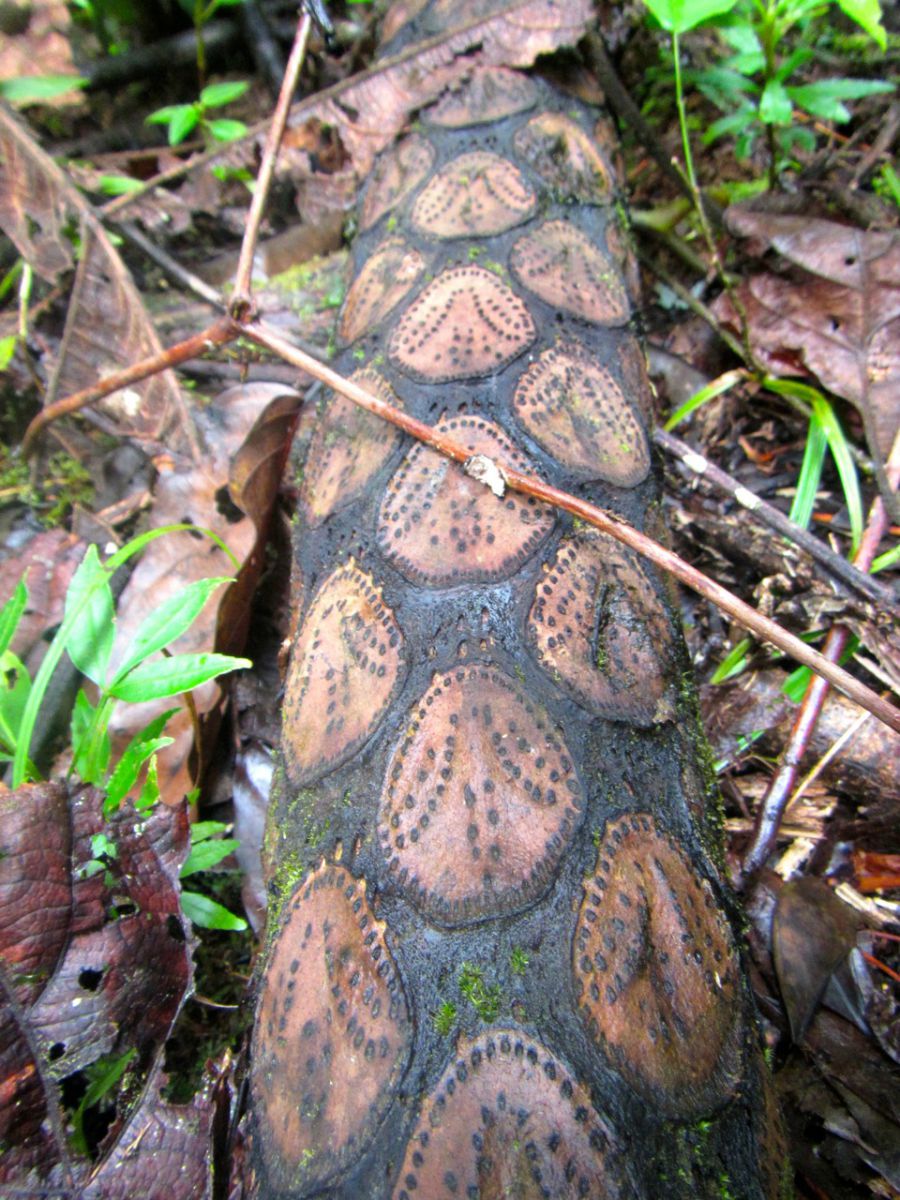
a parasitic plant, winding round the tree trunks strain towards the sun which doesn’t make it possible to throw a shadow as it is always overhead.
I still remember when taking part in the Live Parallel expedition two years ago I visited Tanzania, Olduvai Gorge, where we found the remains of the human primogenitor. It is perfectly clear and it is a proven matter that the equator, the tropics were the cradle of life on Earth where the daily and annual average temperature fluctuation does not exceed 1 degree and a half and it is always at the level of 37-38 degrees under 100% humidity. This provides conditions for a great number of mutations which in their turn give the richest diversity of species of plants, insects and animals which further survive or become extinct, in accordance with the theories by Lamarck and Darwin. HereinPapuathingsarethesame!
However, with a proviso: there have been no animals ever – this is a reservation, a territory cut off from the rest of the world by the tectonic fault of plates. Only the Papuans lived there whose ancestor was obviously an Australopithecuswho had come there before the plates fault and had lived in isolation. Having no opportunities to move to the north or to the south like in Africa but at the same time having found themselves under the ideal climatic conditions, the life on the island didn’t develop either in cultural and social aspects or in terms of biological evolution and in fact preserved undisturbed.
It’s hooot…
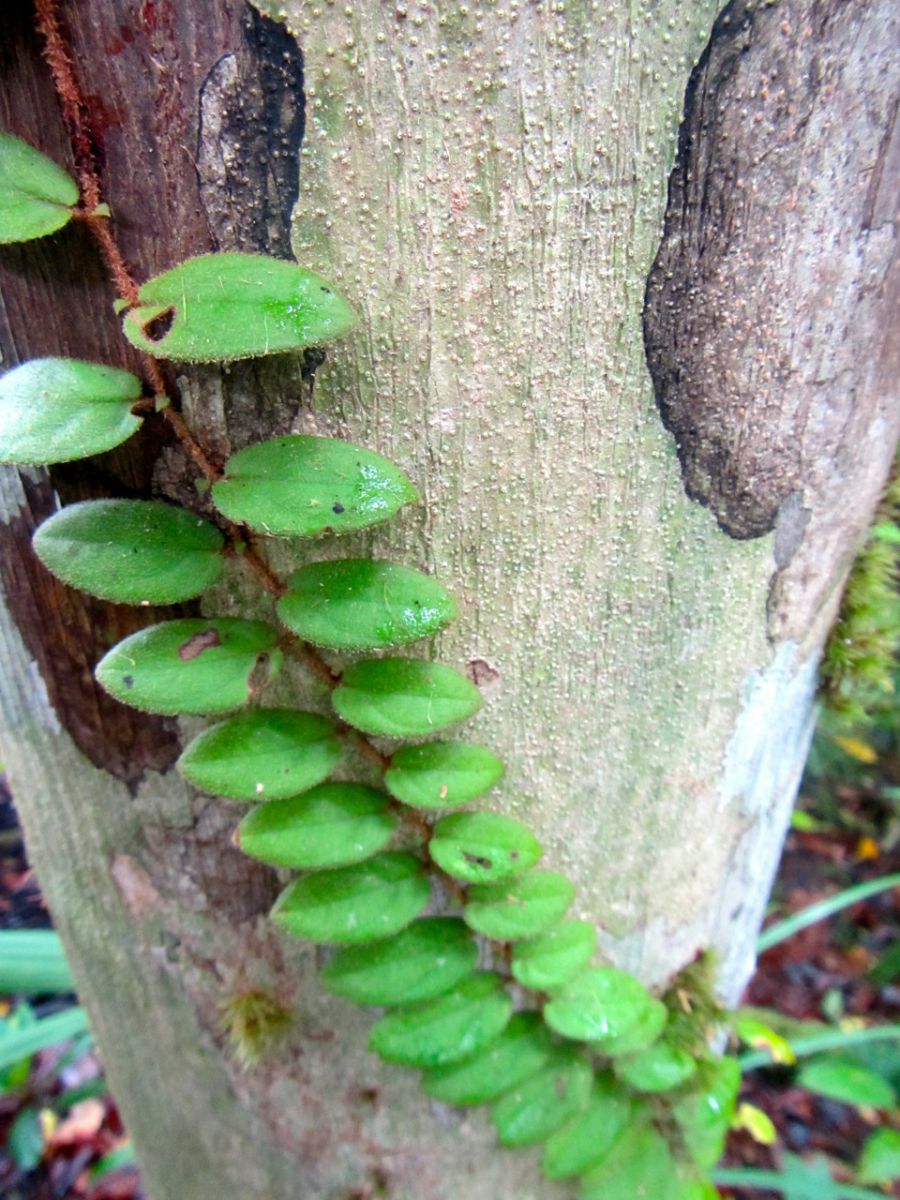
The extraordinary coloring of mushrooms reminds you of the fact that absolutely everything here is poisonous… It’shooot…
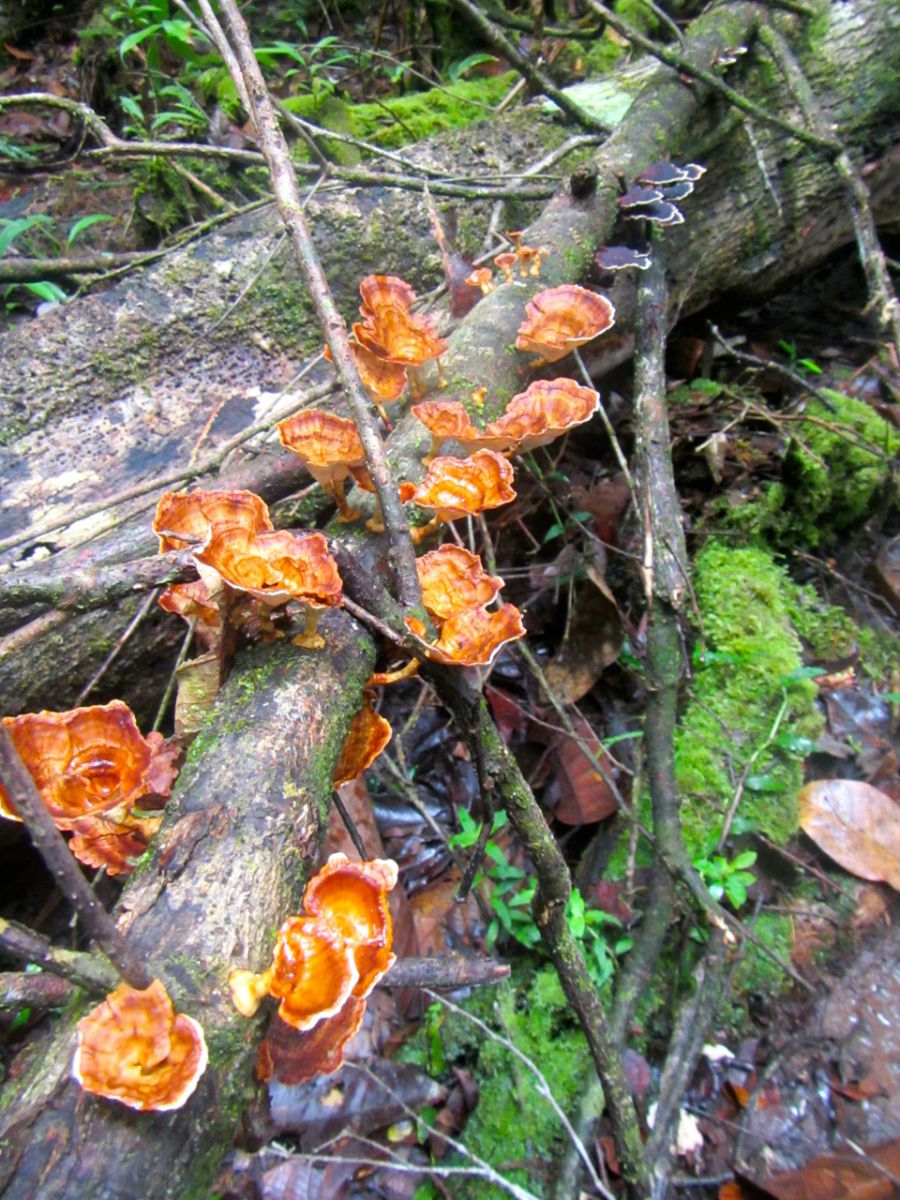
Forms and colors are blurring… Sweat makes my eyes tingle… I’m thirsty… and we are running out of fresh water… Wehavetogo! Why are wehere?! Oh, yeah, we are curious…
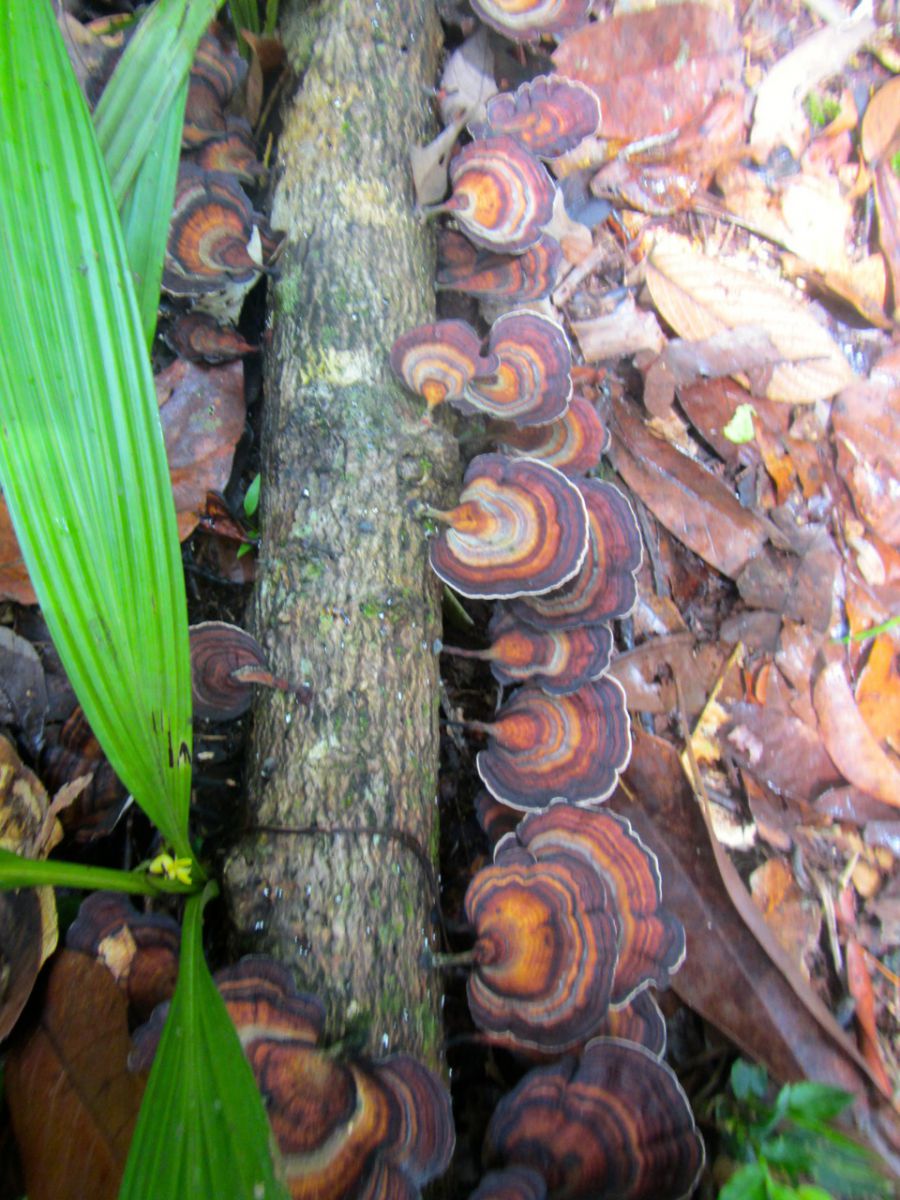
I guess, we are almost there… going further… the backpack is heavily pressing on me, let’s try to set back the shoulders… well, what’s this? Atree? Ouch! there are thorns in the arm… it hurts… in the conditions of such humidity the wounds start rotting quickly… It’shooot… I neeeed to drink…
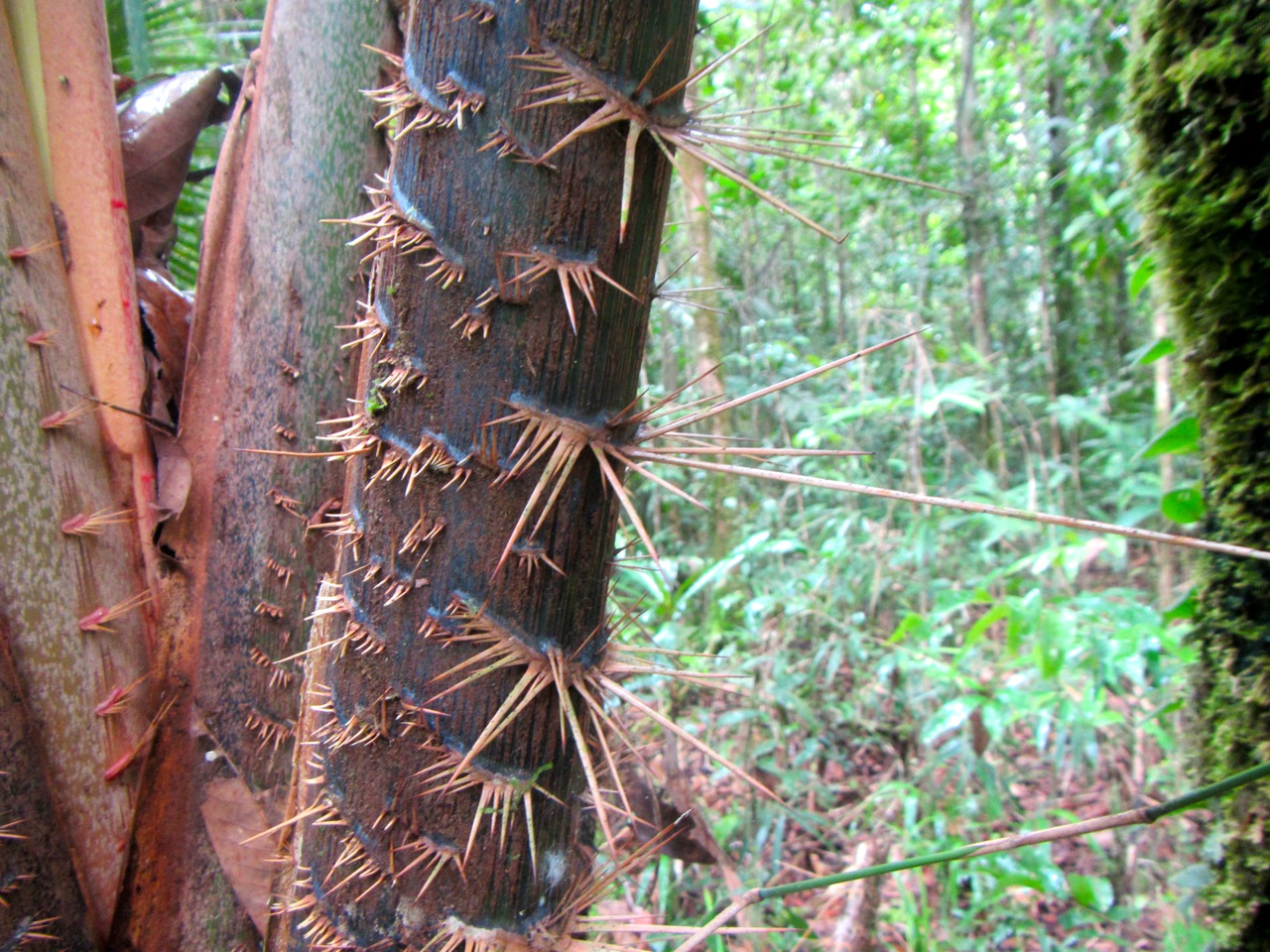
What is crawling over my hair? Indeed, here everything crawls on everything… There are more than 100 species of poisonous snakes and 40 species of bats here, and there have never been any animals here, even the primates! Have never been!

A stroke with machete, and a plant inhabited with ants is cut in two
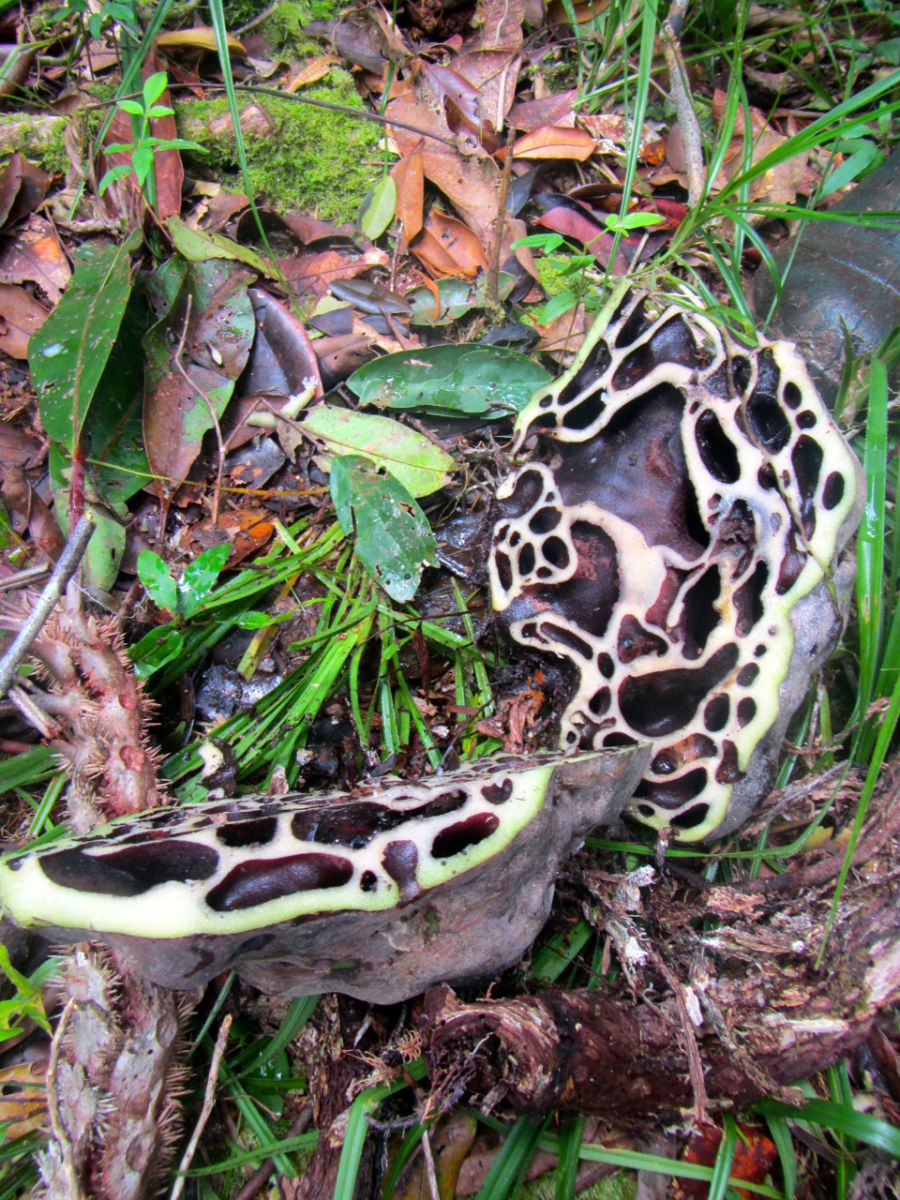
thus revealing a great number of the crawling creatures …
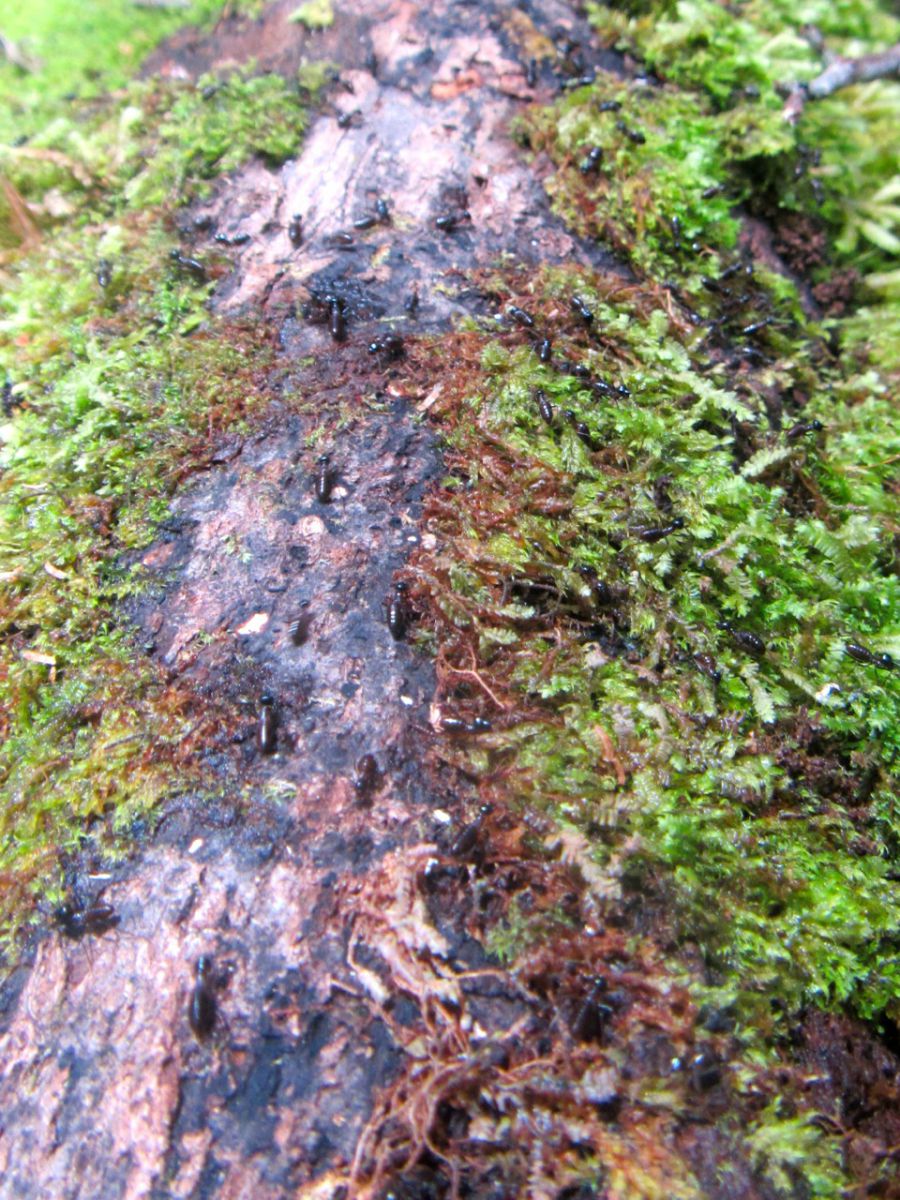
I understand that this ancient beauty should be guarded by someone, and here you can see hordes of such guards attacking and waiting in ambush…
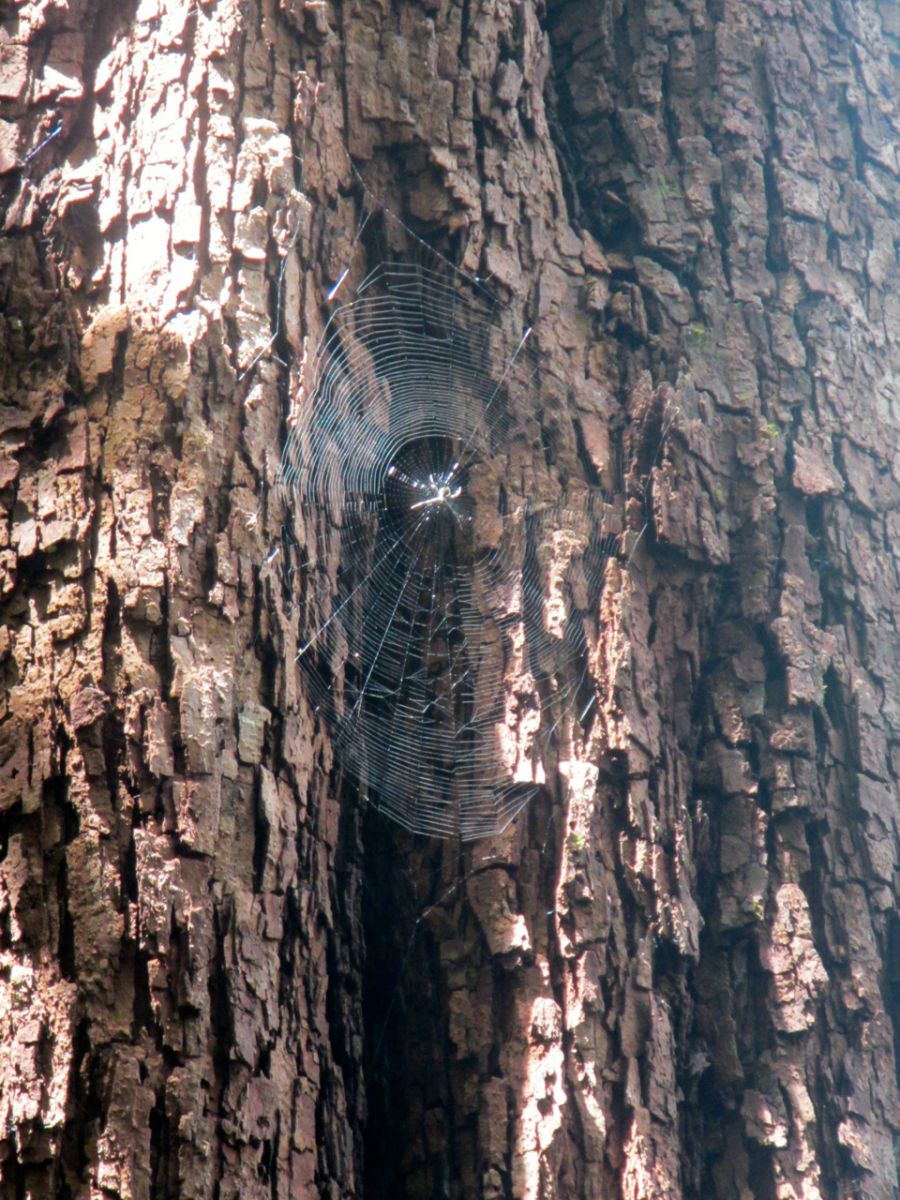
But we have to go... We are here not for the insects… my legs are refusing to move… mud… sweat… my mind is racing… step by step, I should think of something… of what?... It’s hot! What a word got stuck in my head! May be this is the last swamp… There must be the last one sometime…
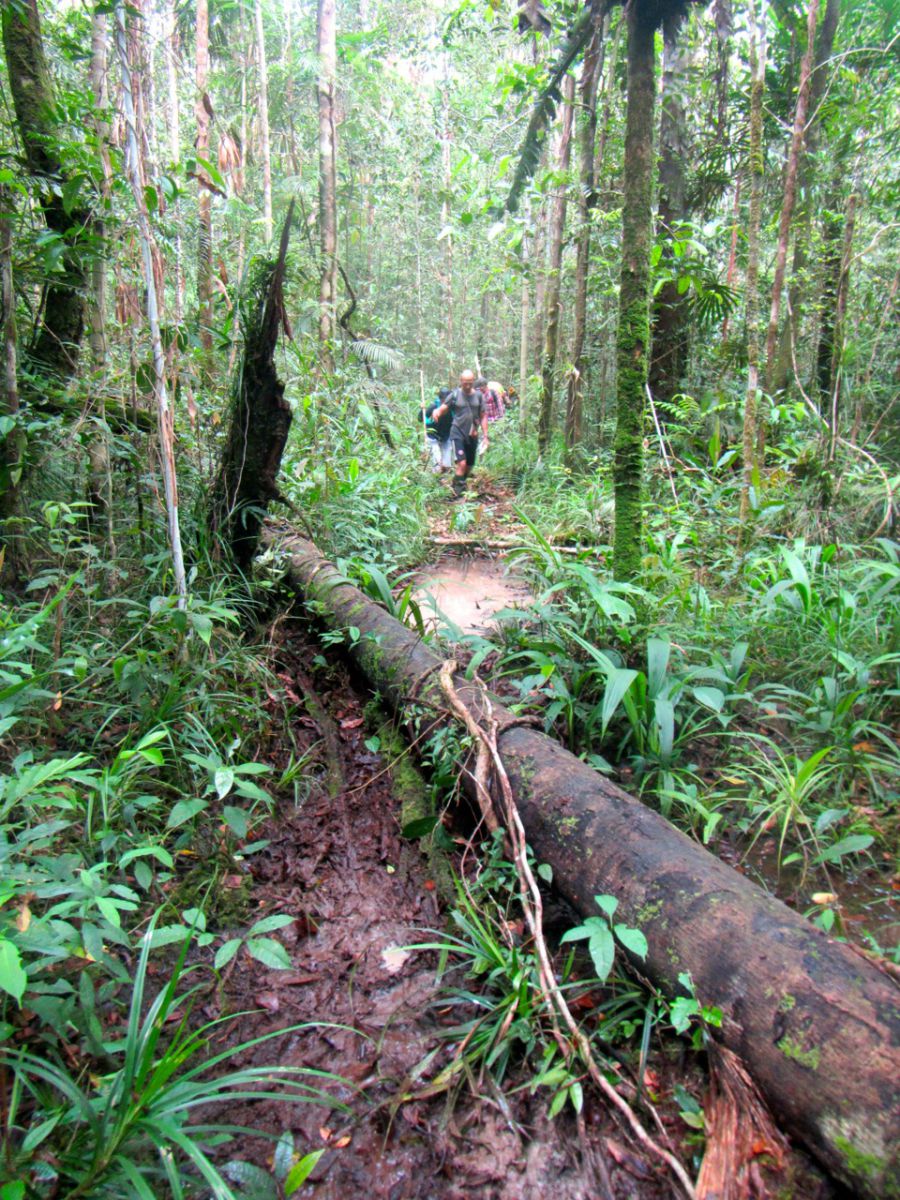
Hey, how many have we passed? 3 kilometers! How many? It’s noon now! We have been walk ingsince 5 in the morning!!! How can it be 3?! Please, lietome, say it is th..irteen…
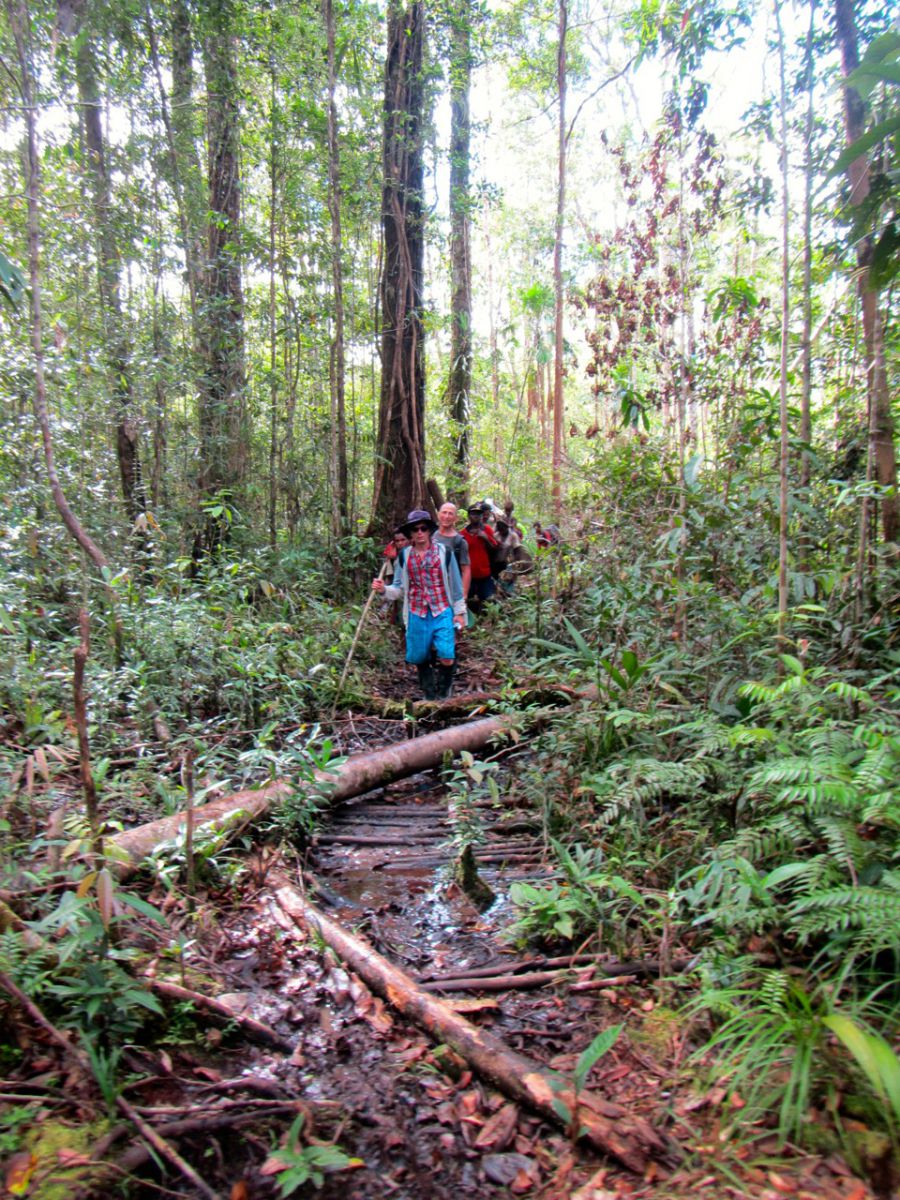
That’s enough! Leave us here… I’ll lie down and die… But how can it be… can it be here? Before your body gets cold it will be filled with maggots…
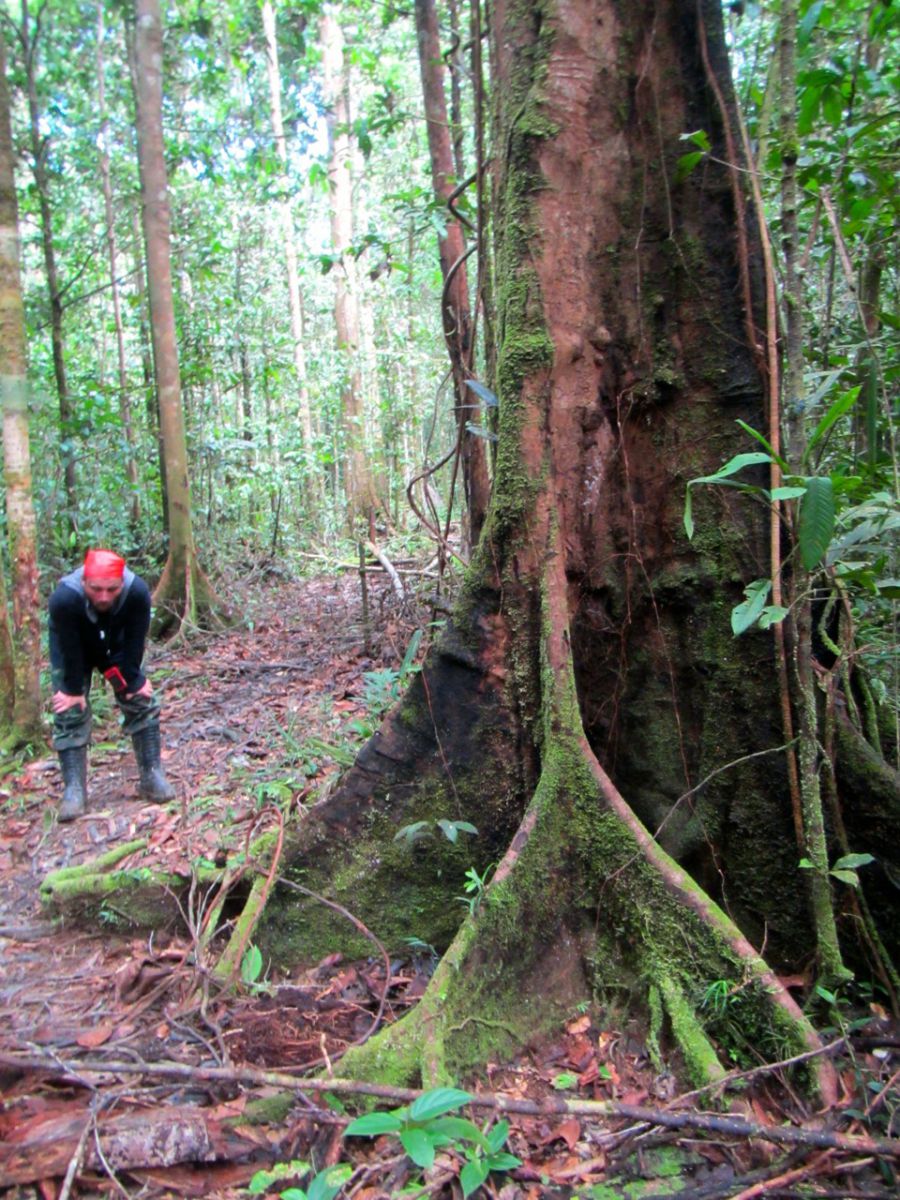
One of the Kapayaki or the Asmat people or of some other tribes may be aiming at me or my friends with an arrow at this very moment… Idon’tcare! Whatisitbeforemyeyes? Oh, yeah, again these carnivorous plants which feed on insects… Thereisalwayssomebodyeatingsomebody! The strongest survives, and this is a model of our life just from another perspective… This is all about us!!! Our concrete jungle is much more dangerous. If it is honest here about everything and if we go 15 thousand kilometers back home then in the concrete jungle which is familiar to us you can be “stung”, “bitten”, “eaten” or at worst… “laidmaggotsinto”. :)
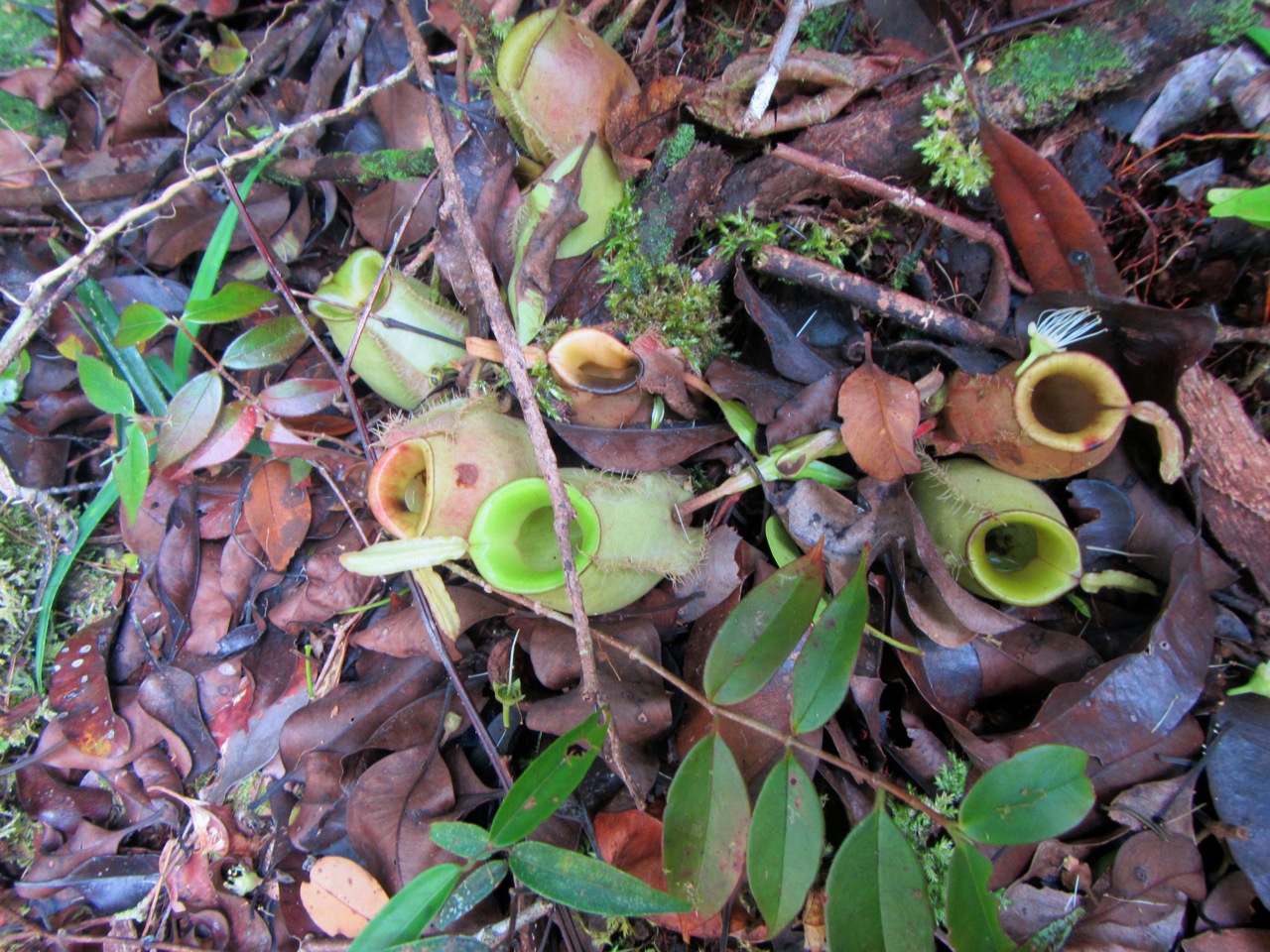
Aaa… here comes enlightenment when you get a second wind, you look upward – the sun shining through the leaves keeps on heating the humid air thus it grows thick as the foam…
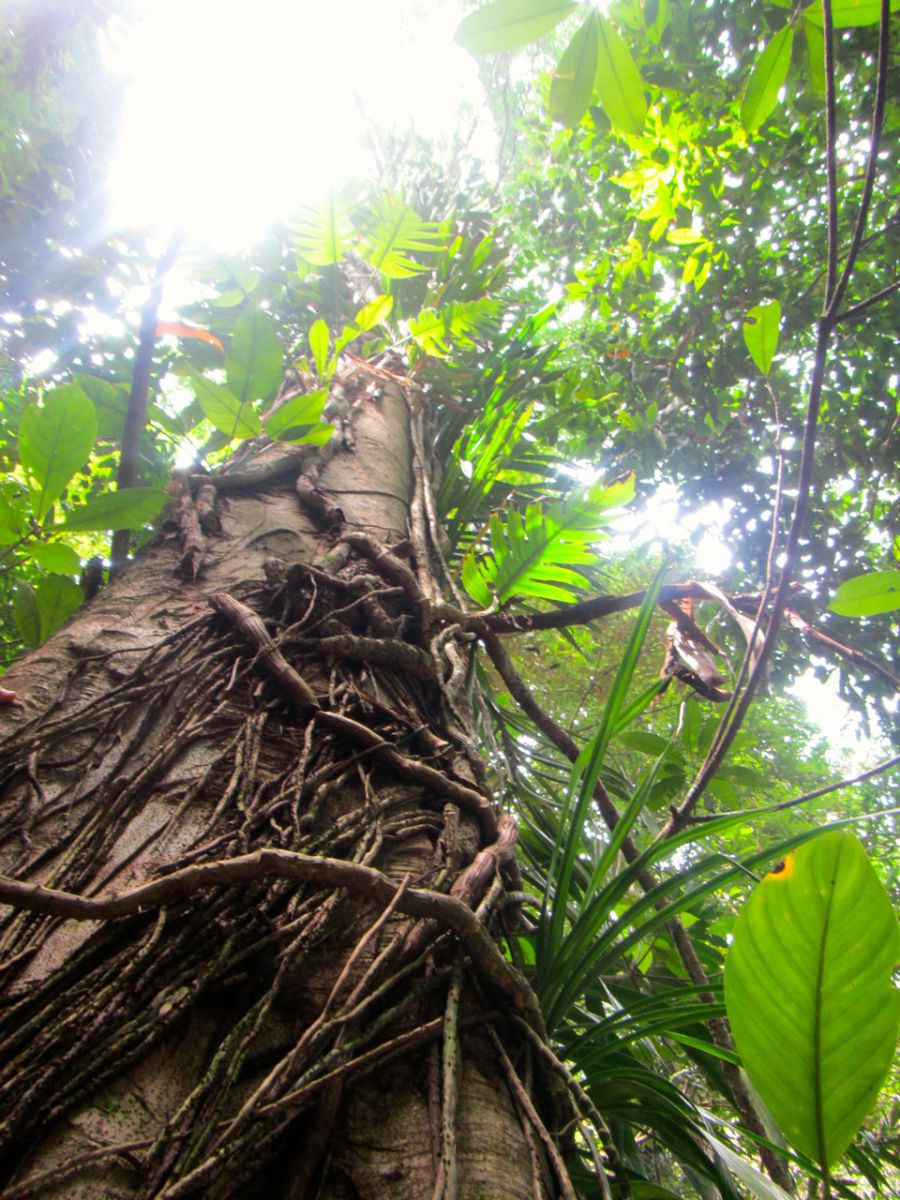
I remember being in the plane and looking at the sea of vegetation beneath I was thinking of where we were going and what a satellite phone with a SOS-button was for. In any case nobody would find us under this green cover.
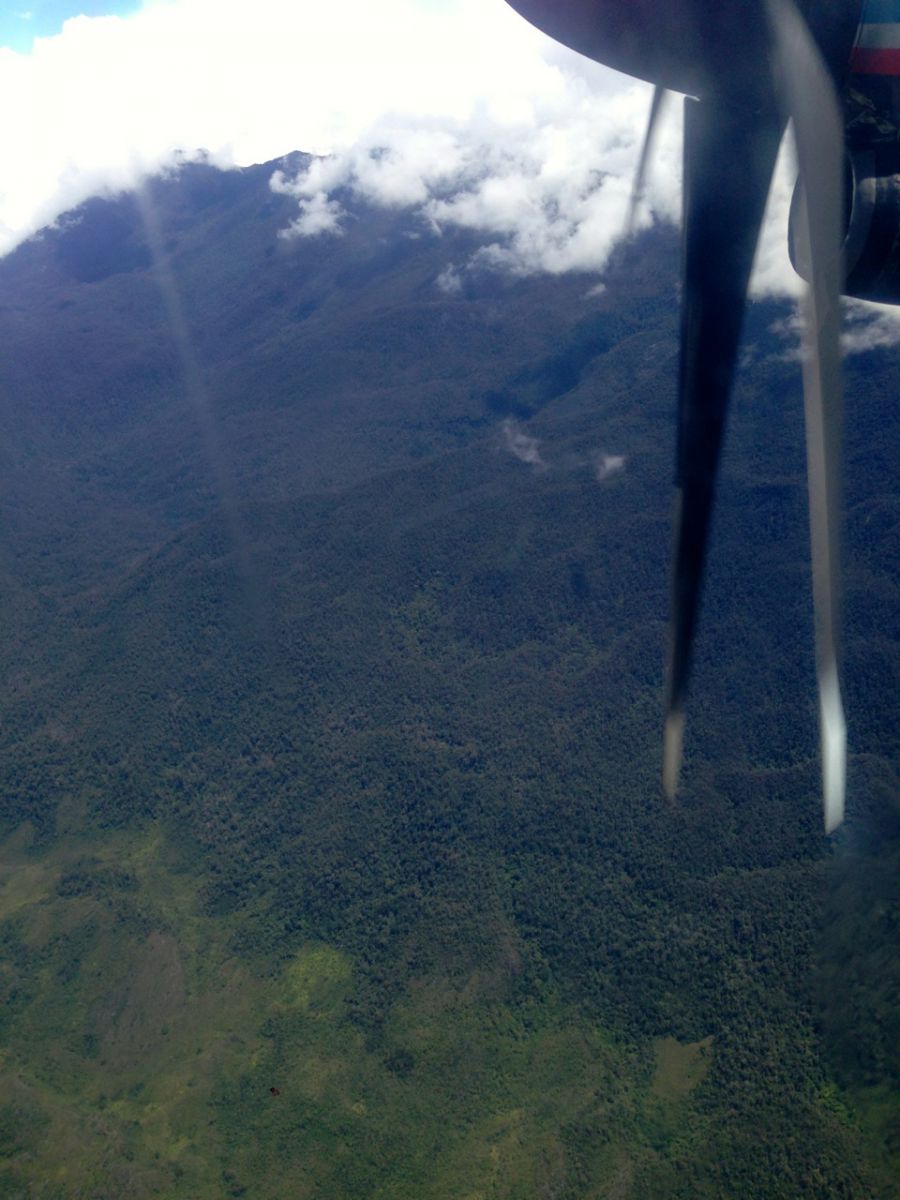
Well, that’s enough for the bad thoughts… Cannibals are waiting for us and we are standing here meditating. What cheering medication do we have in our first-aid-kit? Hormones? Eaten. Antibiotics? Used. Adhesive bandages? All applied… Some materials at hand? Oh, inflorescence of the sago palms!
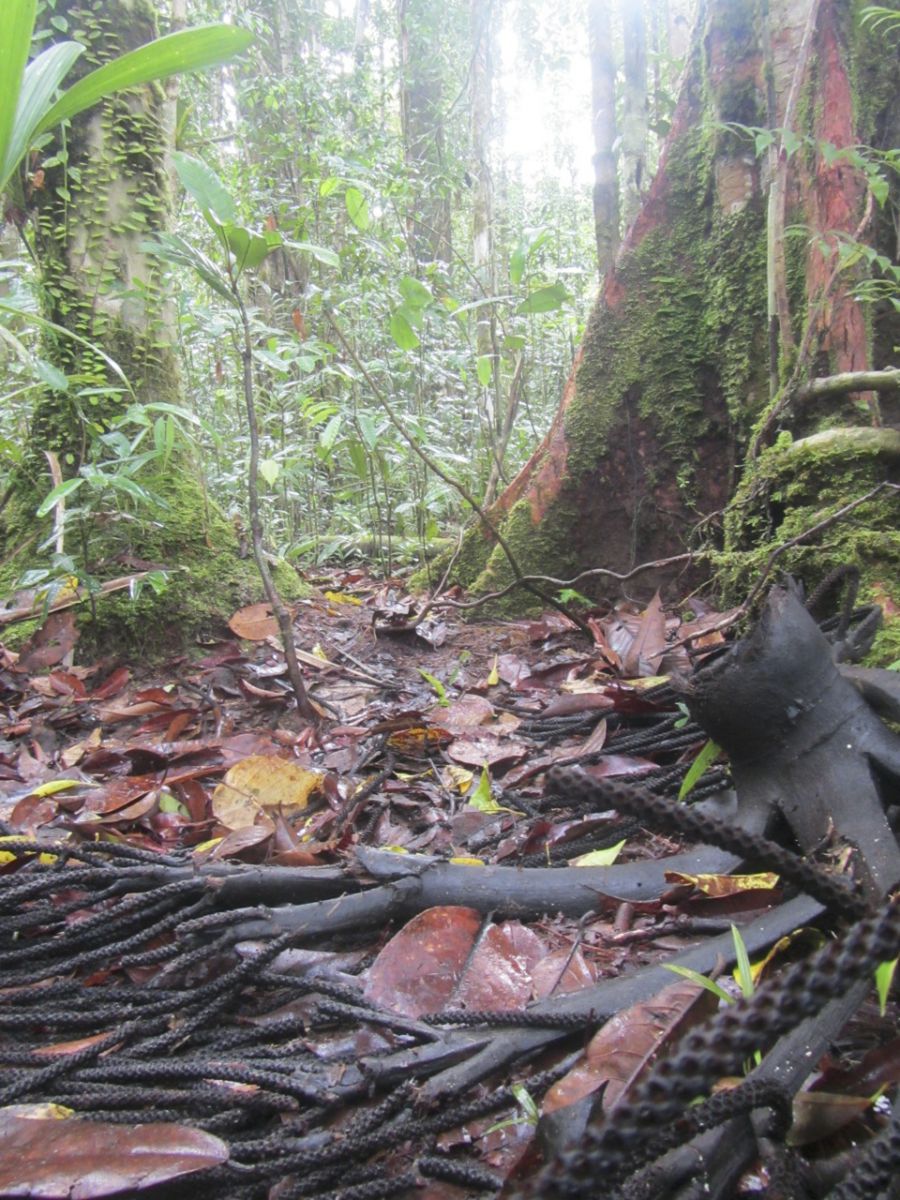
I remember an Indian wisdom “The arrival of a good clown into a village does more for its health than 20 donkeys laden with medicine!”
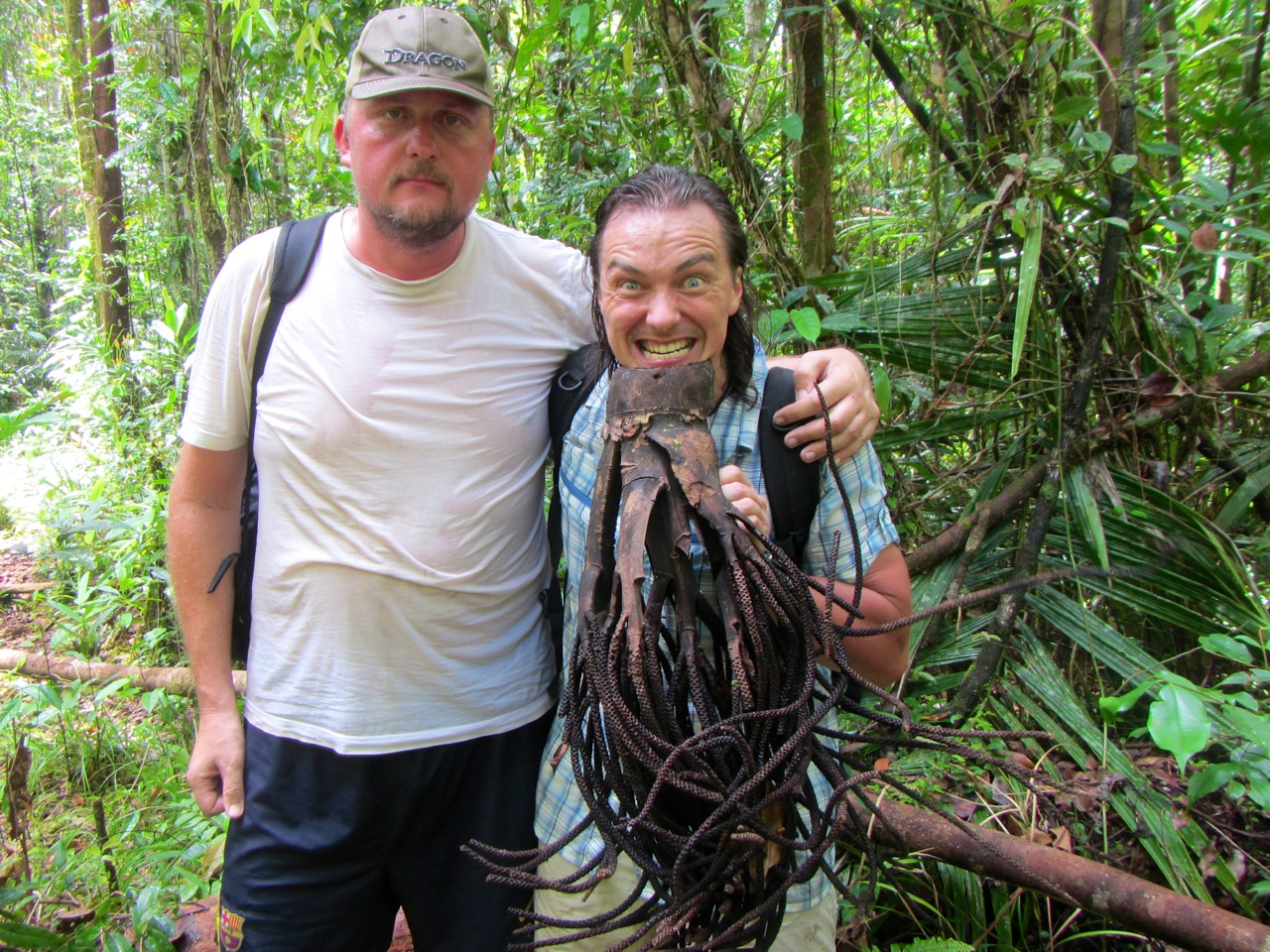
There now! It seems we have overcome a weak moment!
Nothing distracts from fancies better than work. Who is sitting next to me? This is Paulyus, a Papuan from the Chitak tribe who we took with us to help us carrying the things. Hefeelsevenworse. He has filiariasis (elephantiasis): you can see his swollen legs due to the lack of treatment. In a few months hundreds of maggots, which were brought there with a mosquito bite, will come out of these wounds. There is an army of mosquitoes here and they all transmit a great number of tropical diseases. We used insect repellents, I guess, for years to come. We will certainly help Paulyus – 2-3 courses of antibiotics and antiparasitic medications and he will be as if a new-born… until the next mosquito bite!
Meanwhile my friends helped our carriers with cigarettes and the latter were extremely happy about it. They supposed that the power of the fair-skinned people was in the smoke they inhaled… And we didn’t want to dissuade them from it! It was useless.
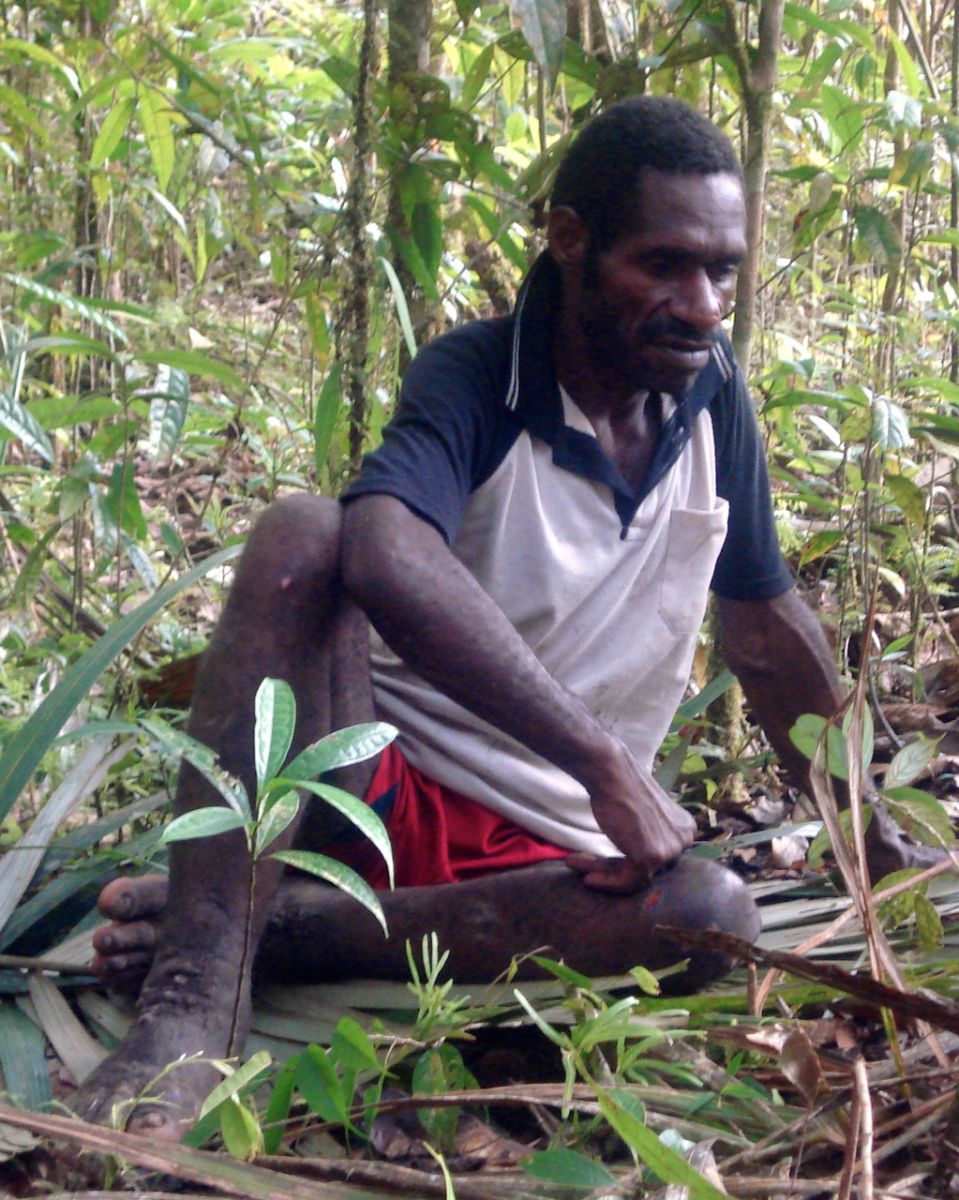
We are going further and the landscape is changing depending on the high or low grounds and it brings some variety. There is not much left, just 10-15 kilometers to the strains of the water sloshing in the boot… and a couple of night stops in the jungle. That’sall! :)
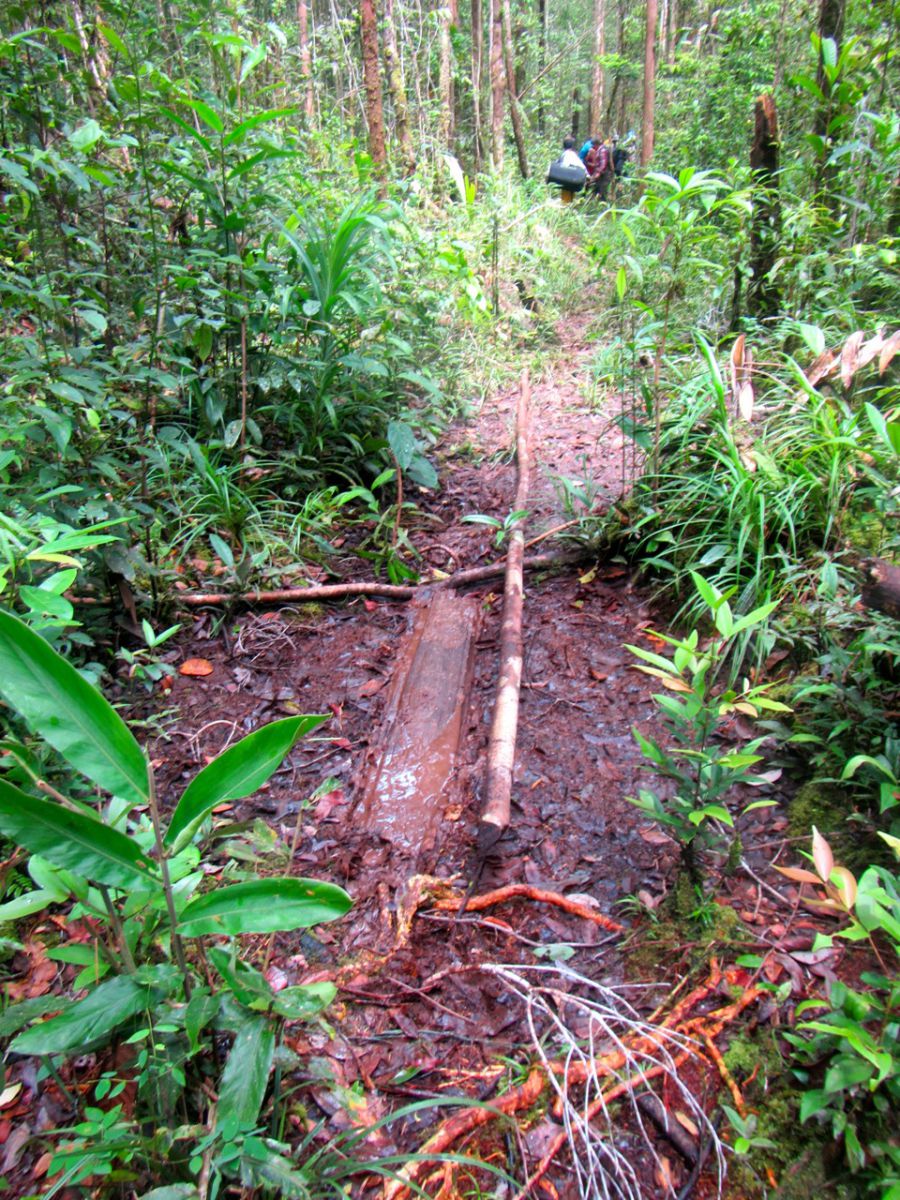
For the second day in a row we have been going to the most ancient tribe on Earth – the Korowai tribe where before the coming-of-age ceremony every boy must kill an enemy and bring his penis, testicles, ears, head or at least a lower jawbone. It is as dangerous as it is interesting…
And the first shock…
A glance to the right and the legs have grown numb out of surprise: two absolutely naked men are staring at you with that severe and self-confident look! Whatshouldwedo? Togreet? How? Likealiens? In a toneless voice, like we are the people from the Moon?… But our guide Anton, their jungle brother, diffused the situation at once having said something in the language of that tribe. It should be noted that about 900 tribes live here being at constant war with each other and speaking more than a thousand languages.
Moreover, I will repeat myself saying that they are not the “aboriginal” tribes who are usually shown to rich tourists but the true ones inhabiting the southern part of Archipelago Papua New Guinea far from civilization. Like thousands years before they live in the Stone Age.
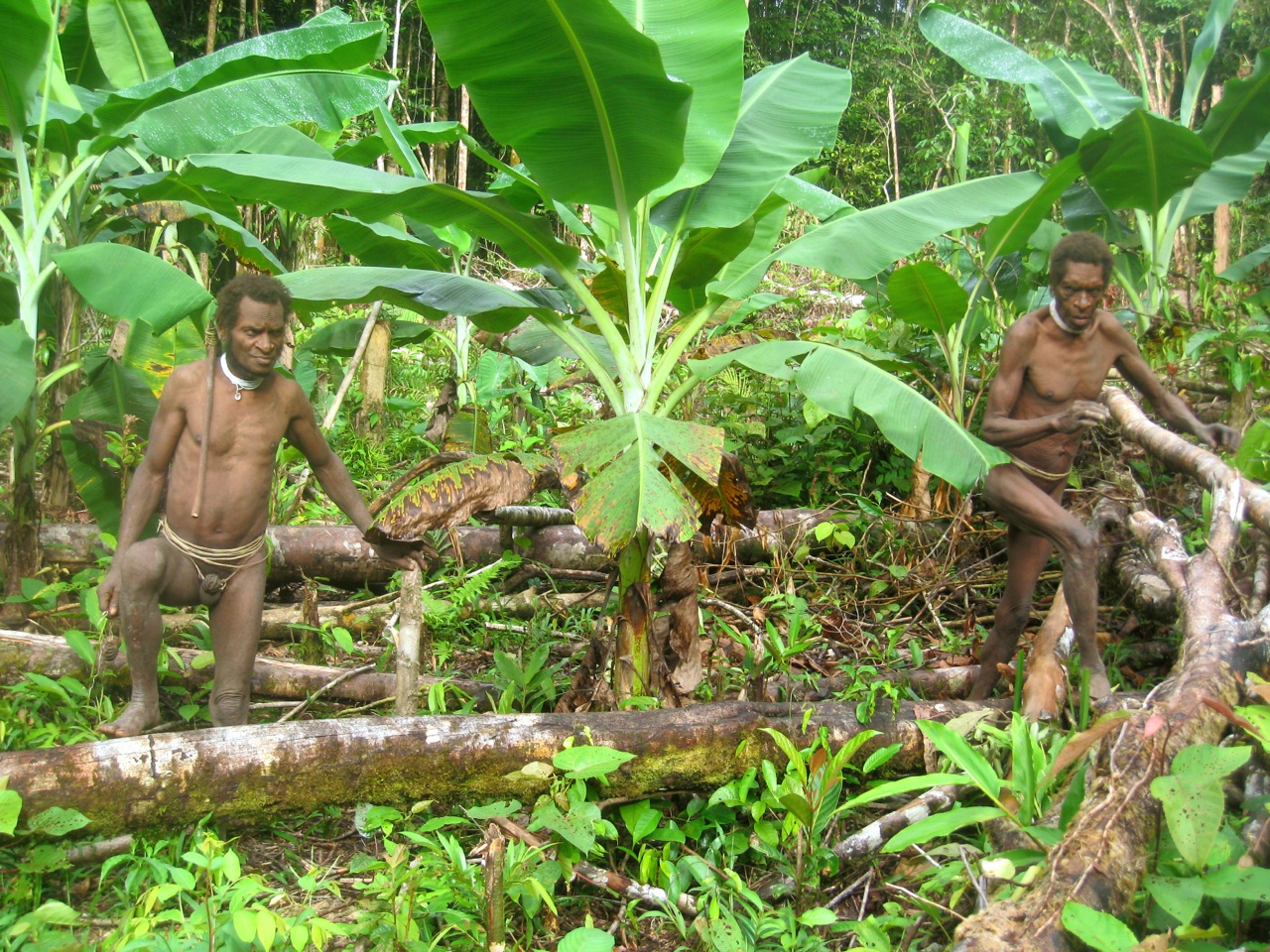
People from the jungle! Just think of this… They looked at us like at aliens scrutinizing and touching our skin and hair with their fingers with 3-cm-long nails. They were all covered with ulcers and fungal infections from head to toe. It is obvious there is no medicine, sanitation and even simple hygiene here.
I have told you many times about Anton, he played several parts for us: of a guide who had a good sense of direction in the jungle; of a Korowai tribesman being a guarantor of our safety; and of an interpreter from Indonesian into the tribe’s language. But for him we wouldn’t have moved into the jungle.
Anton is 23 and he has assured us that they do not kill their friends. I’ve nearly calmed down! :) Once in the evening sitting by the fire we started talking and our dialogue was as follows: a question in Russian was translated into English, then from English into Indonesian and from Indonesian into the Korowai language. An answer returned in chain. Nevertheless, using this “broken telephone” we tried to grasp everything and learnt much new information and a lot of shocking facts about our guide’s life. Anton told us that when he had been with his tribe the enemy tribe – the Kapayaki tribe – had abducted his sister and he had sworn to kill a Kapayaki in revenge. Four years ago, he added, he killed a Kapayaki man and ate him. “Howcome!?” We had hardly escaped from the first shock to get to know something like this! This man spent several days with us, he shared food and shelter with us and he was the guarantor of our safety!
We had hardly escaped from the first shock when Anton continued his story. According to him the Kapayaki people came for revenge, but his parents were very weak and couldn’t run into the jungle. Thus Anton made a decision and carried it out at once: he banged the parents’ heads and sucked out their brains not to leave their souls to the Kapayaki men. Our guide showed us how he did it: he pierced a hole in the temple on one side of the head and did the same on another side – he knew where to pierce. And he just sucked out the brains like the sweetened condensed milk out of the tin. We replied: “How could you eat the parents?” And we were astonished by his answer: “I took their souls with me not to leave them to the enemies”. These were the words of the man who was considered civilized. We could only guess what tomorrow would bring us…
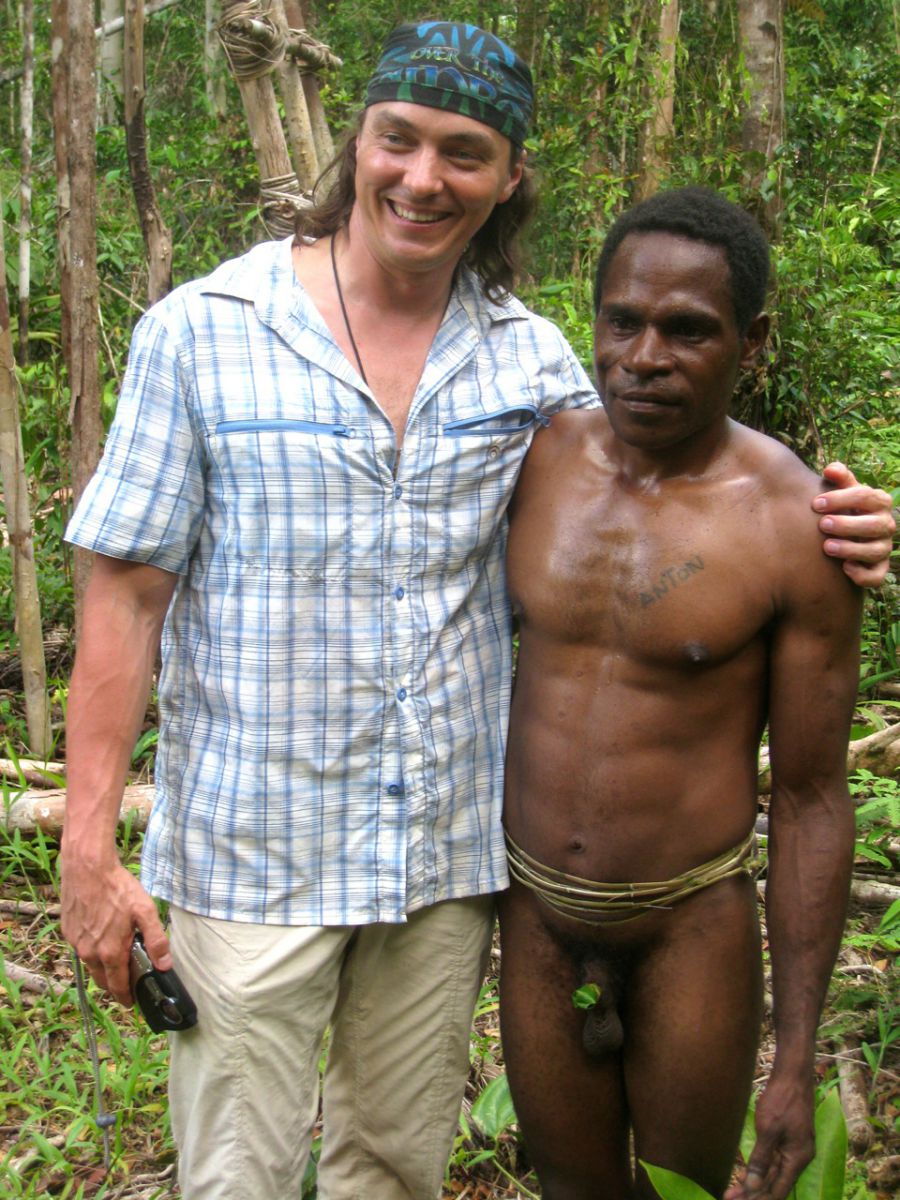
The Korowai people live in houses built on tops of the highest trees. This helps them stay alive during wars with the neighboring tribes. At a height they can easily defeat their enemies with a bow. By the way they shoot quite well.
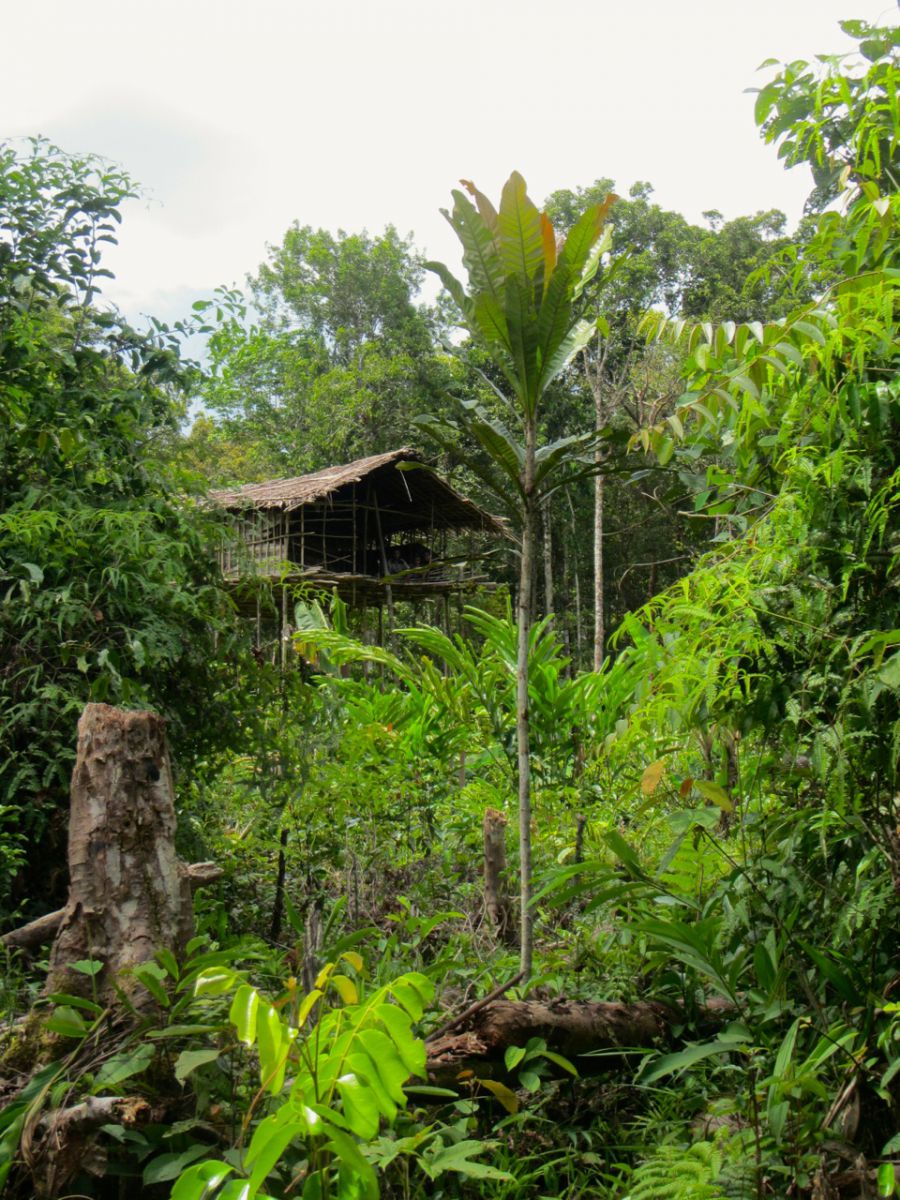
A family of 5 (a man, several wives and children) can build this house within 3 weeks. Some of these houses are at a height of 50 meters.
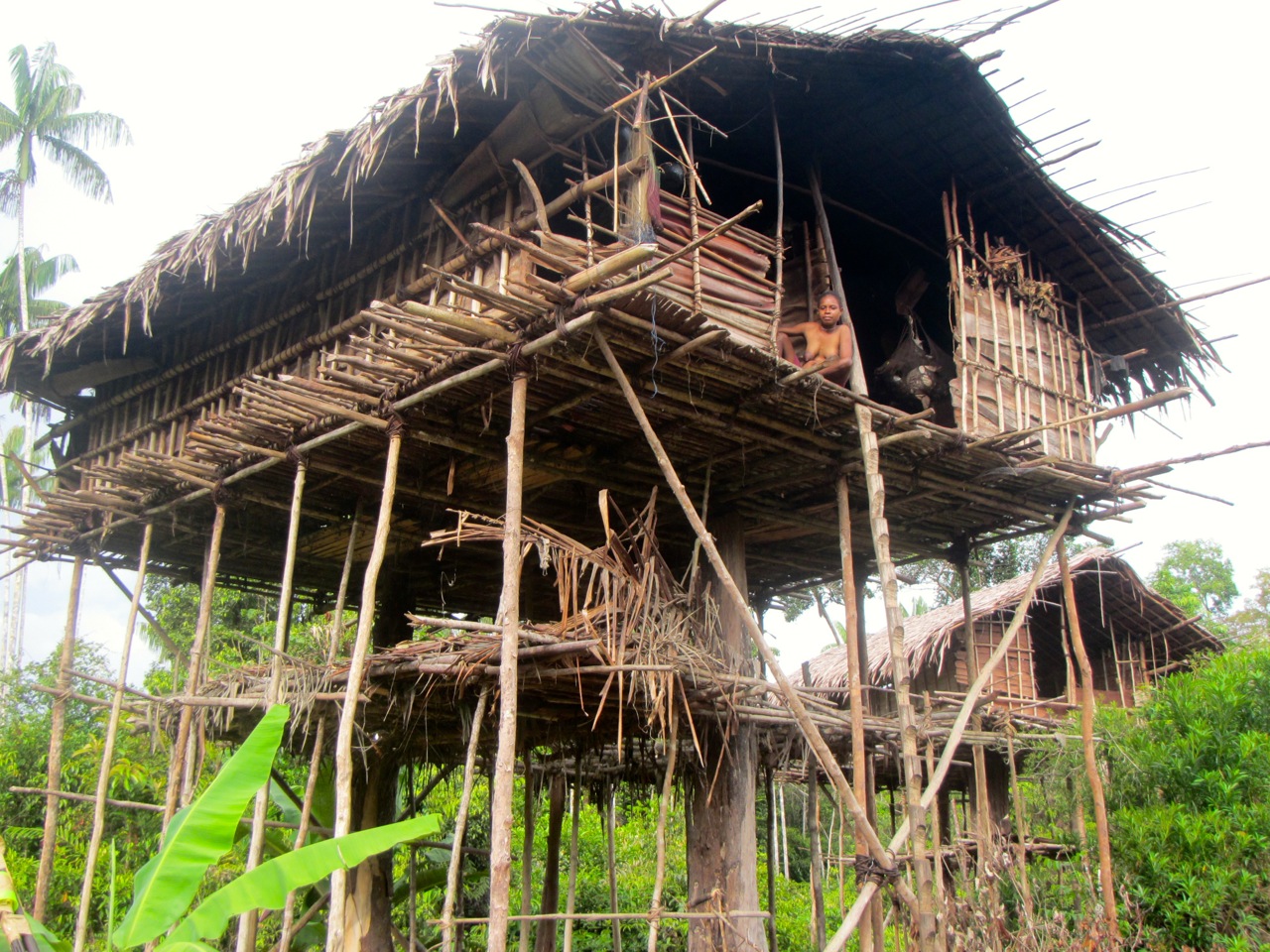
Believe it or not, but the constant tribal warfare taught them to build such shelters. It is impossible to climb such a house without waking up its inhabitants!
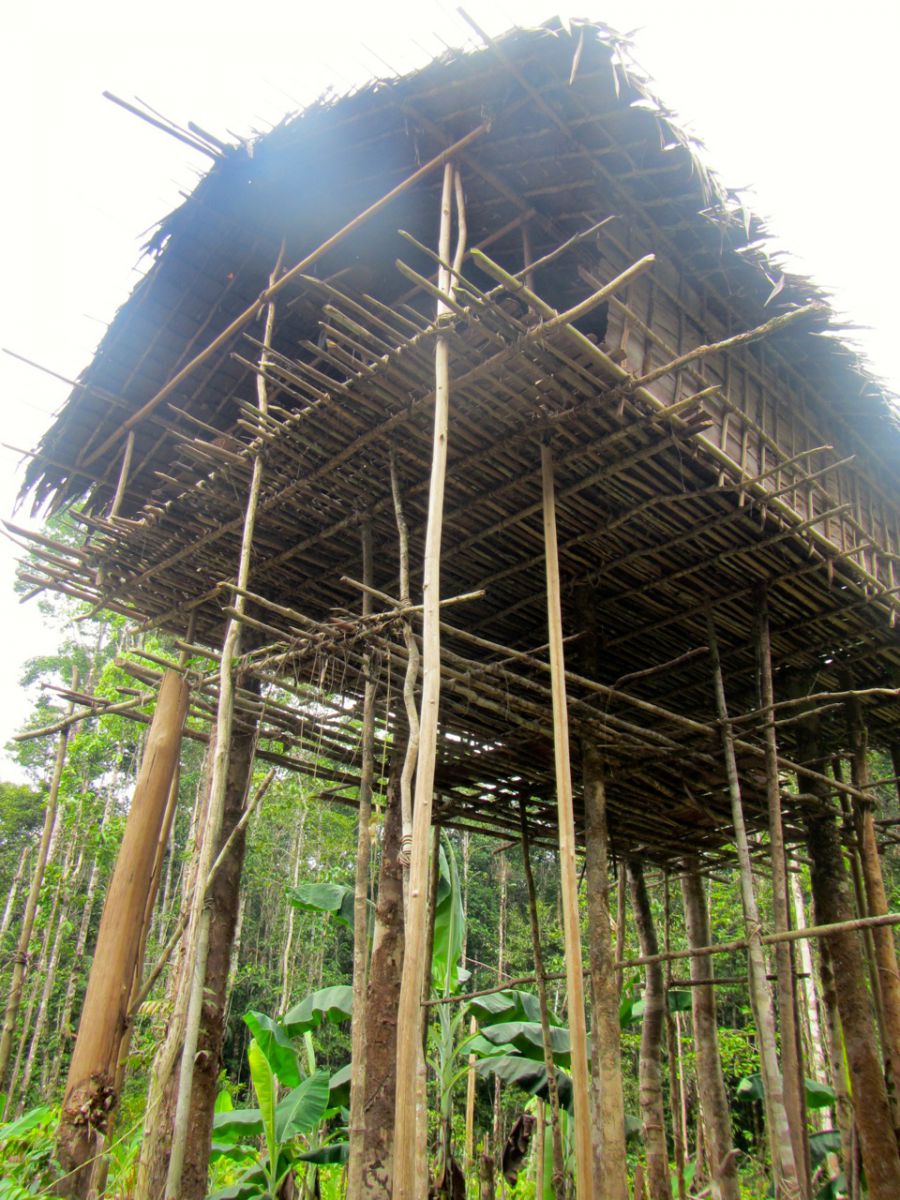
If a family member dies he/she stays in this house and the whole family leaves it and builds another one.
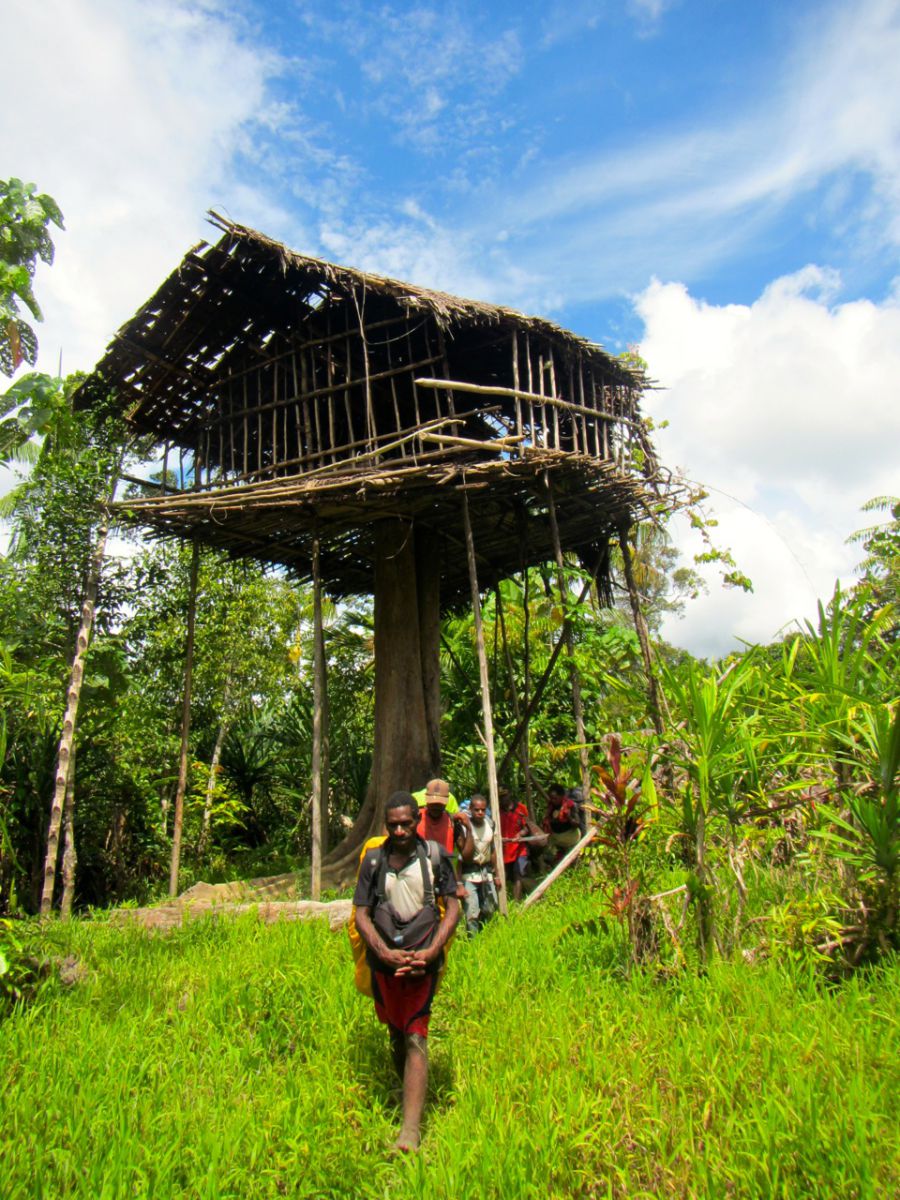
Things will never cease to shock me! At these moments you never think of taking a good photo…
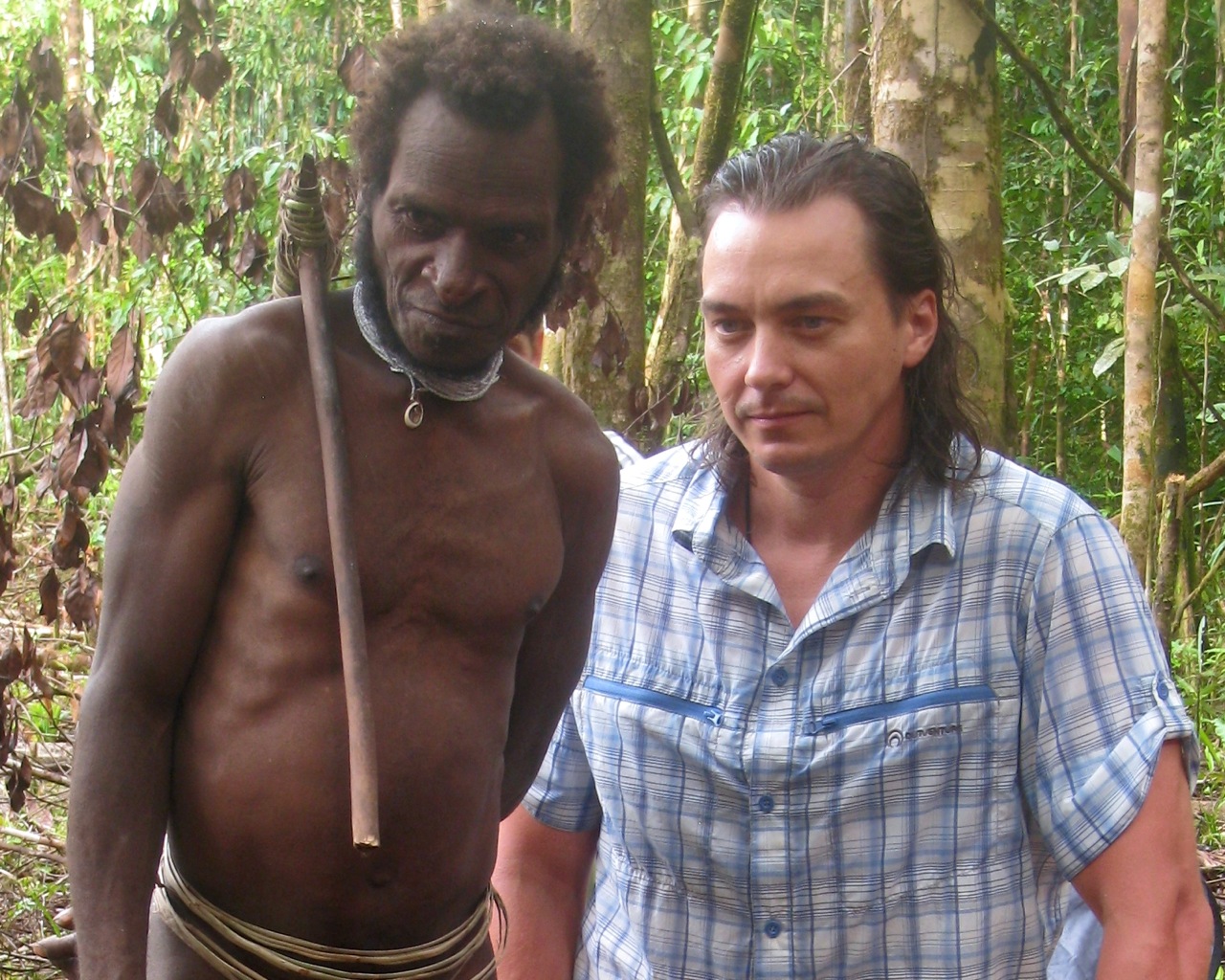
The Korowai people are not tall – no taller than 150-155 cm. All the Papuan aboriginal inhabitants possess specific facial characteristics – they are the only ones who have a square lower jaw bone like an Australopithecus. The Korowai men mostly wear a small leaf, a walnut shell or a dried-up pumpkin which covers the penis, and the women at the best case wear an inflorescence of the sago palm at waist in the form of a skirt.
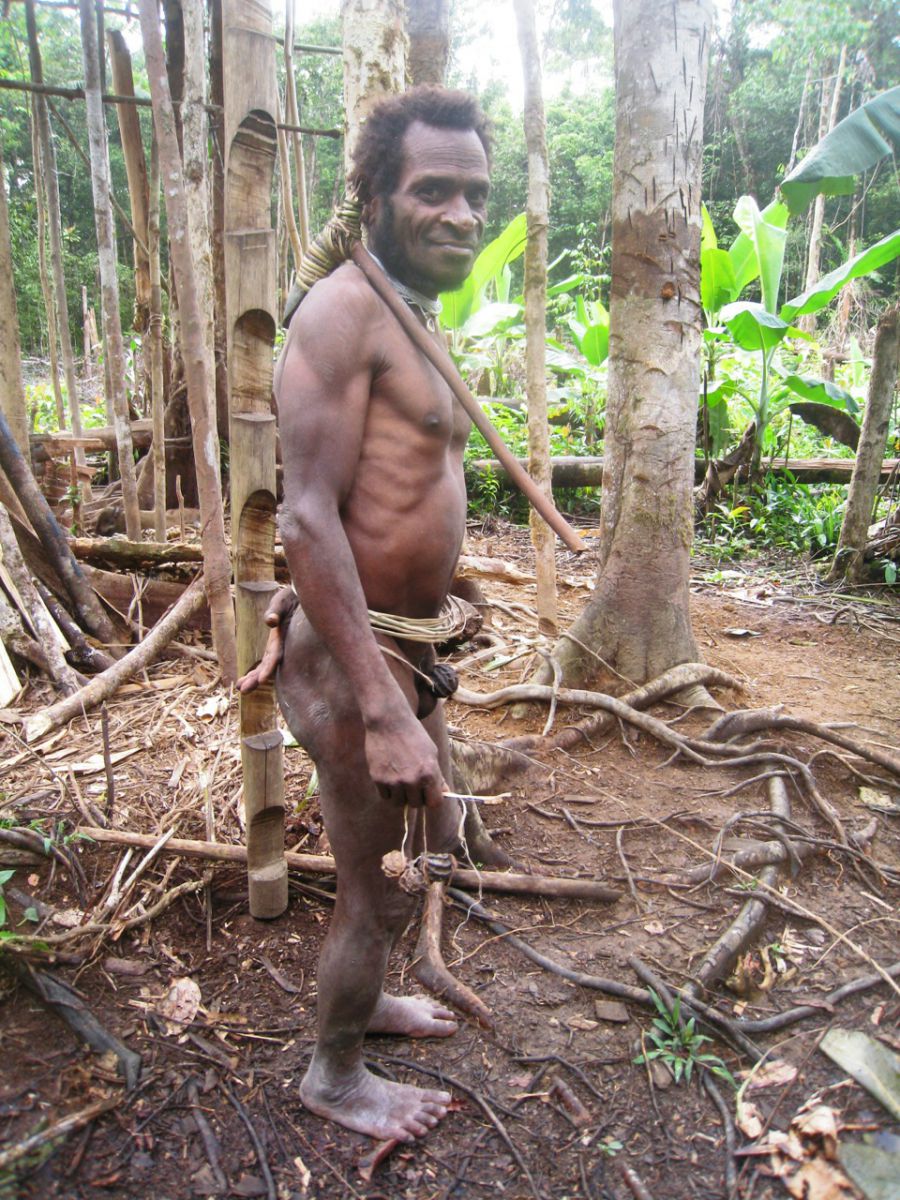
All the aboriginal inhabitants wear a rattan thread at waist which helps them to start up fire. Under conditions of high humidity lighters will produce no fire – everything is wet. During frictions the rattan thread first dries up the wood and then inflames it. The Korowai people manage to make a fire in a minute. I couldn’t make a fire with a lighter even within 10 minutes.
The Korowai people still practice cannibalism. This is not about their lust for blood but about hunger! Generally, there is no food in the jungle which the European people are used to. If the Asmat and the Kapayaki people living by the river catch fish and crocodiles the Korowai people living deep in the jungle feed on insects which they gather with a feedbag while walking along the path. They eat various spiders and other insects looking like grasshoppers, bugs, locusts, cicadae, in other words, everything that moves and crawls. That is why any meat is a delicacy for them. Whether it is a human being or a cassowary – a bird of 1.2 meter high, one of the most ancient creatures on Earth living since the age of dinosaurs. It resembles an ostrich but cannot fly though it is good at running and is capable of killing a man with a kick of its leg. There are also bats. The Korowai people use their little bones to insert into the pierced nasal septum.
.jpg)
We got on well quite soon though the feeling of danger didn’t let me go for a single minute.

There was a moment when our guidepulled me aside and insistently said: “Stop smiling!” It turned out that for the Karawaipeople a smile looked like a grin, the demonstration of teeth which meant aggression. That’s why they couldn’t understand why I grinned at them and they were about to feel uneasy. And the conflict which nearly started was settled… with a joint photo and the presented cigarettes.
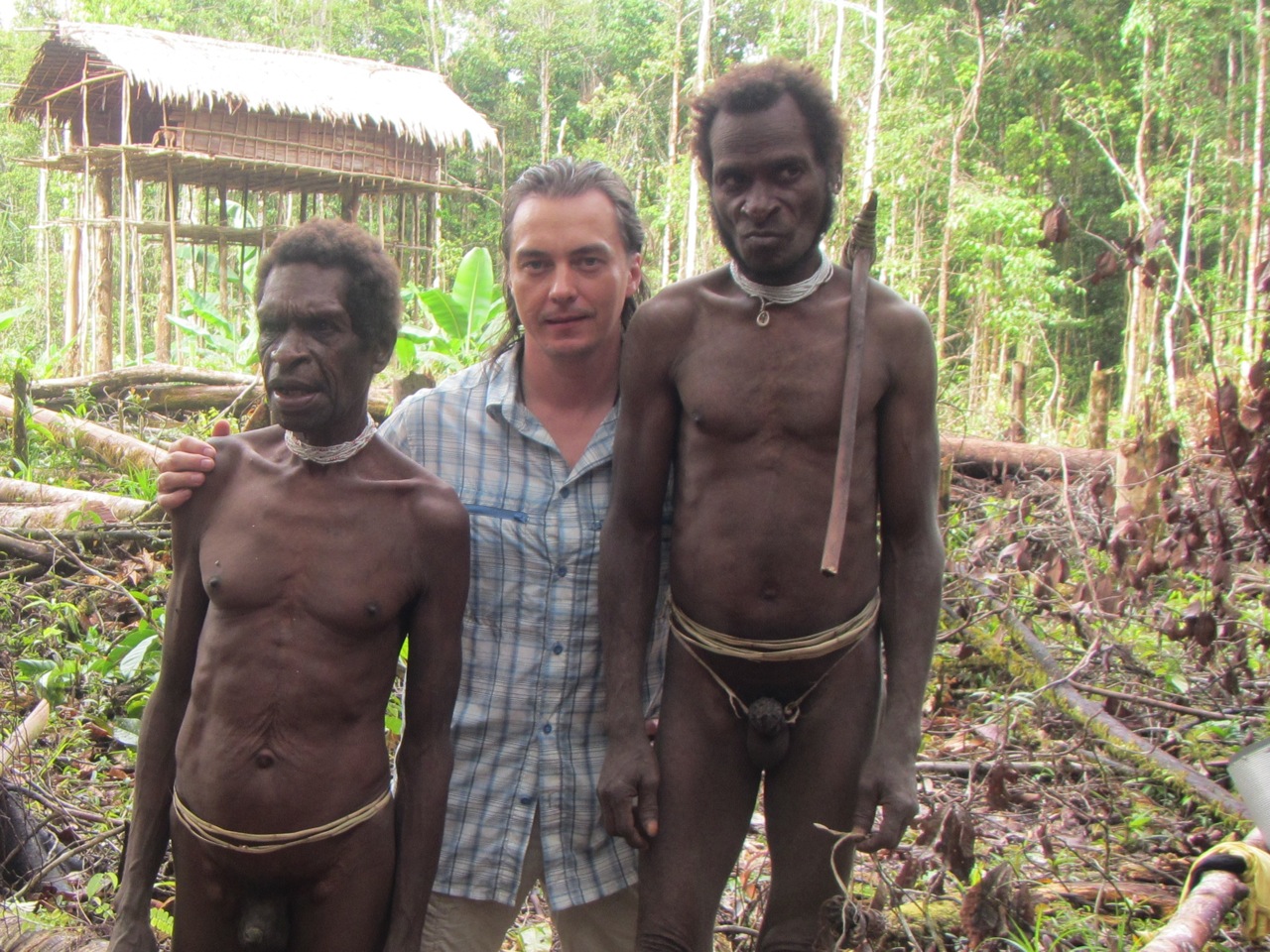
But one thing is even more interesting. Do you remember I’ve mentioned above that our cook Theron (a Papuan from the mountainous Lani tribe) was going to face a surprise? Well, if the Korowai people regarded us as aliens they looked at him as if he was… apieceoffood. They were literally drooling. This is a momentous photo! We’ve saved Theron! :)
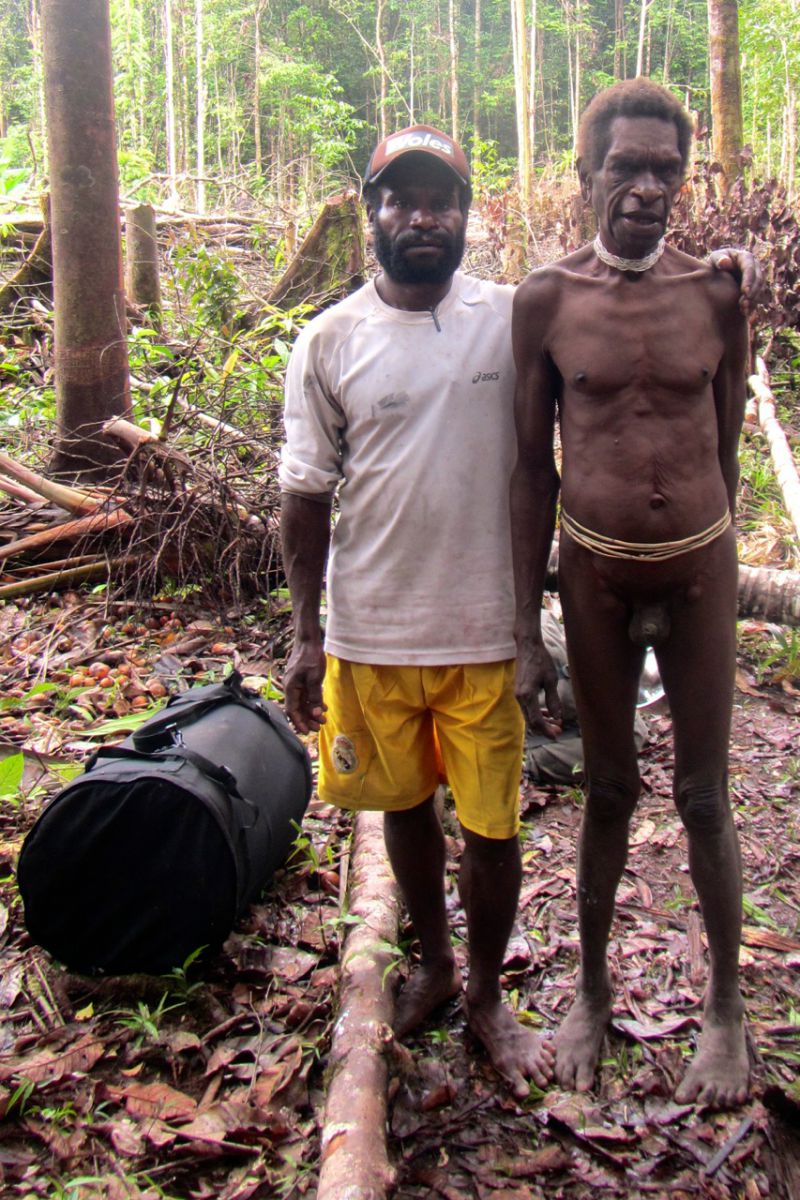
We got acquainted quite easily and we were invited in. When we were reaching the dwelling something in it made us feel uneasy but despite this…
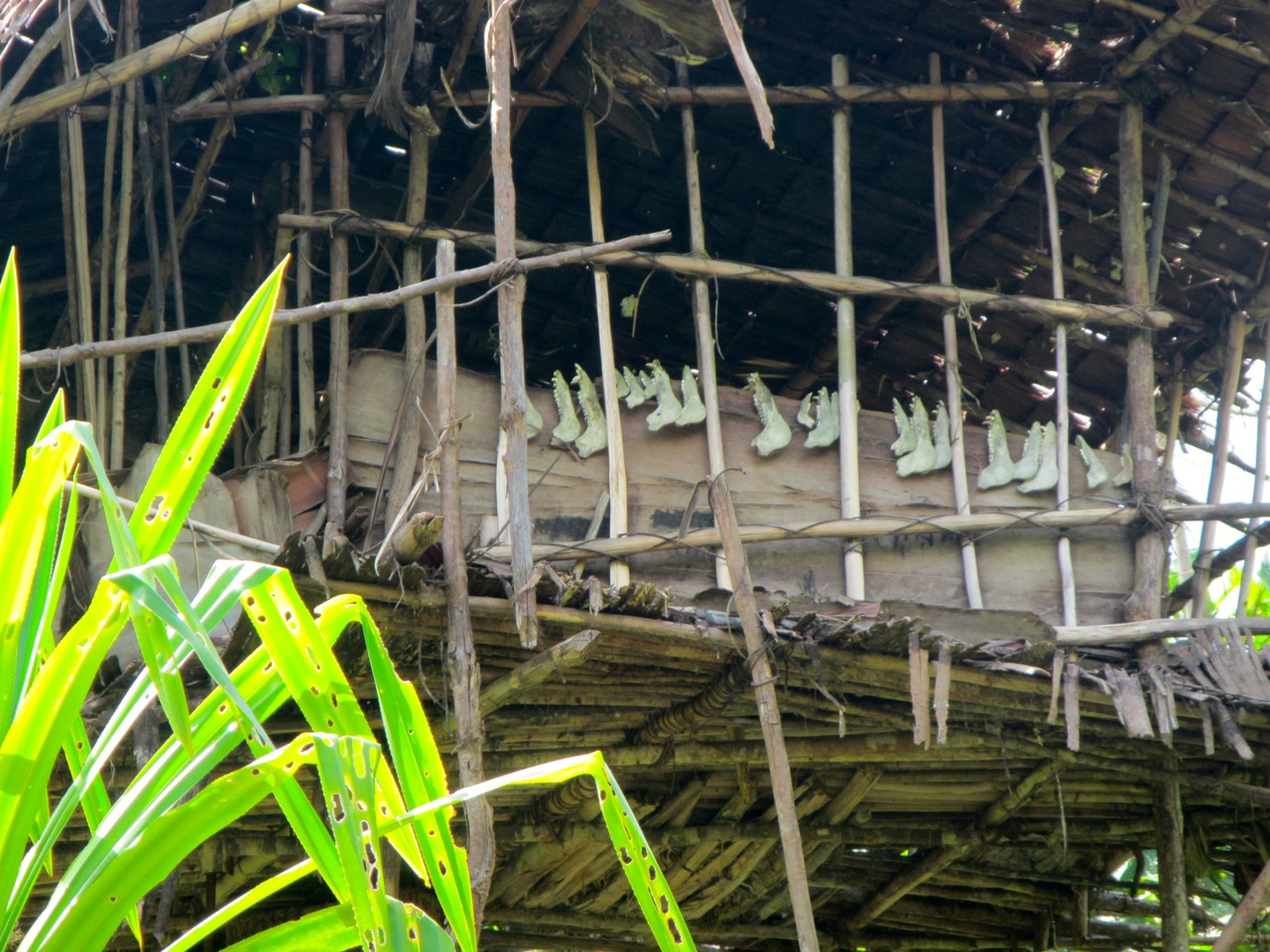
we accepted the invitation.
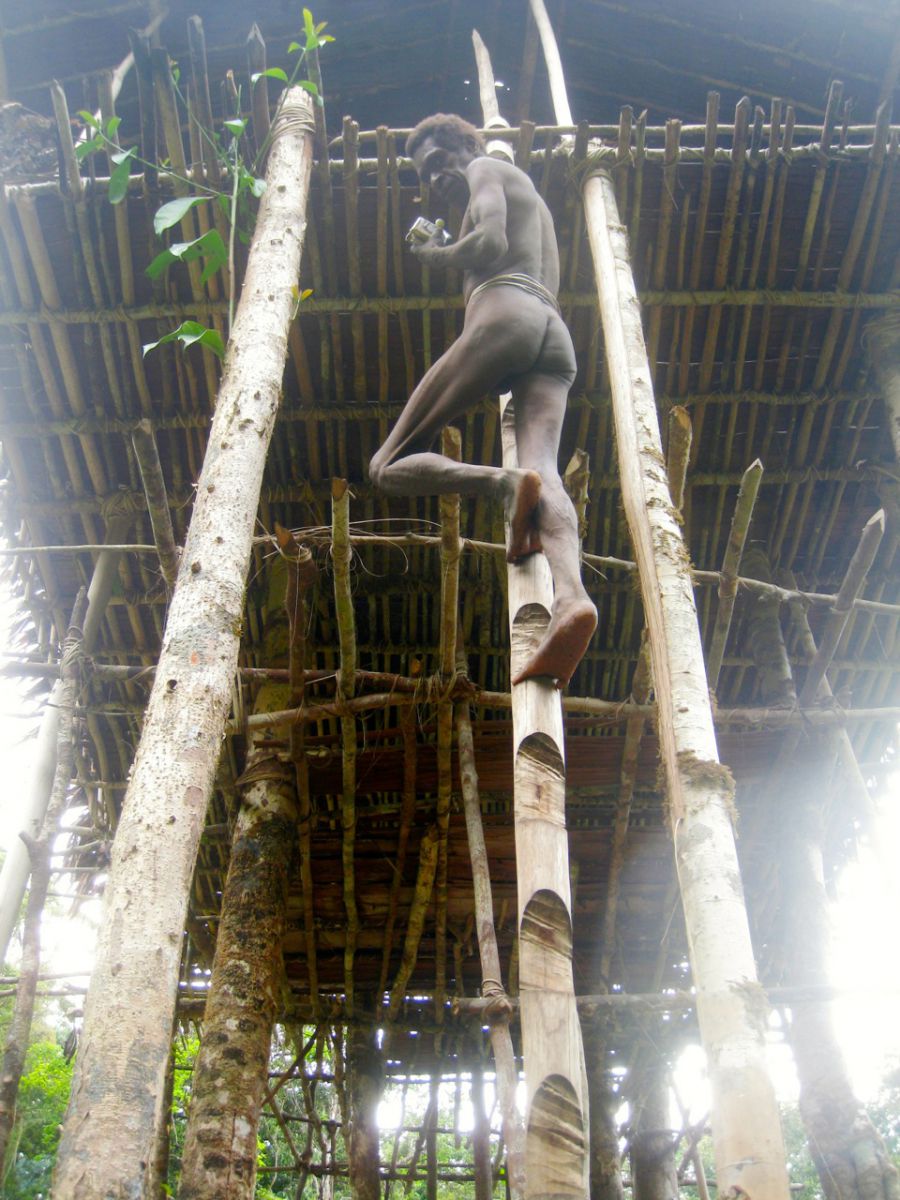
The house turned out to be spacious and draughty. In the center of the house there was a fire place. To our astonishment we saw a little feeble dog. How did it come to be here – we were about to find out.
.jpg)
When we got cosy under the shelter twisted with bones of the people eaten before… we learnt that they did not remember their grandparents, they gave names of flowers to their children, they… ate their baby boys while a man was able to perform his reproductive function, they did not know their age, they had no connections, had no written language, and they could not count.
It is astonishing to know that the Korowai people use their ancestors’ skulls as pillows in their dwellings. They believe that there is a spirit there and it helps them to become smarter.
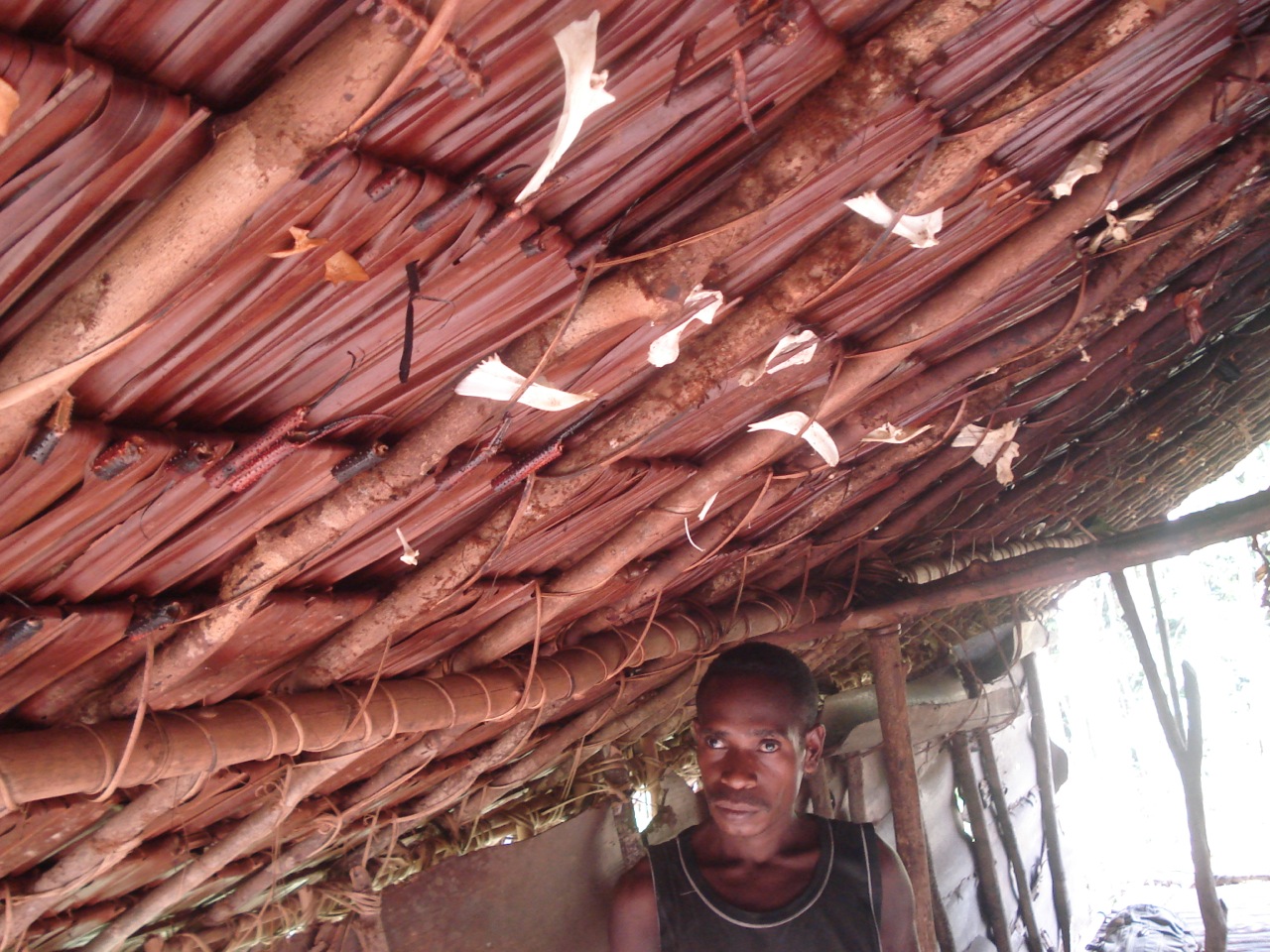
They believe in devil and don’t know any good spirits. The community is protected with the bones thrown about and other tribes know who and how worships devil. When the time is rough they ask devil to preserve their lives. We remembered that on our way to the tribe’s habitat one of the carriers didn’t want to go to this place as he saw the devil’s path and he just went away.
They think there is no eternal life. After death the Korowai people just vanish and nothing happens. They believe there are 4 worlds: the first is the world of the family, the second is the world of the jungle, the third is the world of big water (apparently they once reached the coast) and the fourth is the world of the dead where… WE came from! at the same time pointing at us and at the Moon. Everything is like Mikloukho-Macklay described: they are the people from the jungle and we are the people from the Moon.
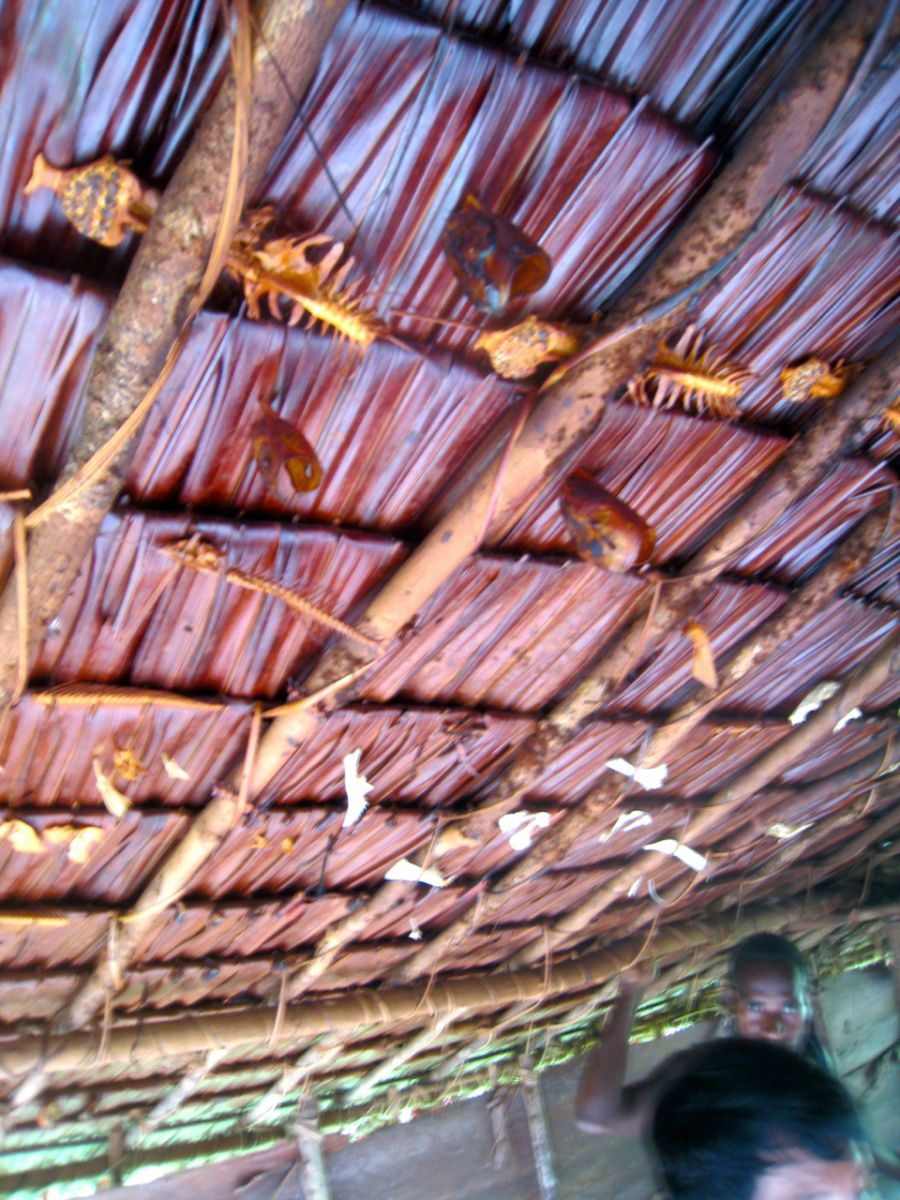
In the dwelling from the top our camp looked somehow unsafe… But we didn’t dare to stay at the Korowais’ for the night!
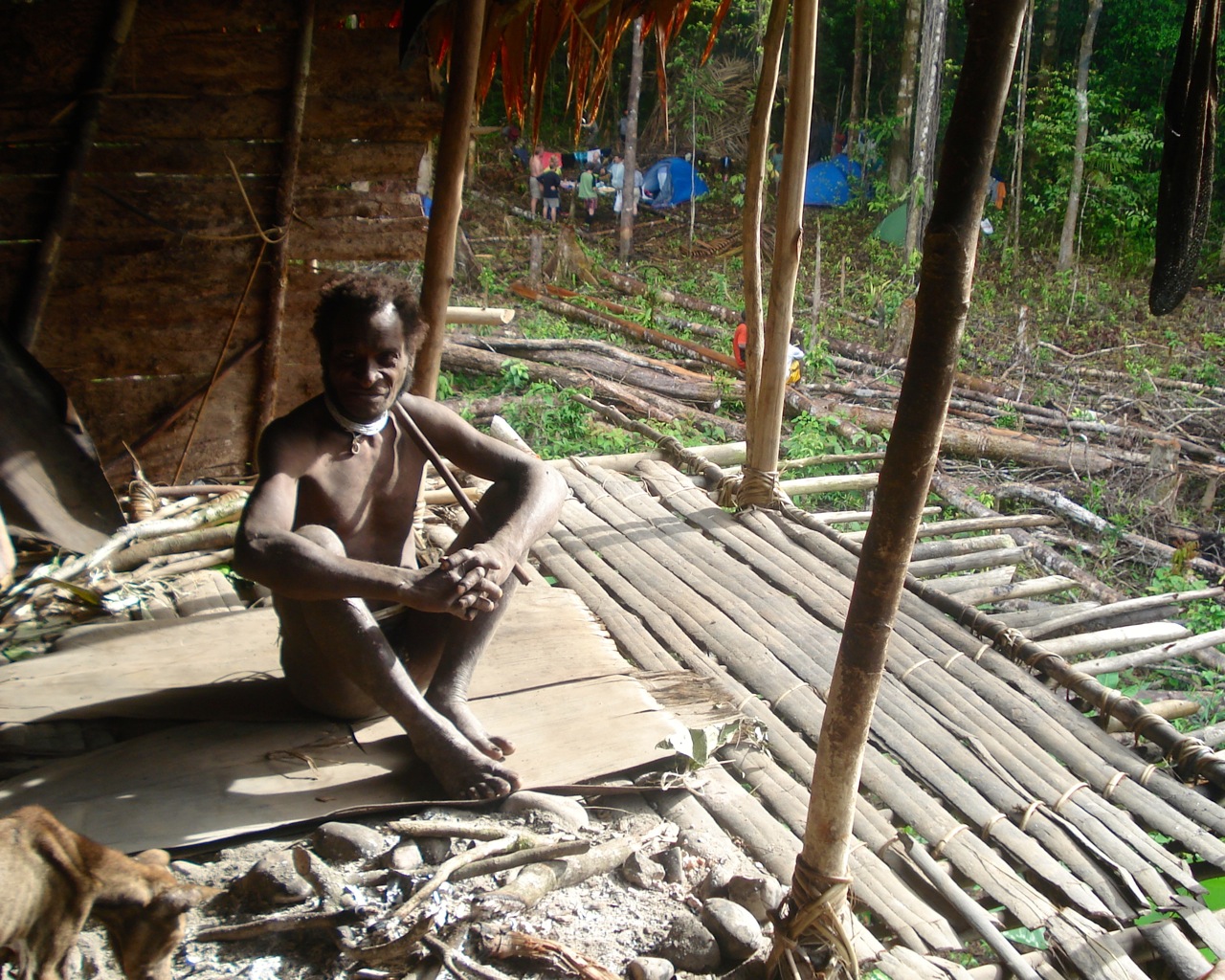
It was not dark yet and the sun was just about to set, but we couldn’t see anything in the jungle, and the hordes of insects and reptiles inhabiting the jungle were getting ready for… the night hunting!
Having spent the night we got under way. In the end one of the tribesmen gave me a present - a walnut shell to cover the penis. I took it but I haven’t tried it on yet, it is hanging on the wall next to the penis gourds of the Lani and the Dani tribes reminding of the fact that they are aboriginal and the Korowai people are even pre-aboriginal. But look how hospitable they are: they didn’t eat us but endowed us with presents!
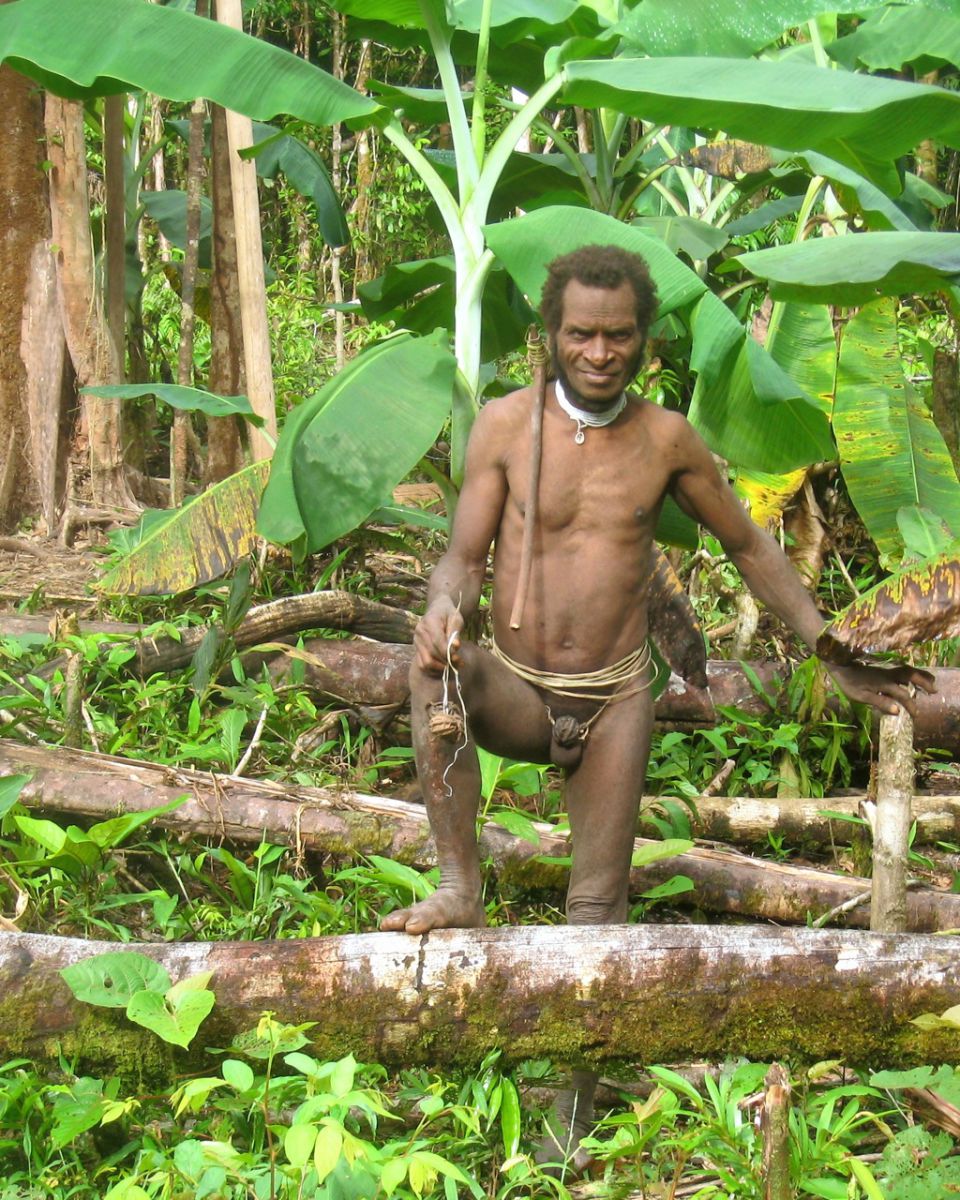
Again the jungle, passages and the possibility of being captured or bitten and
.jpg)
the new tribe where our Anton was born and bred. A group of the Papuans with bows and arrows suddenly ran out of the dense jungle when we were completely exhausted. Anton told them some thing in their language. After that the Korowai men lowered their bows and we breathed freely.
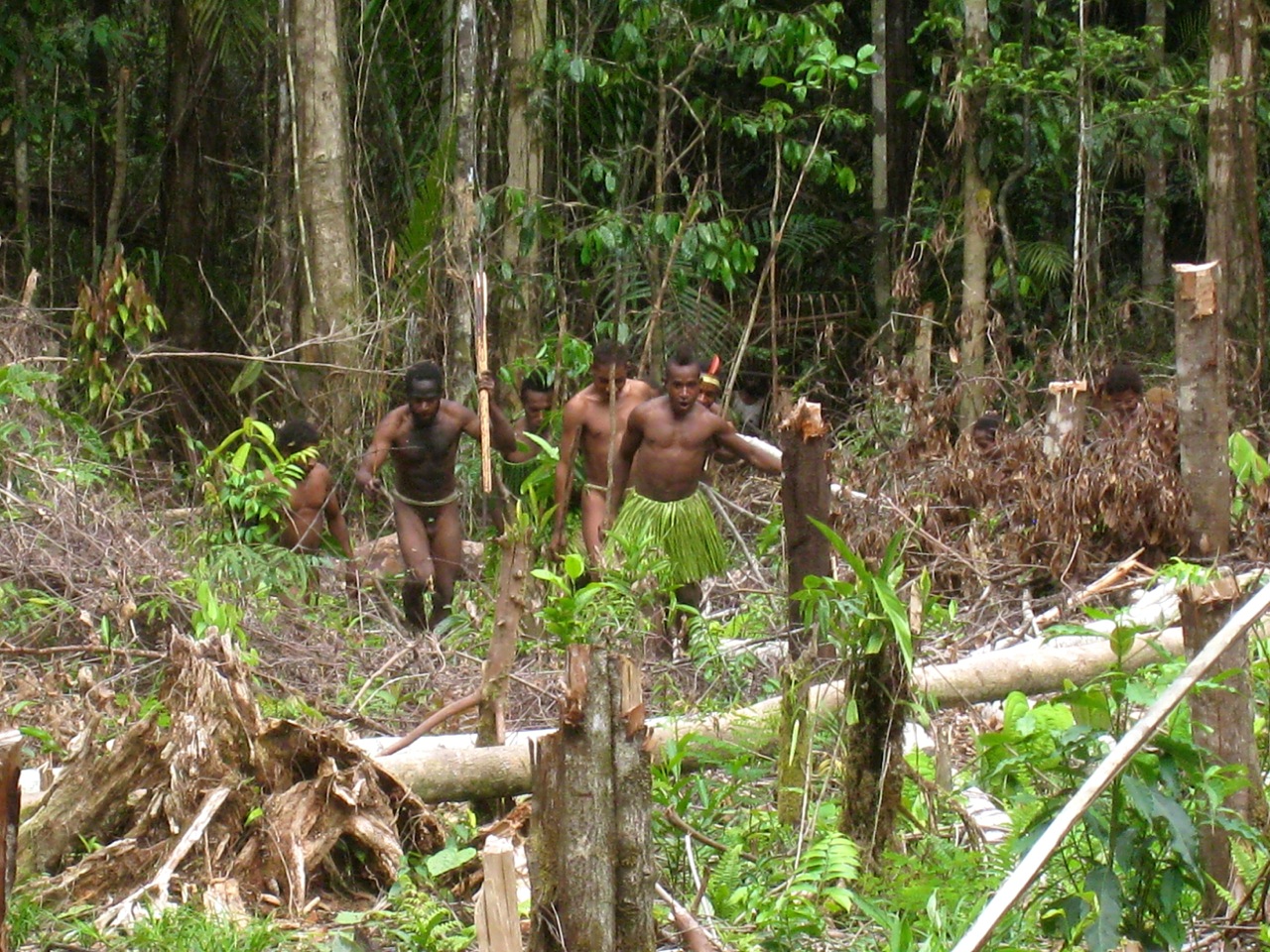
The houses in this tribe are really at a height of more than 50 meters!
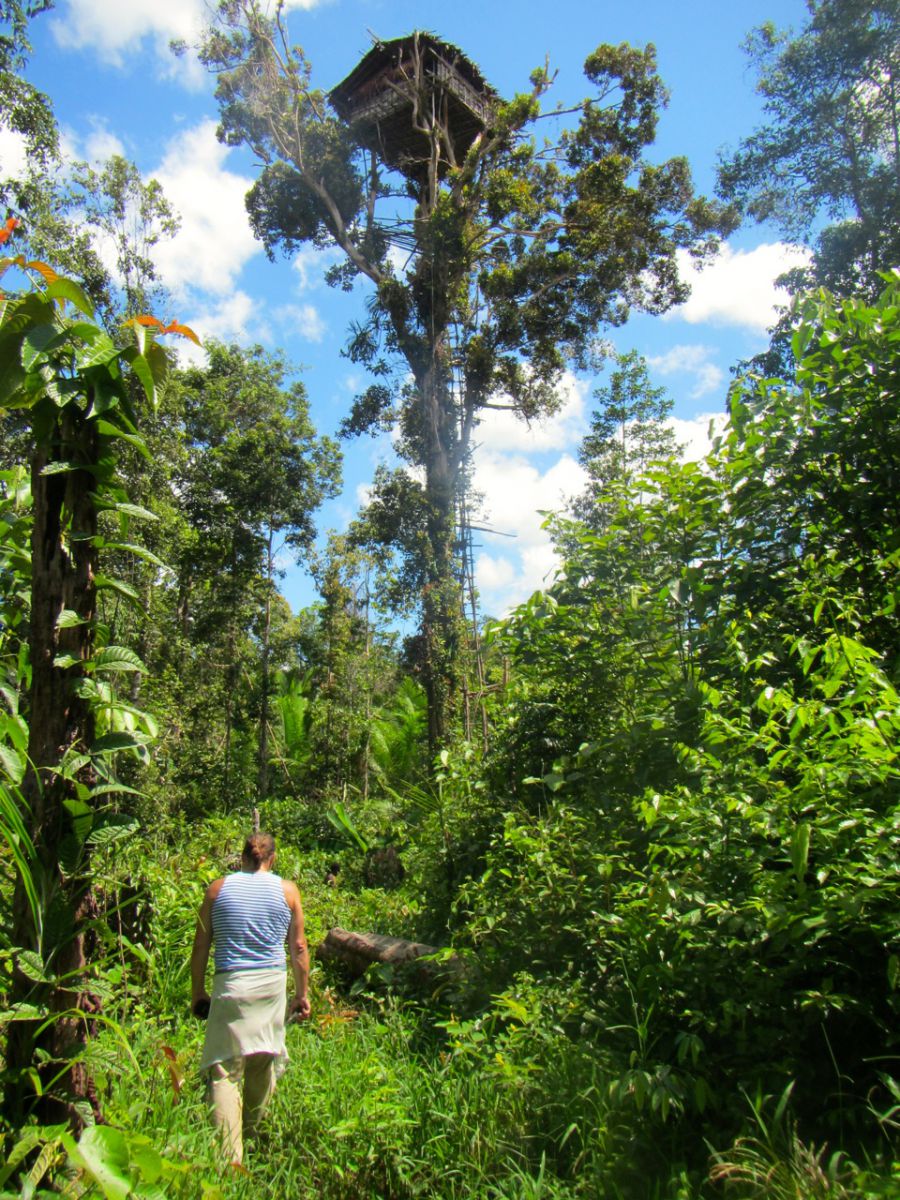
They are not tall as well but very withy and quick. They did not understand what was going on when we were taking photos with them though they did not lose confidence – they were at home and they did not care if they did not recognize themselves on the screen of our cameras…
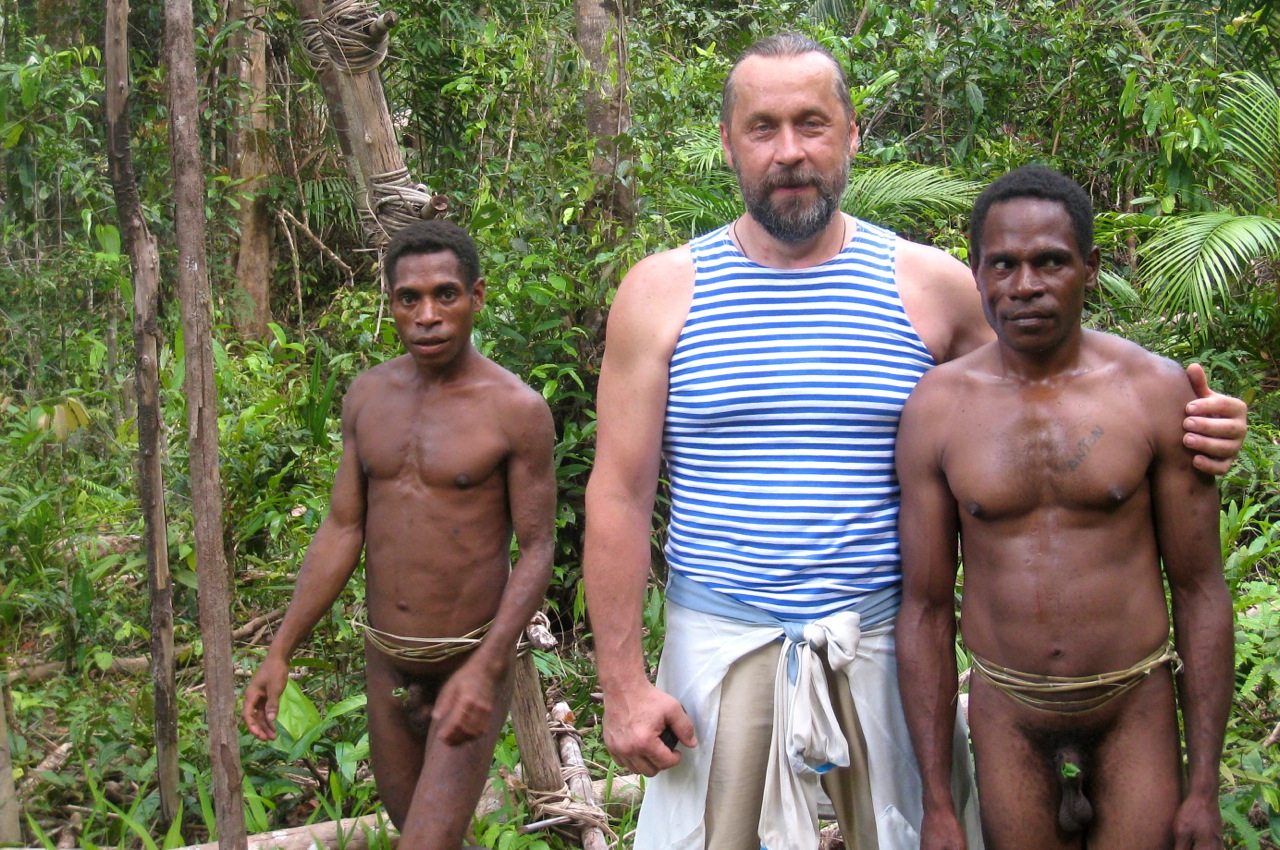
The Korowai met us in a friendly way thanks to Anton who they had not seen for many years.
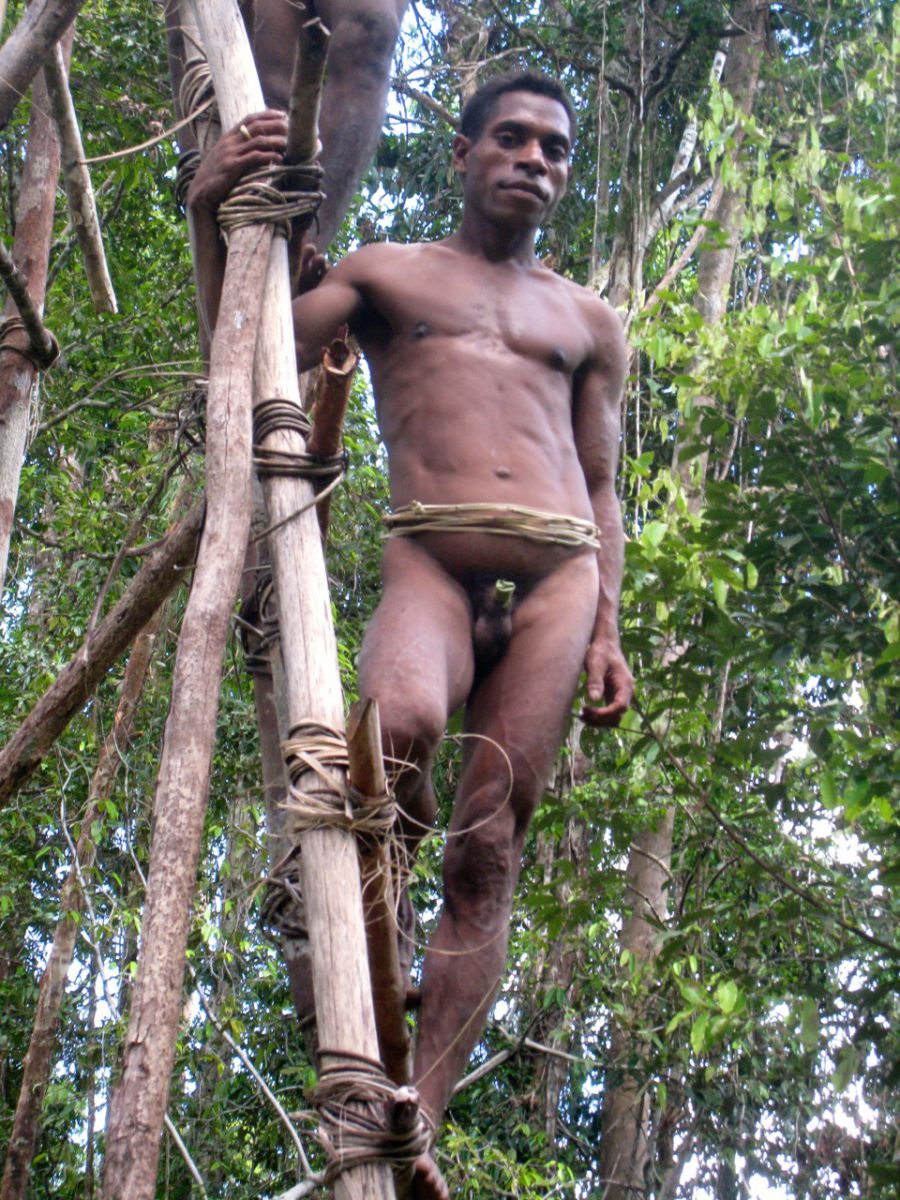
Despite all the pressing invitations to go upstairs inside the house we politely refused keeping in mind that it could come to no good. After all we live in the game of constant doubts and contradictions – yes/no, need to do/do not need to do, good/bad. The Korowai people do not have evil and good spirits, hell or heaven as well as notions of love and hatred. Hardly had he said it when he began doing it – climbing up the perches which cracked under his little feet… No, it was not worth doing. Even though we didn’t accept the invitation we kept a whole skin and yet we had so much interesting to see.
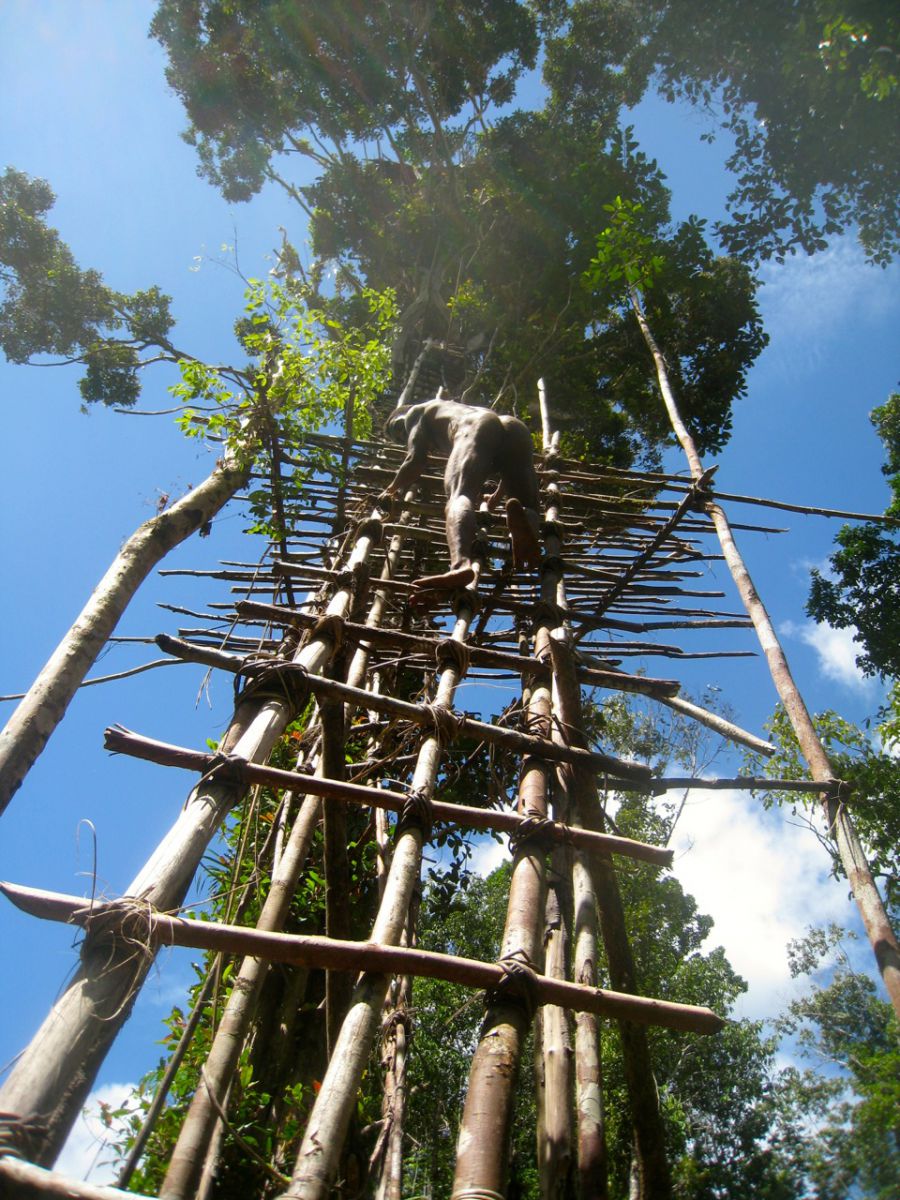
I asked a singing Papuan a question: “Who do you worship?” He answered that he worshiped an evil spirit and asked him to keep his hands off us and his friends who were walking through the jungle. I asked: “Is there a good spirit?” He answered: “Who’s that?”
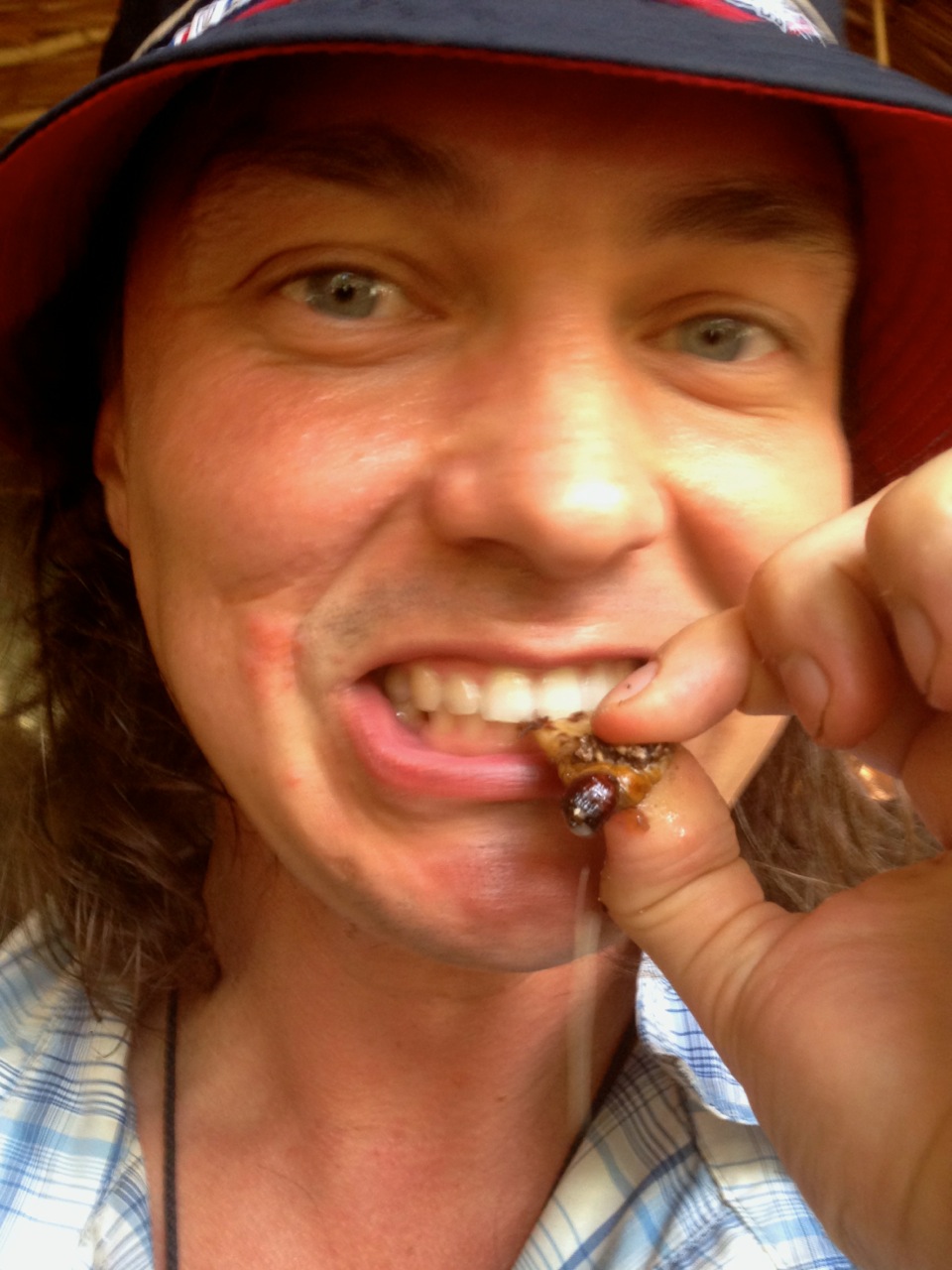
More information on where we were going to live, how we were going to get food and eat it without getting poisoned just… in a week.
To read and watch the previously published material:
One of the cities obligatory for visiting on the way to the Papuans – Jakarta
New York is the city of contrasts! But I haven’t been to New York, I’ve been to... Wamena
Living with cannibals has turned out to be possible… if there’s a will!
Thus, singing songs and having trust in everyone who can help us and with great optimism we moved on – to meet the even more remote tribe!
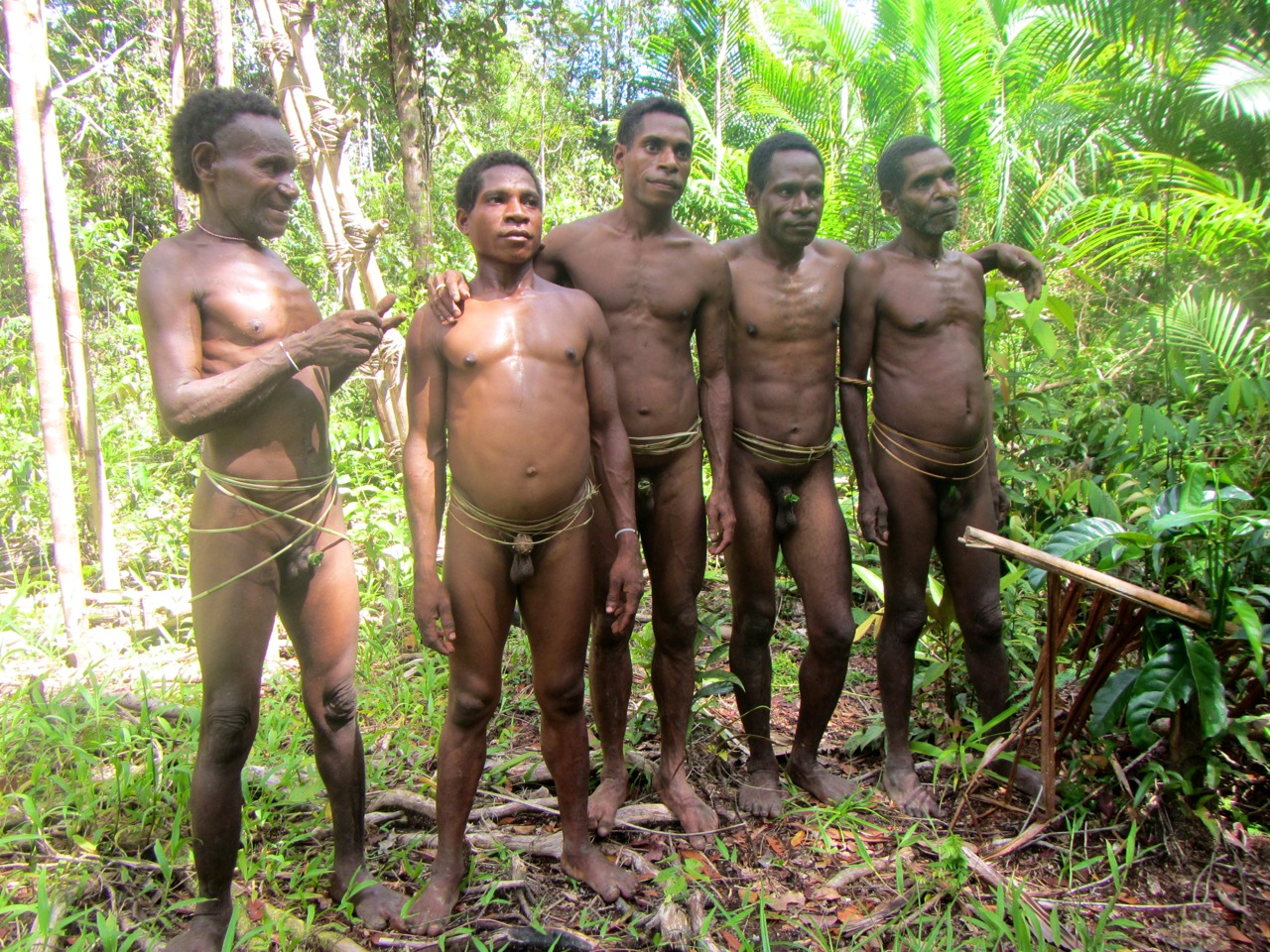

The Olympus of style is still held by the magic of original ornaments, bright colors, animal prints, fantastic accessories and massive adornments.
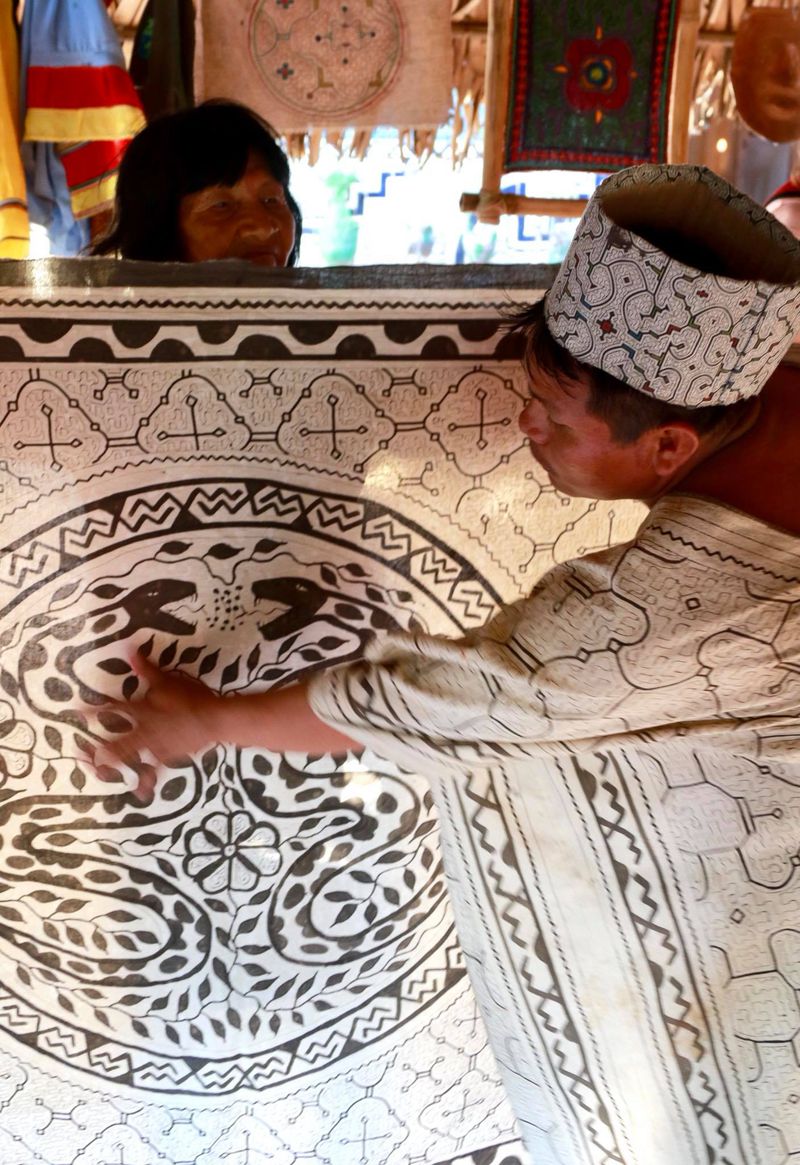
Вот уж чего в любой экспедиции должно быть с избытком, так это чая и юмора (как вариант, сойдет кофе и хорошее расположение духа). Но, горячая кружка ароматного чая творит чудеса, особенно за вечерними посиделками и разговорами об увиденном, пережитом и затронувшем.
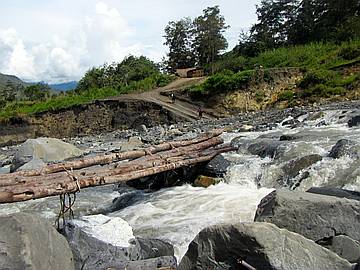
The only one of the three places on the planet covered with snow on the equator is Mount Irian Jaya. Along with other mountains it seizes the Baliem valley around the perimeter while I’m seized with the feeling of being carried to the primeval world...
 I am aware, colleagues, that here we "treat" metaphysically, and not a specific patient, so the text sins universality, but - as a guide - will help us to treat consciously, in accordance with the stages of inflammation and focusing on the observed phenomena. Read more...
I am aware, colleagues, that here we "treat" metaphysically, and not a specific patient, so the text sins universality, but - as a guide - will help us to treat consciously, in accordance with the stages of inflammation and focusing on the observed phenomena. Read more...